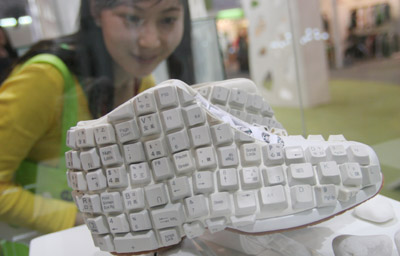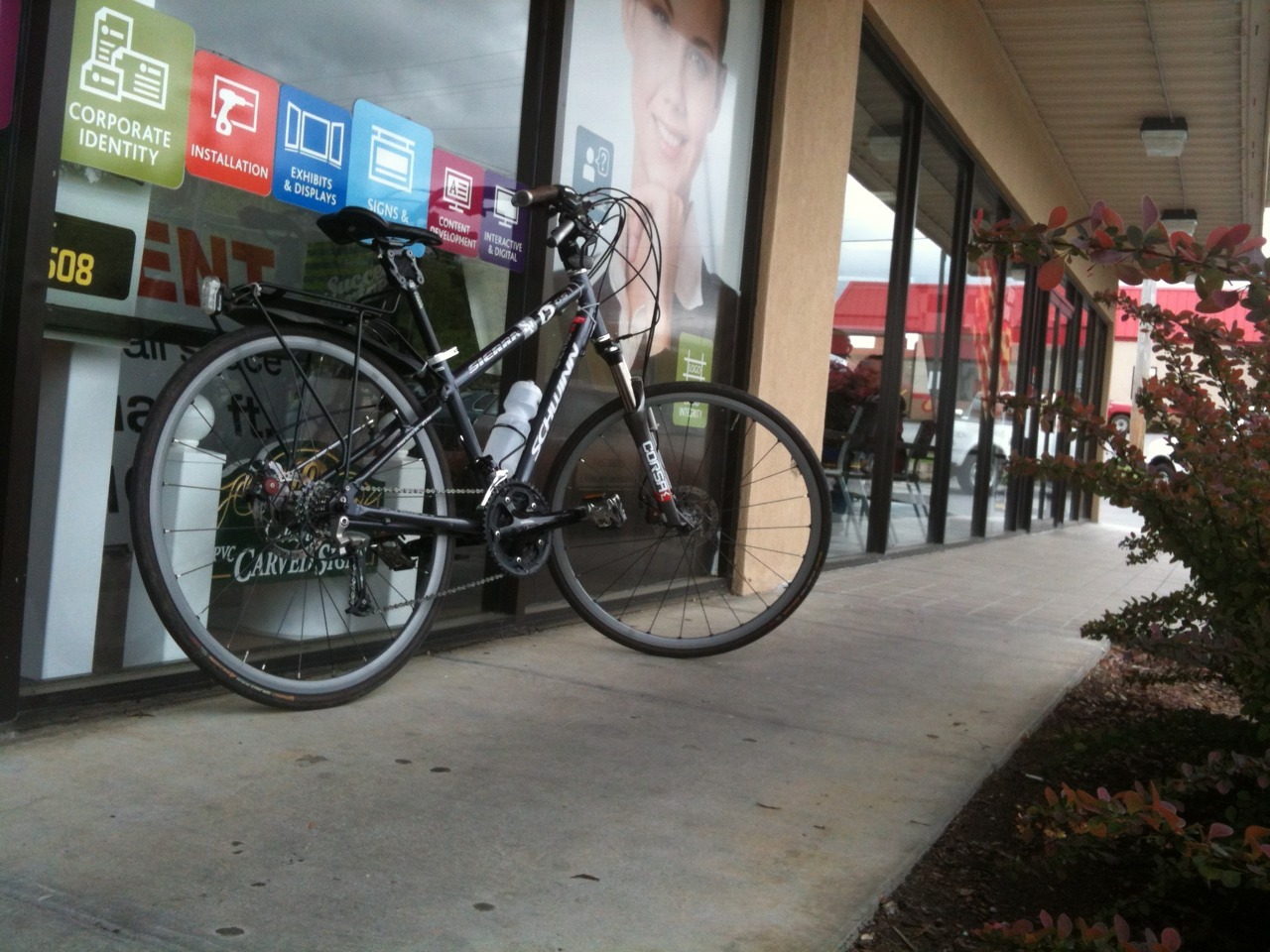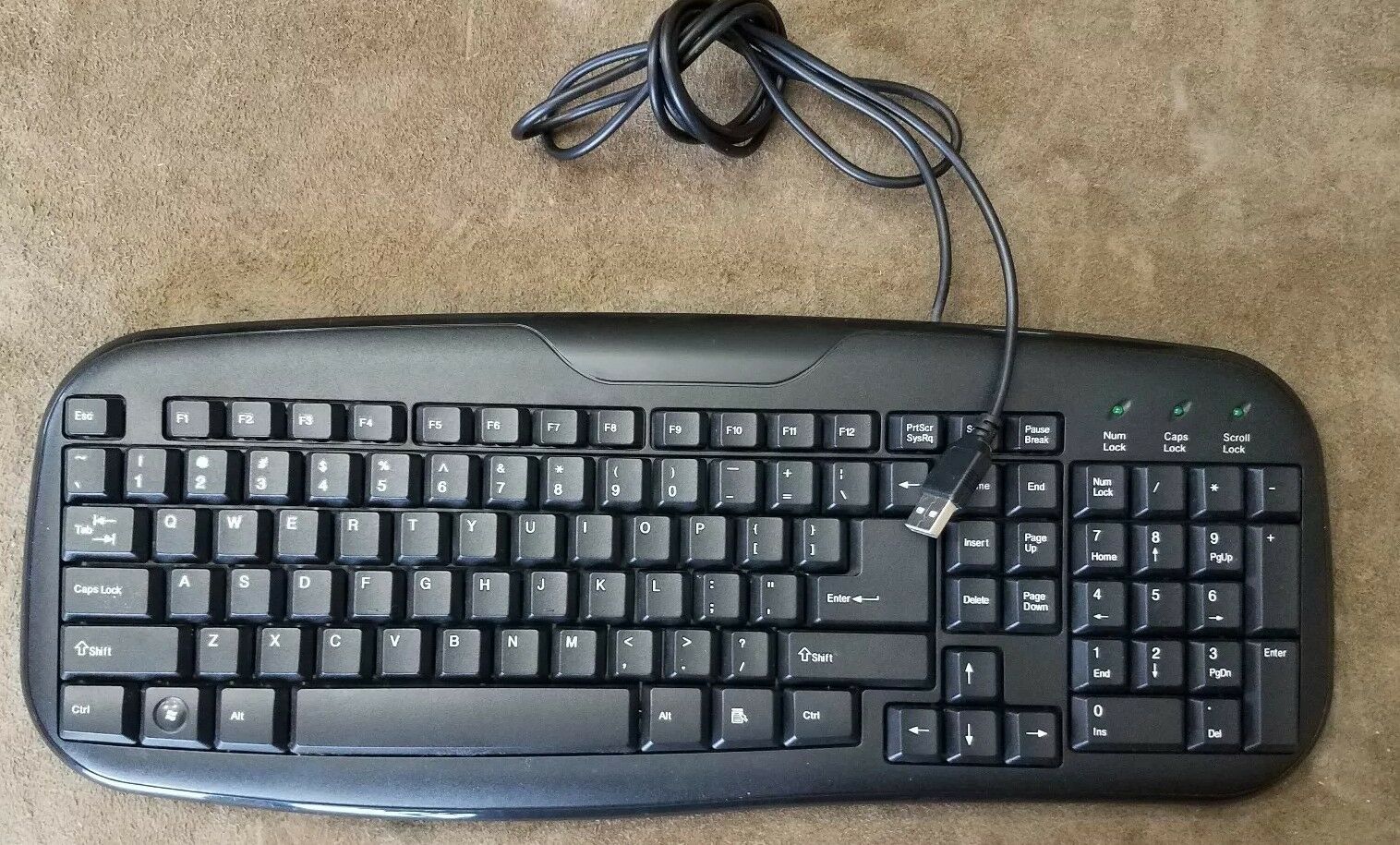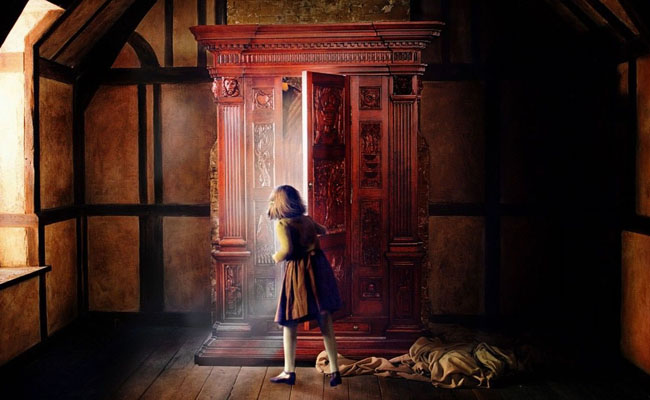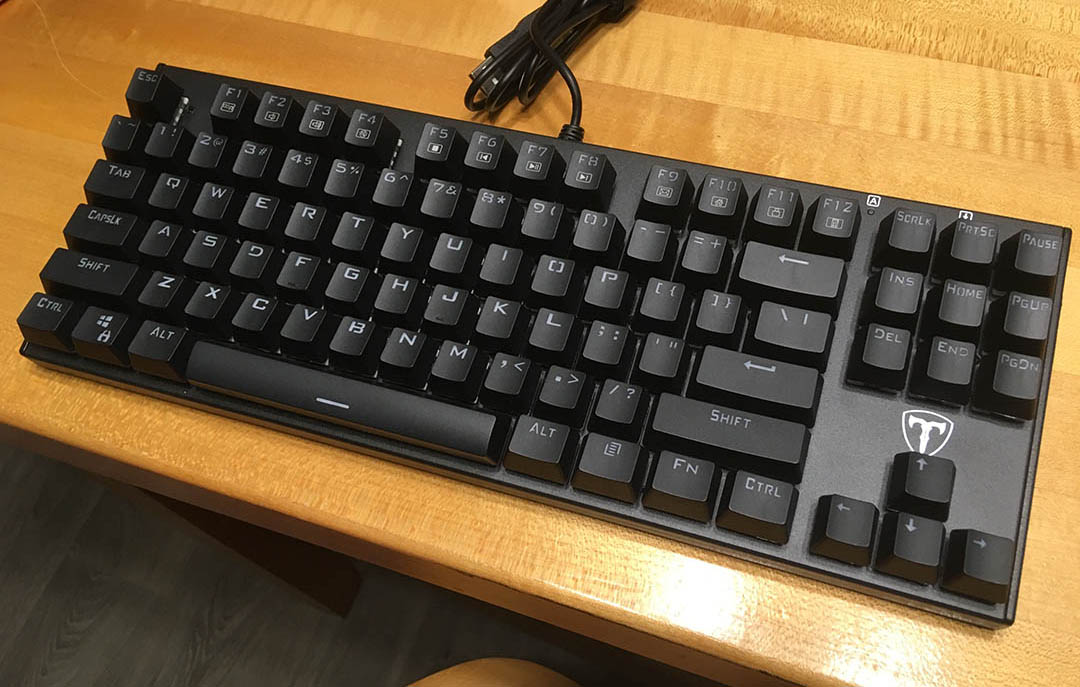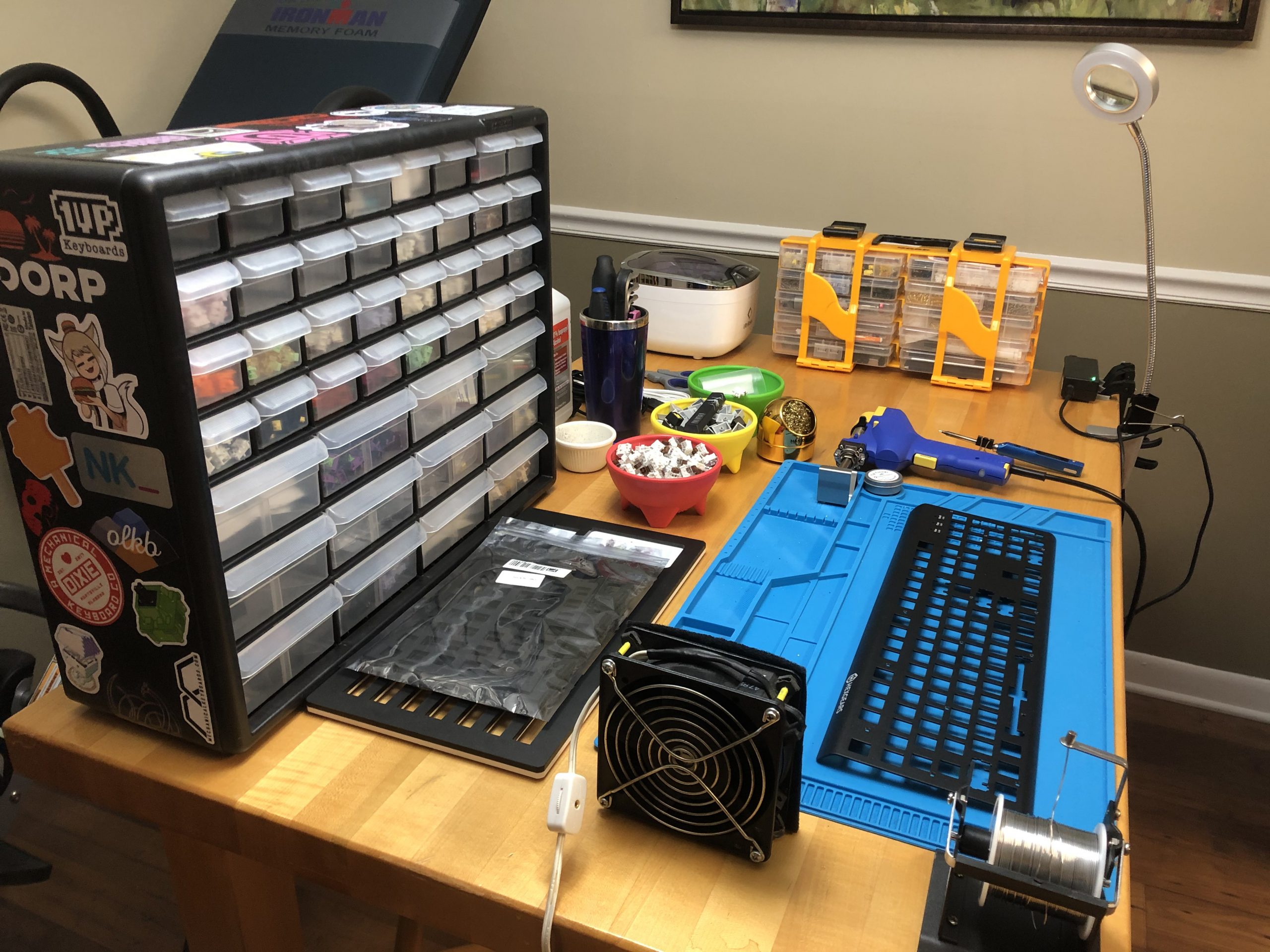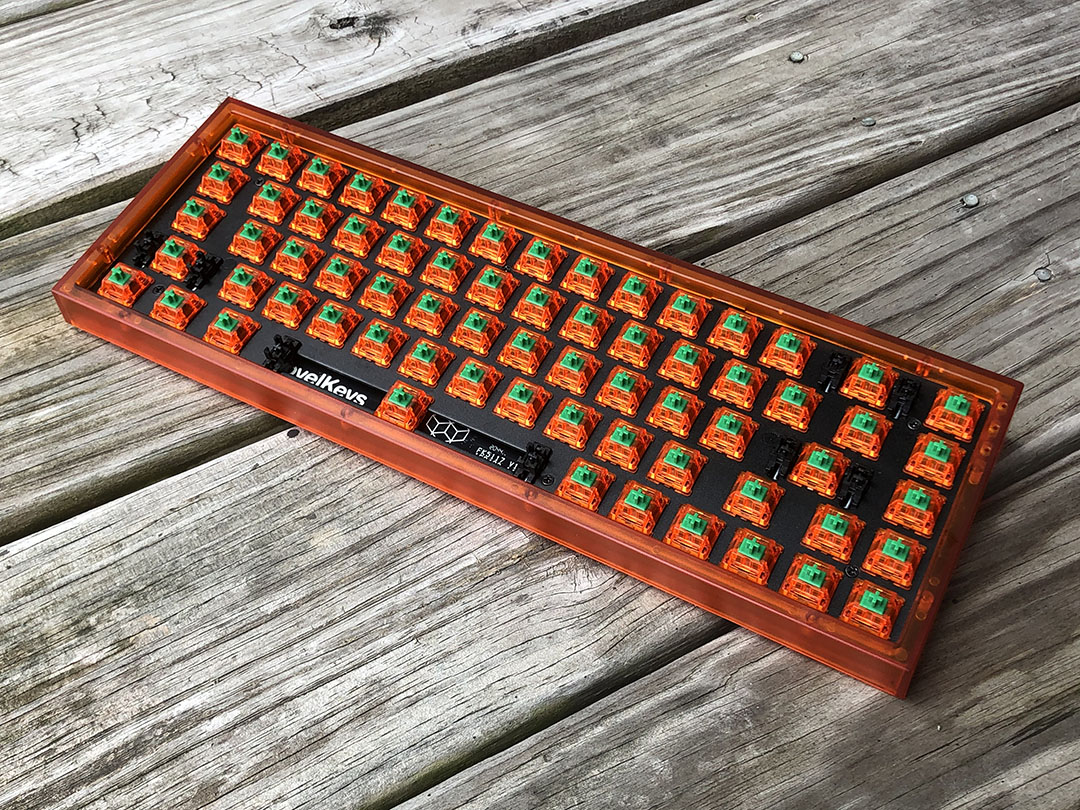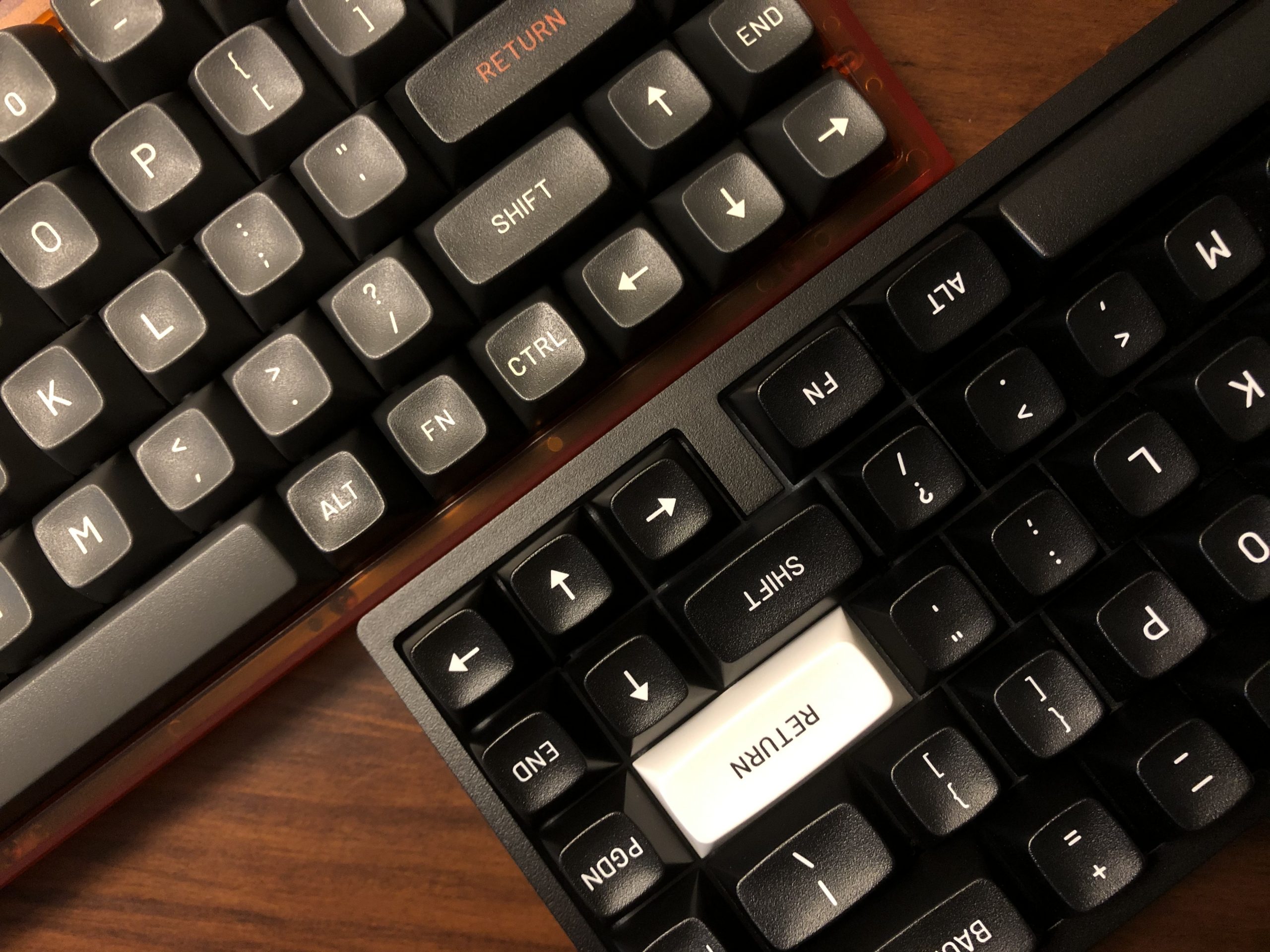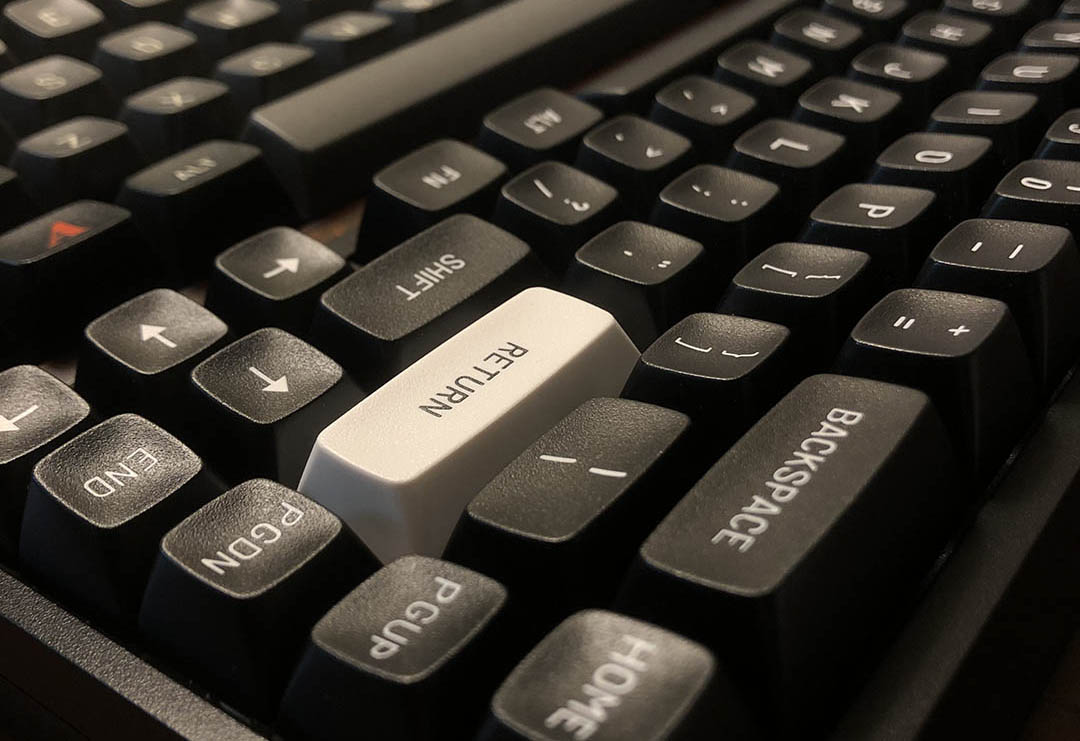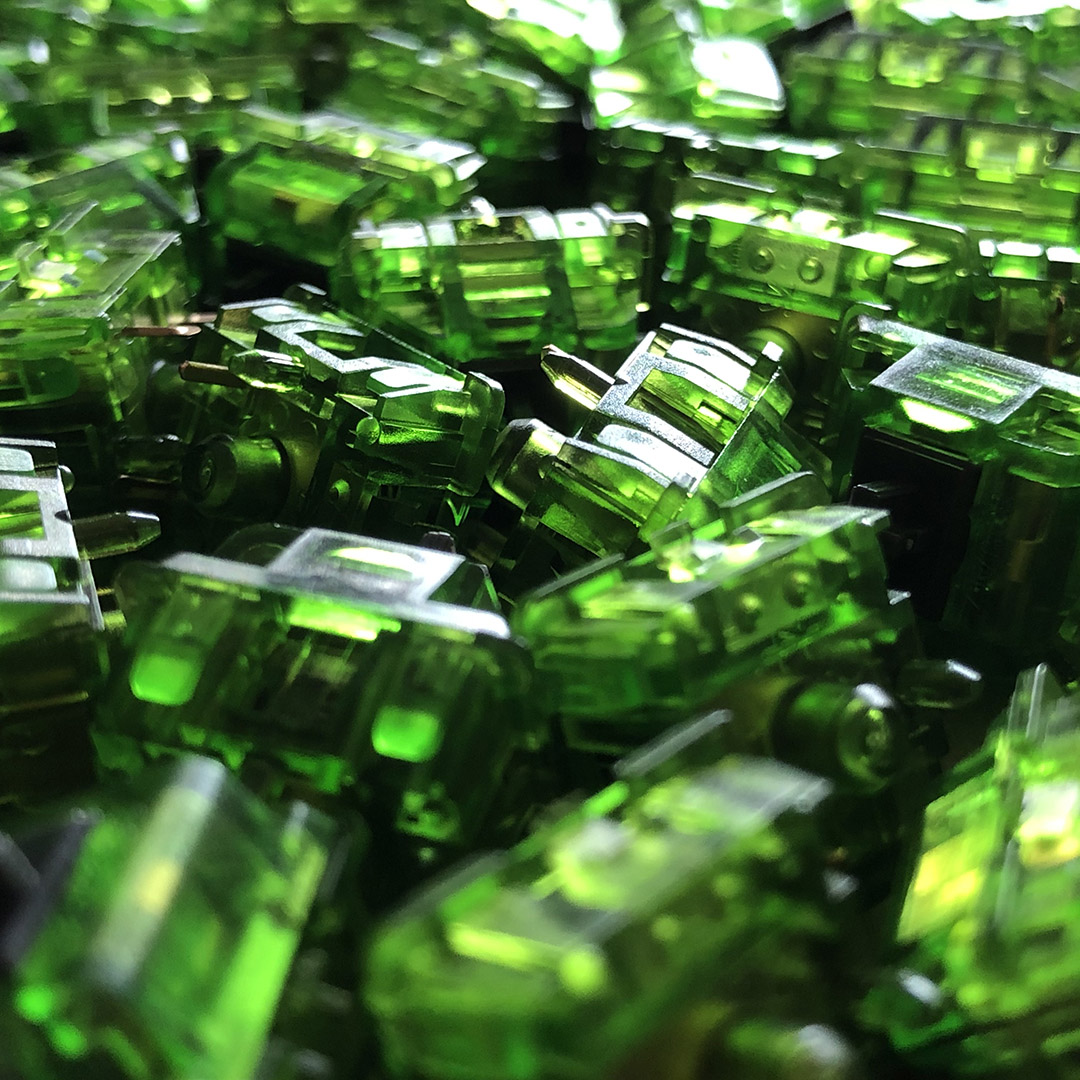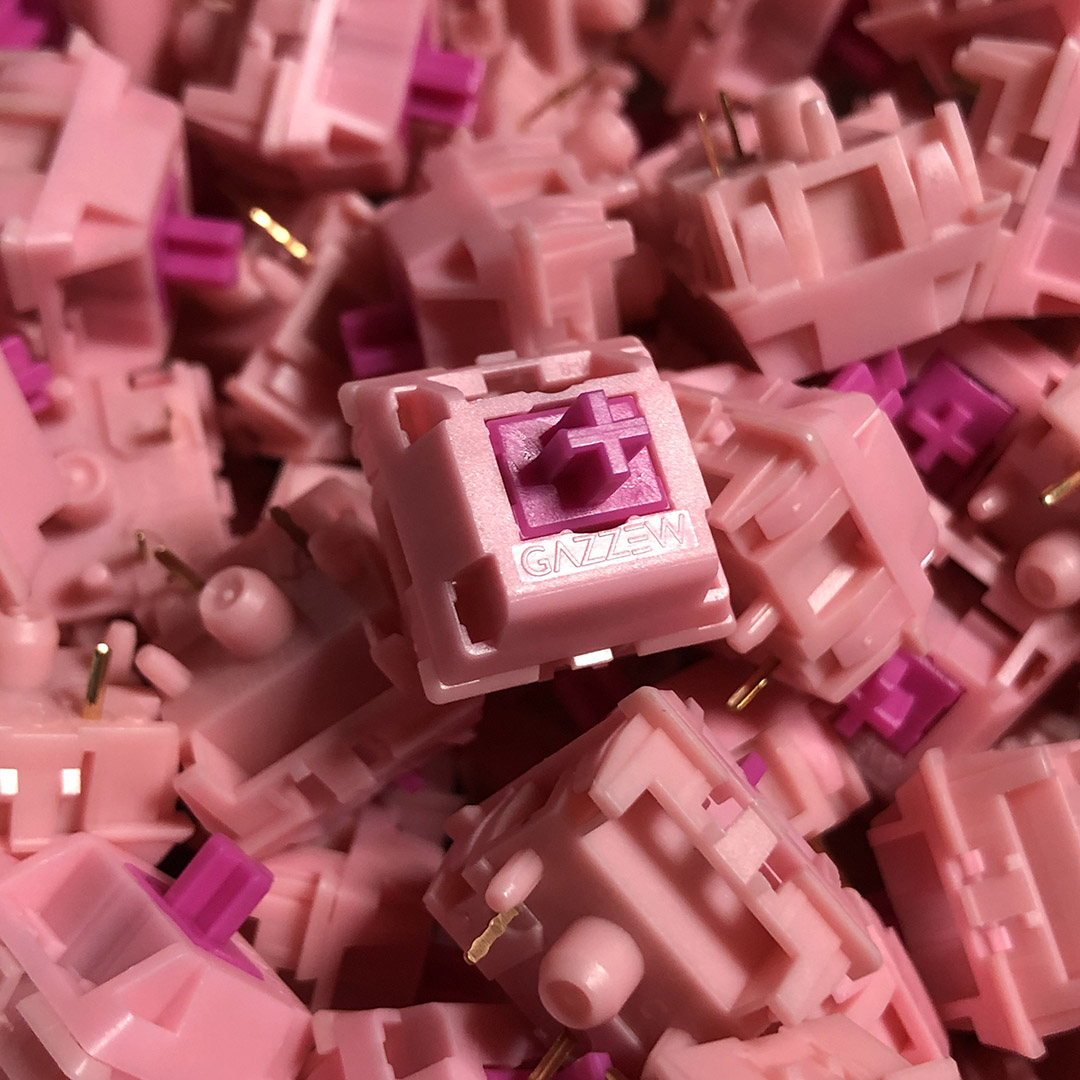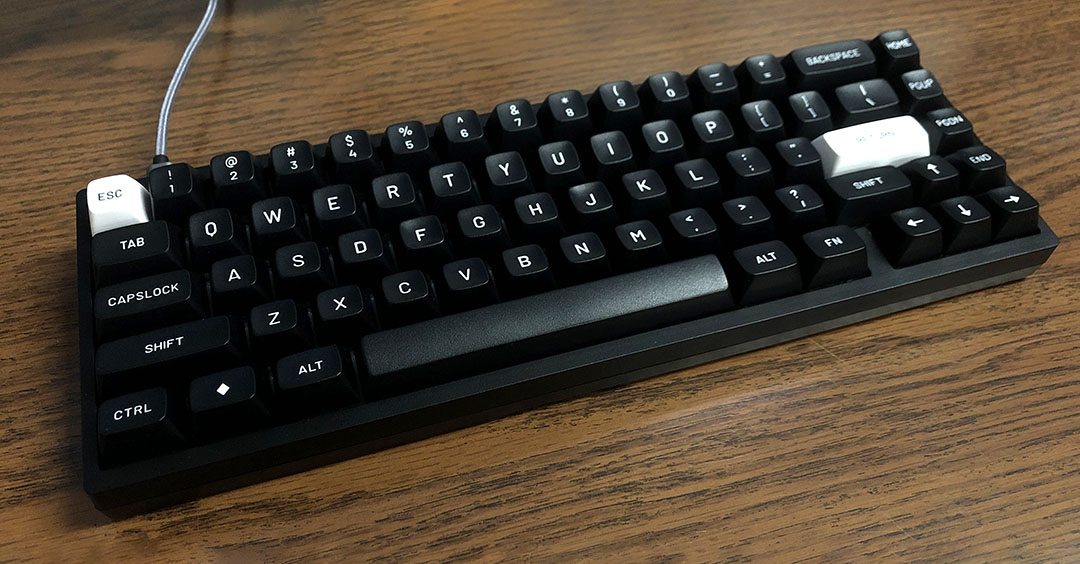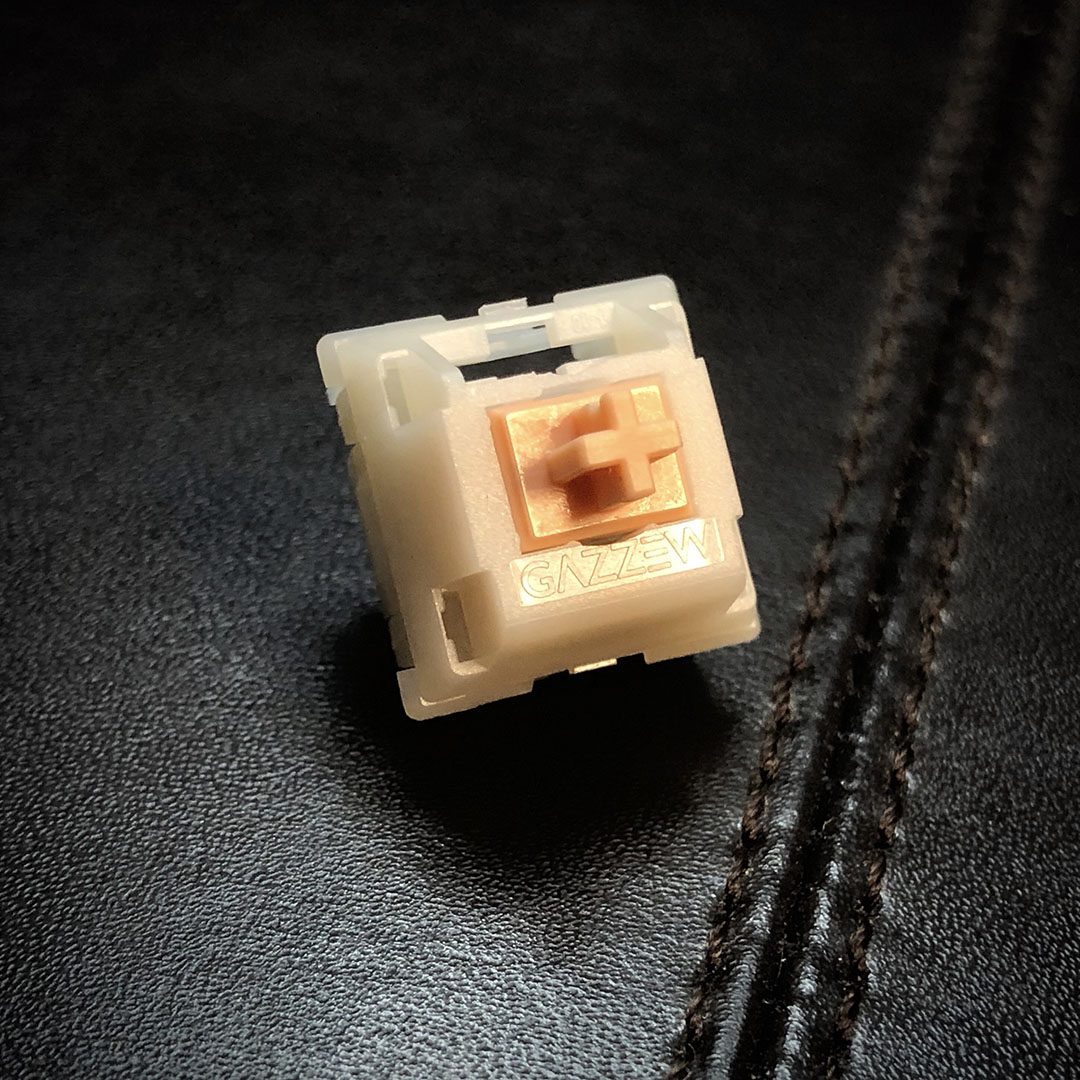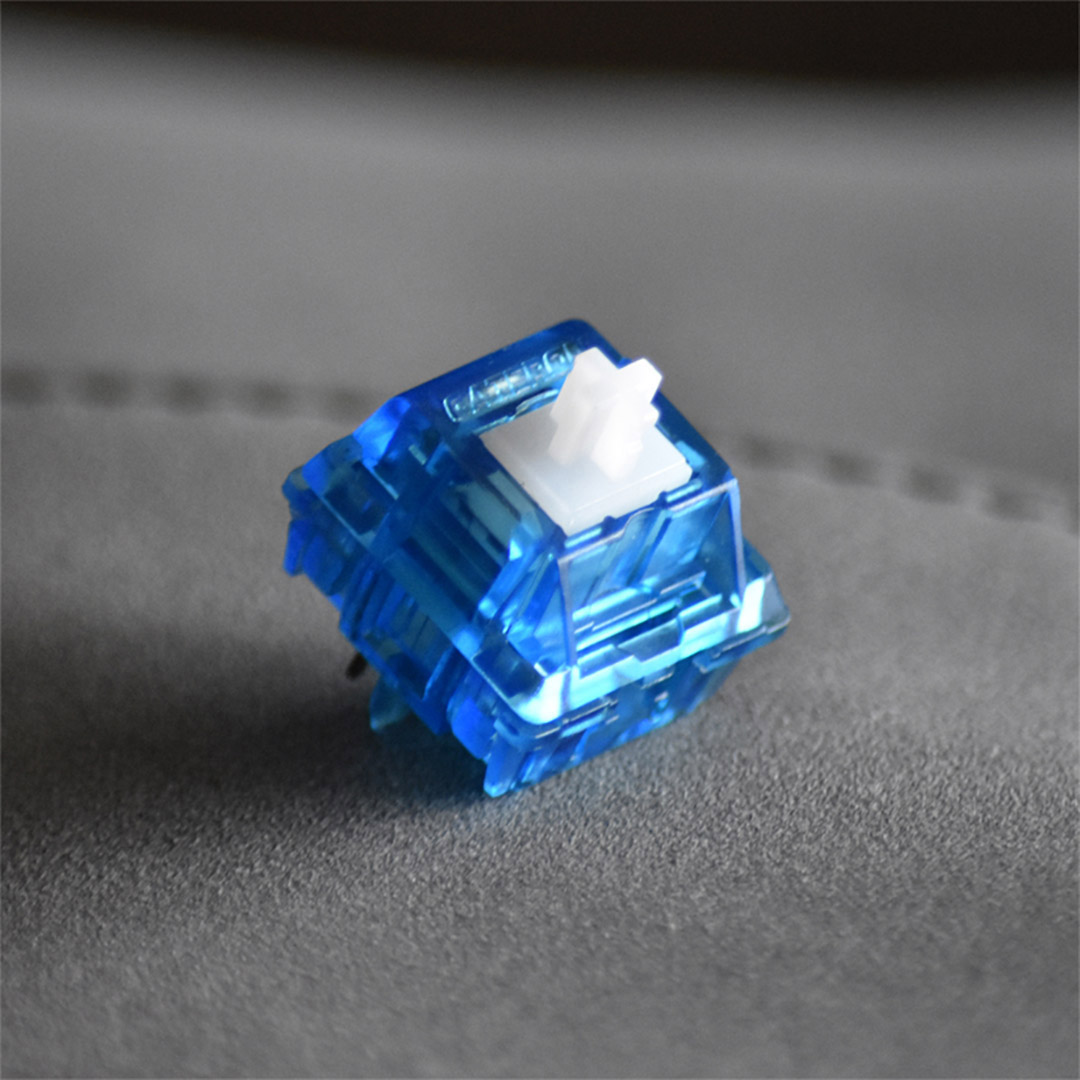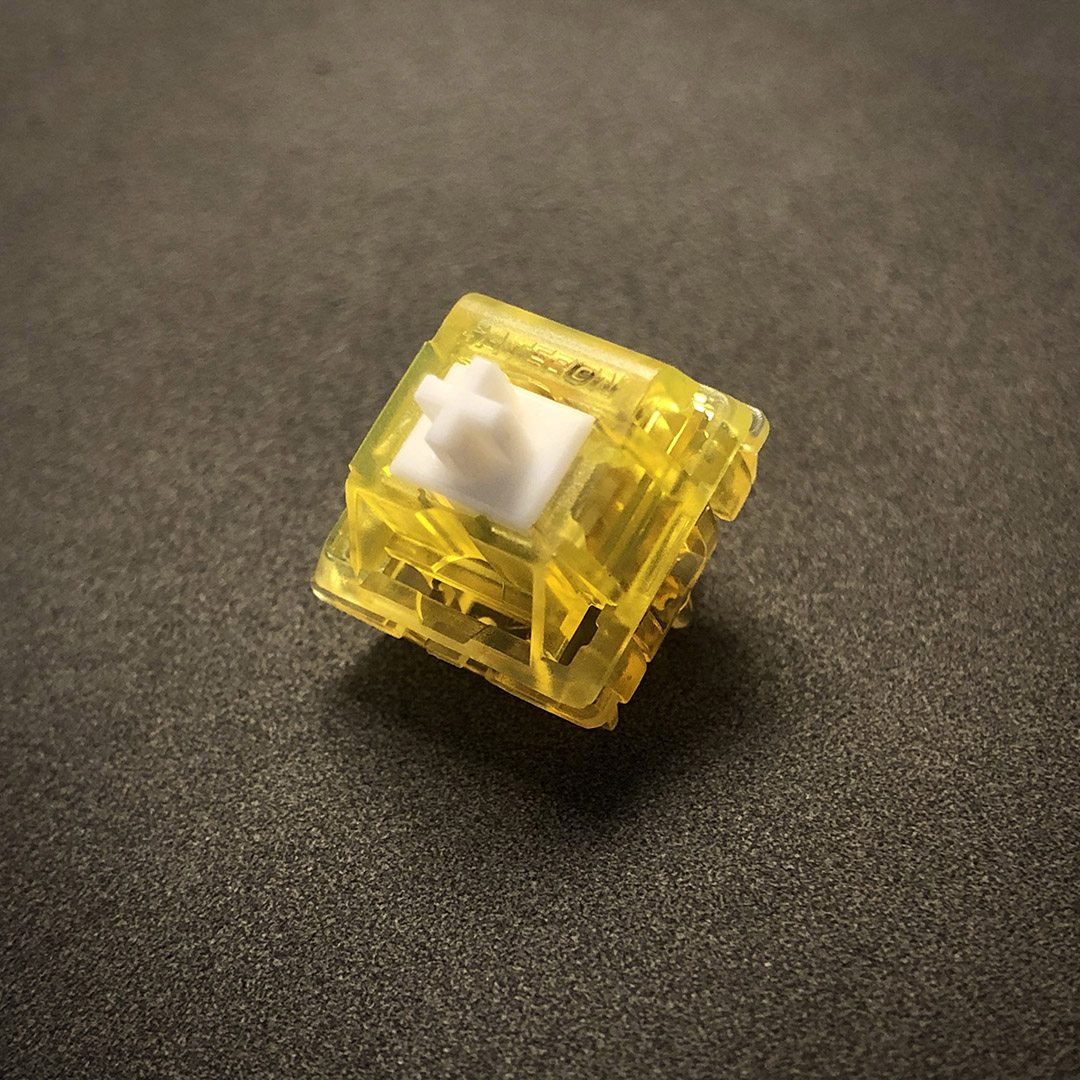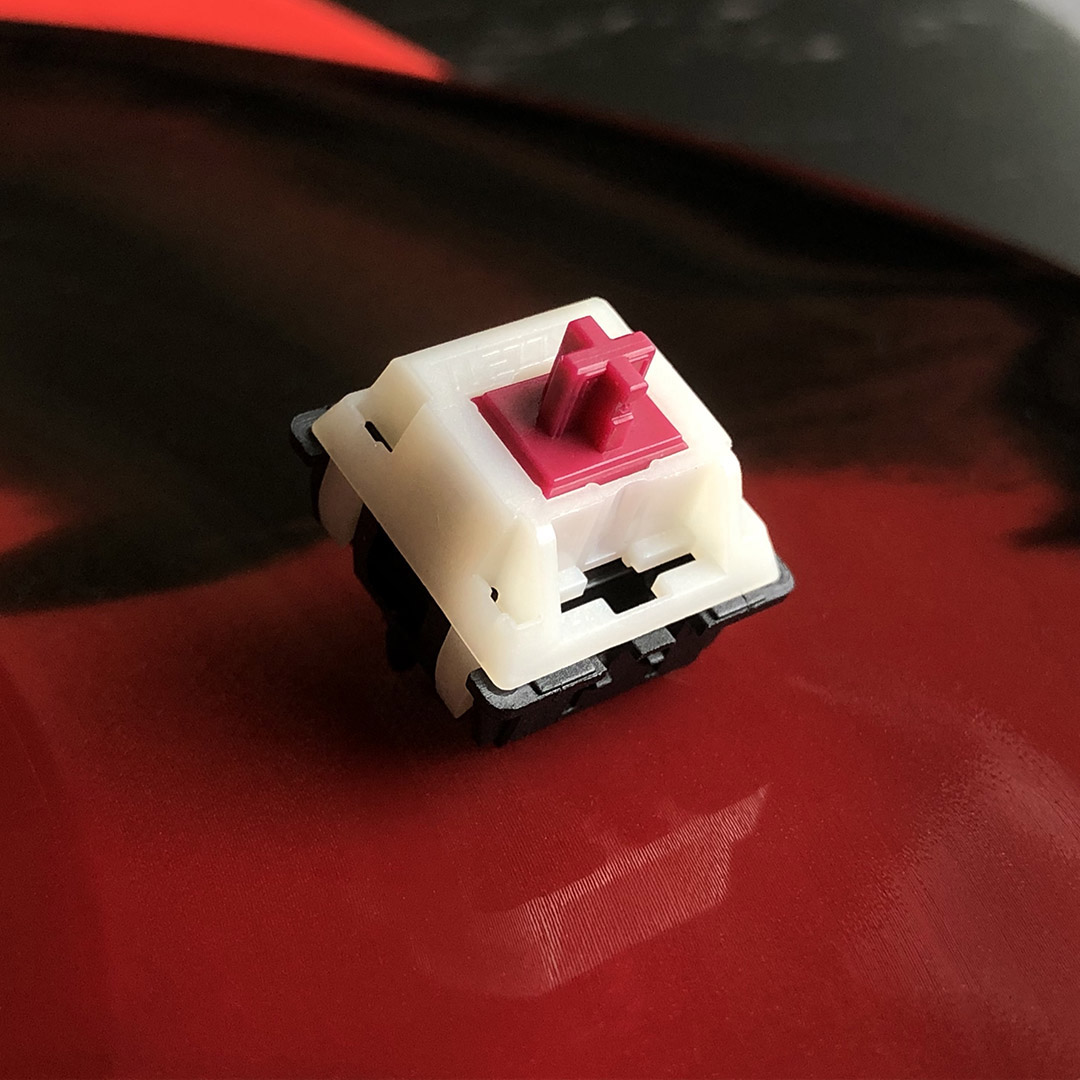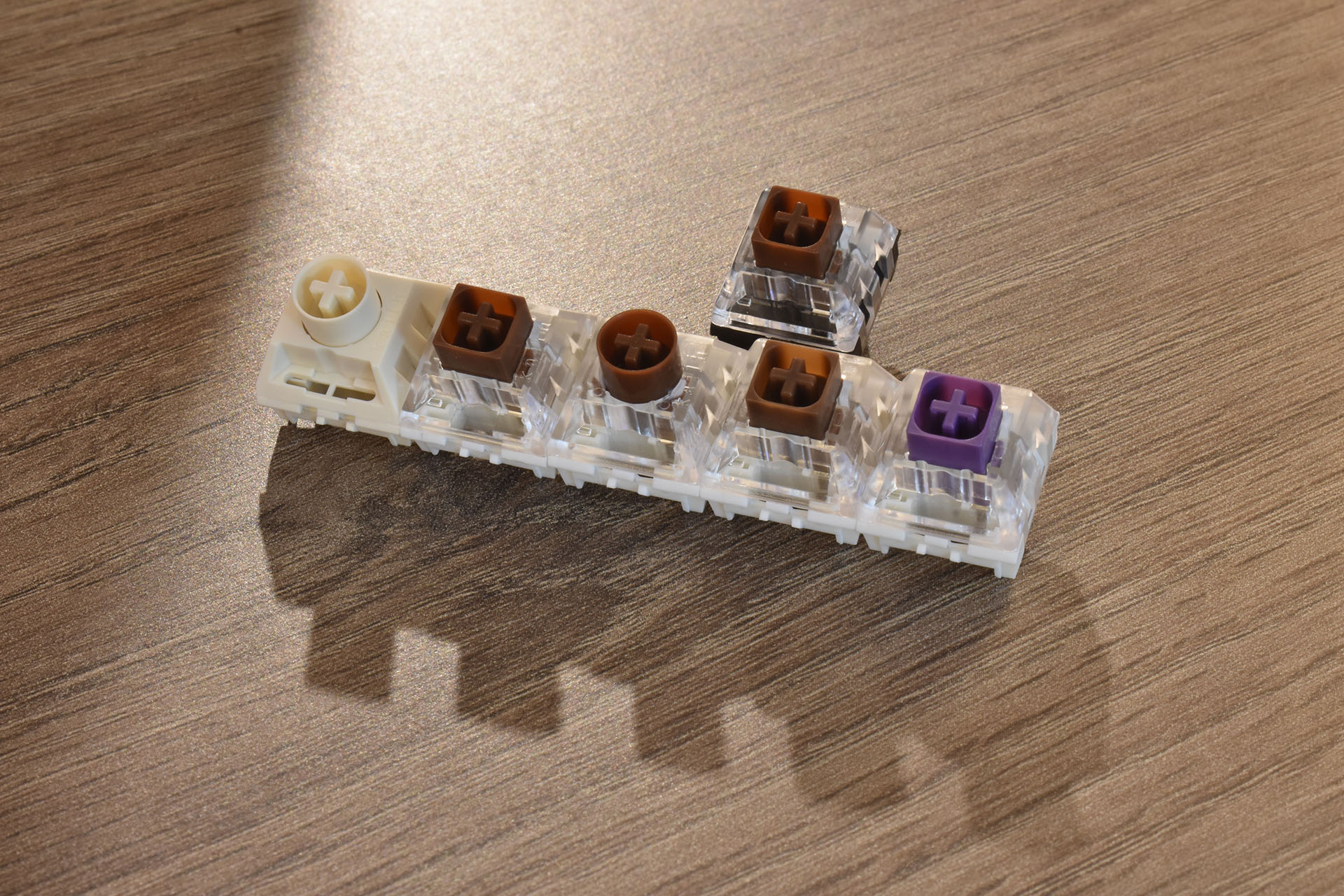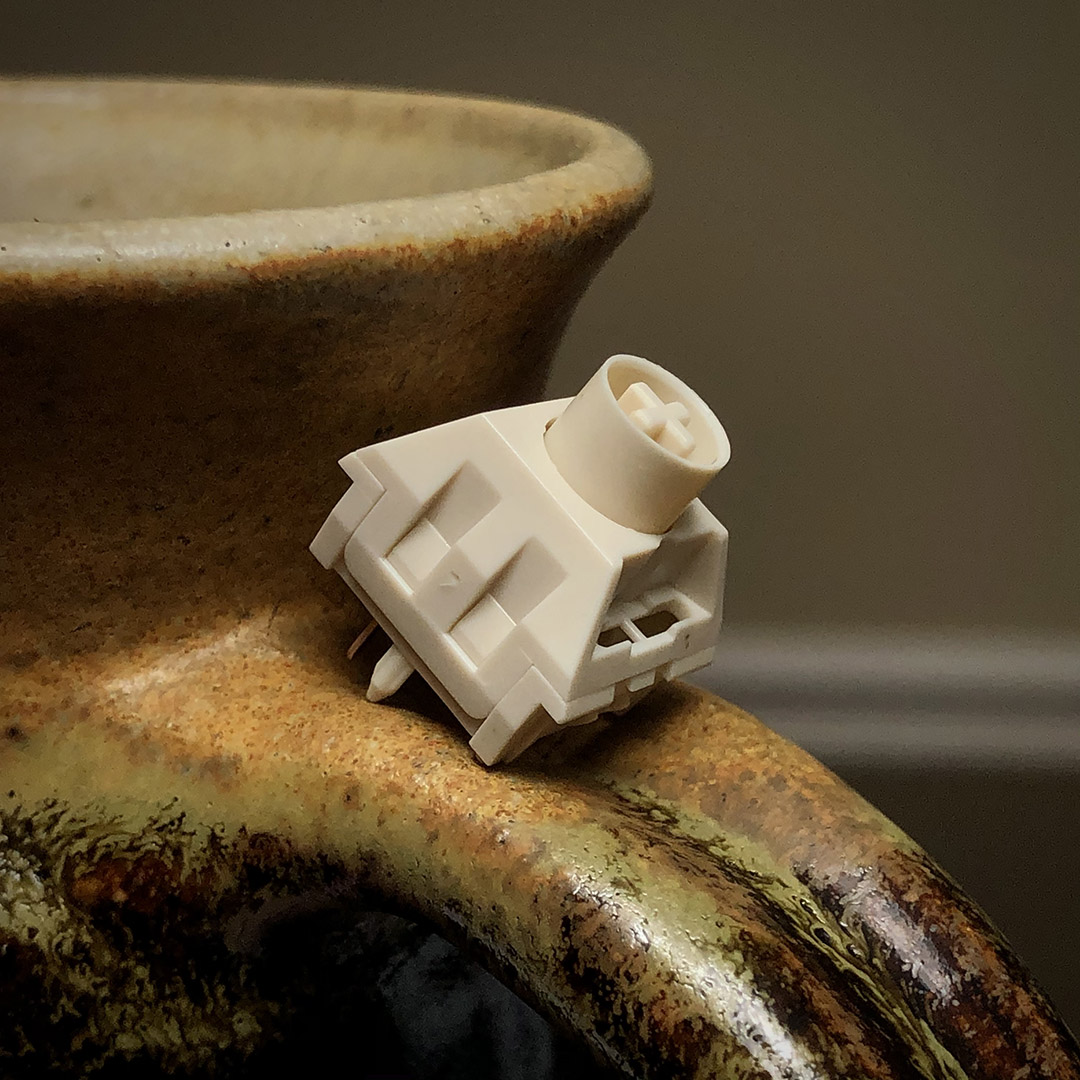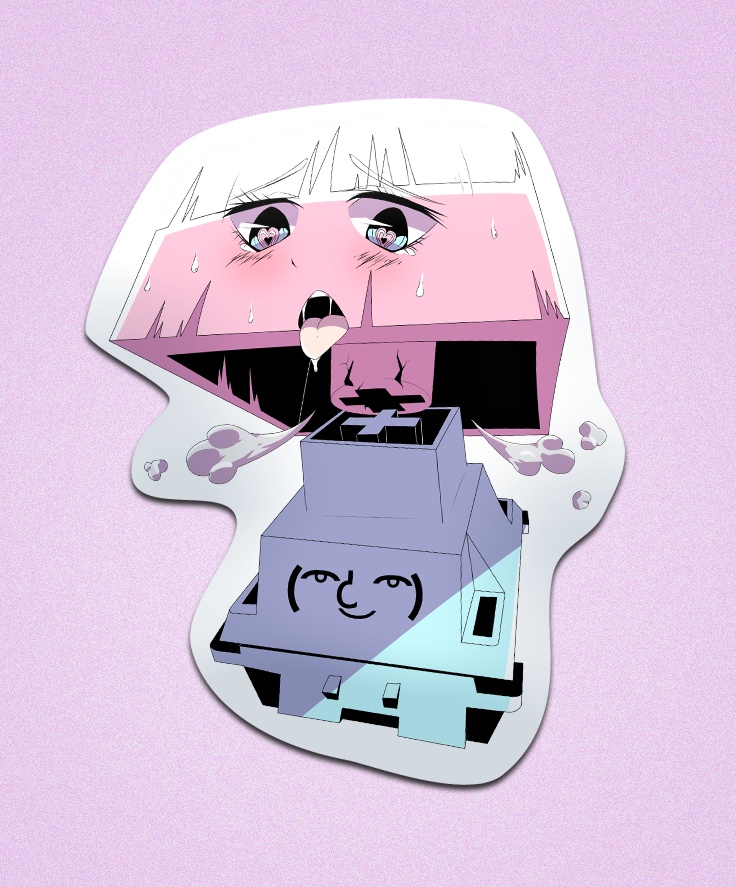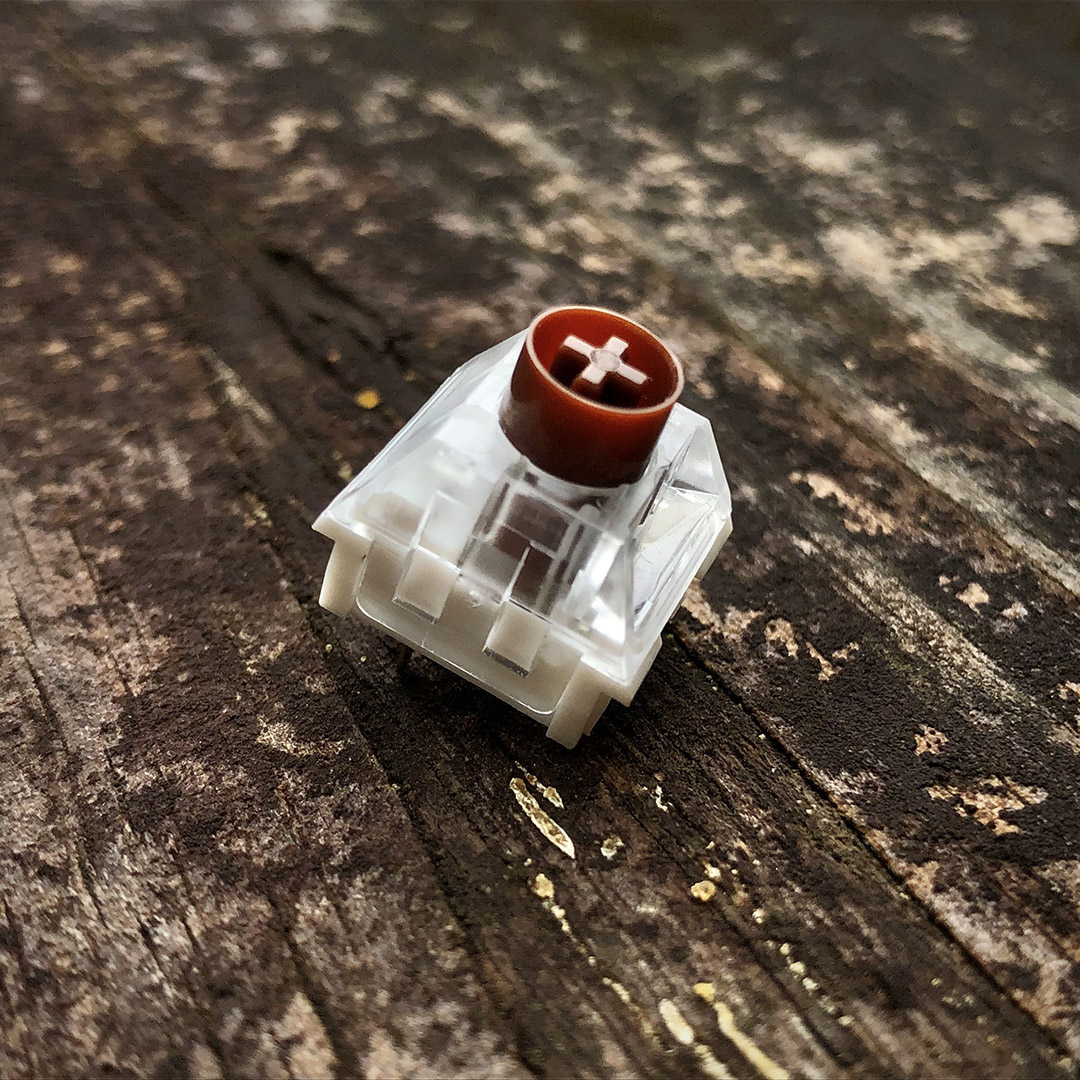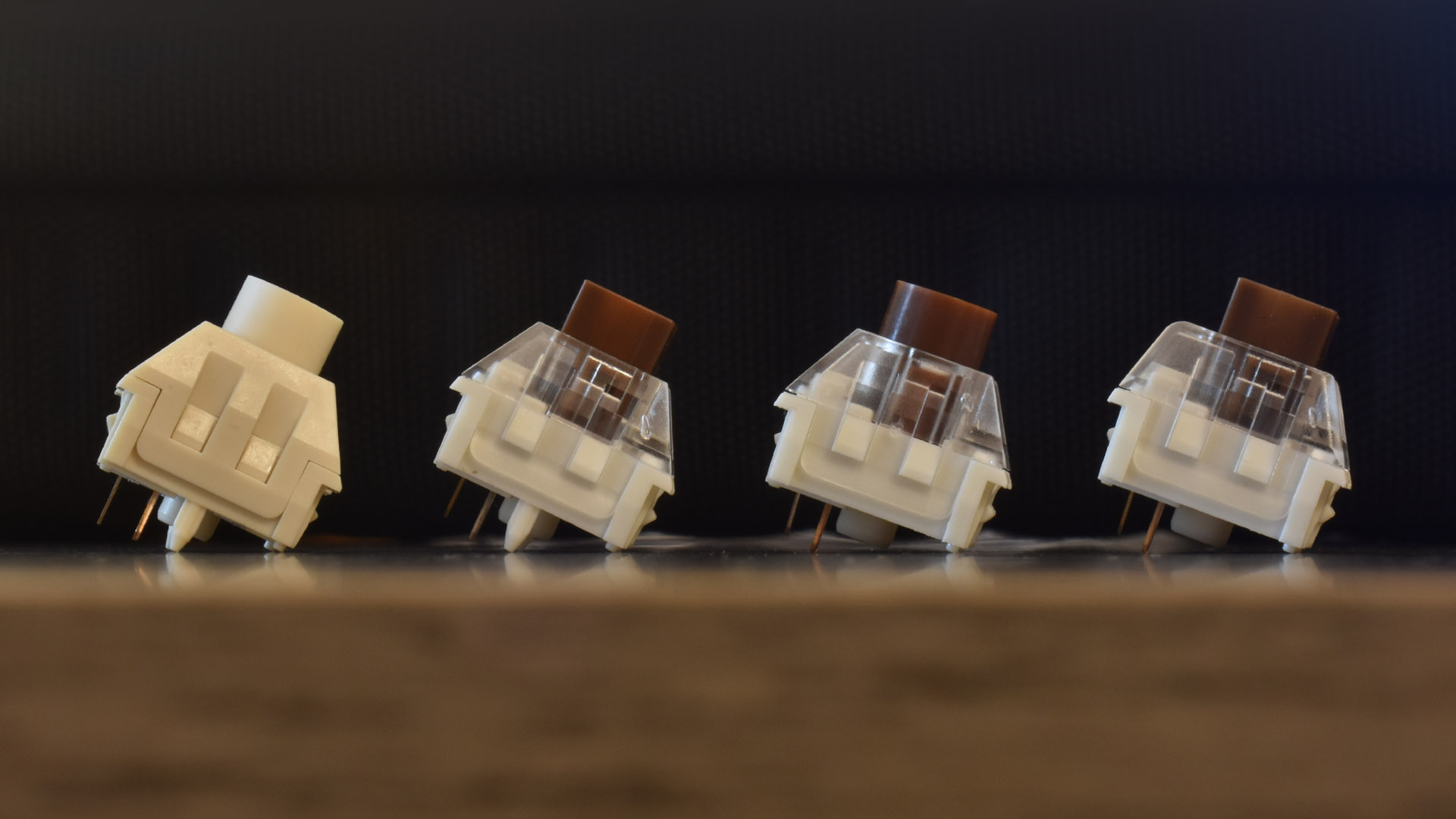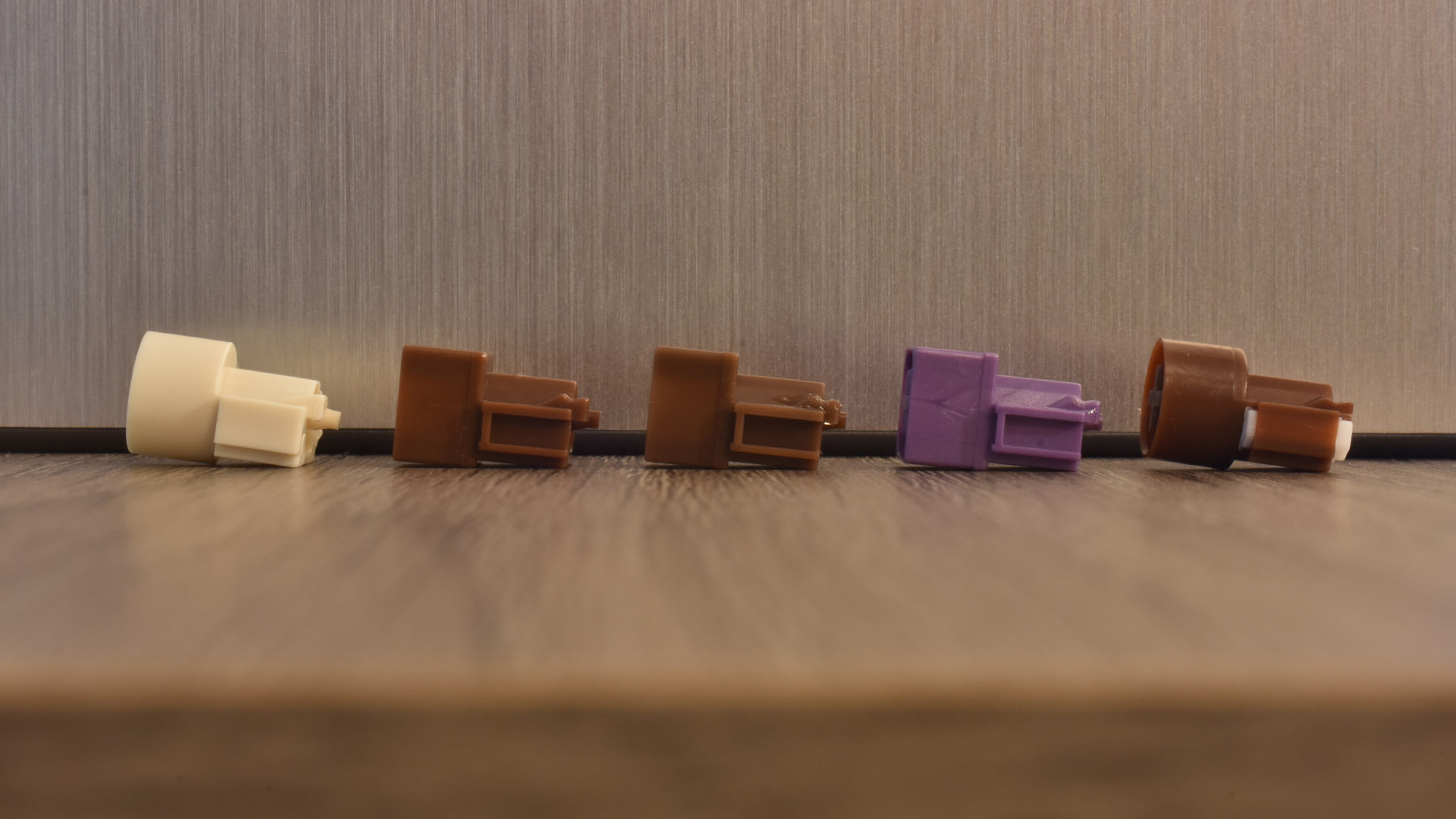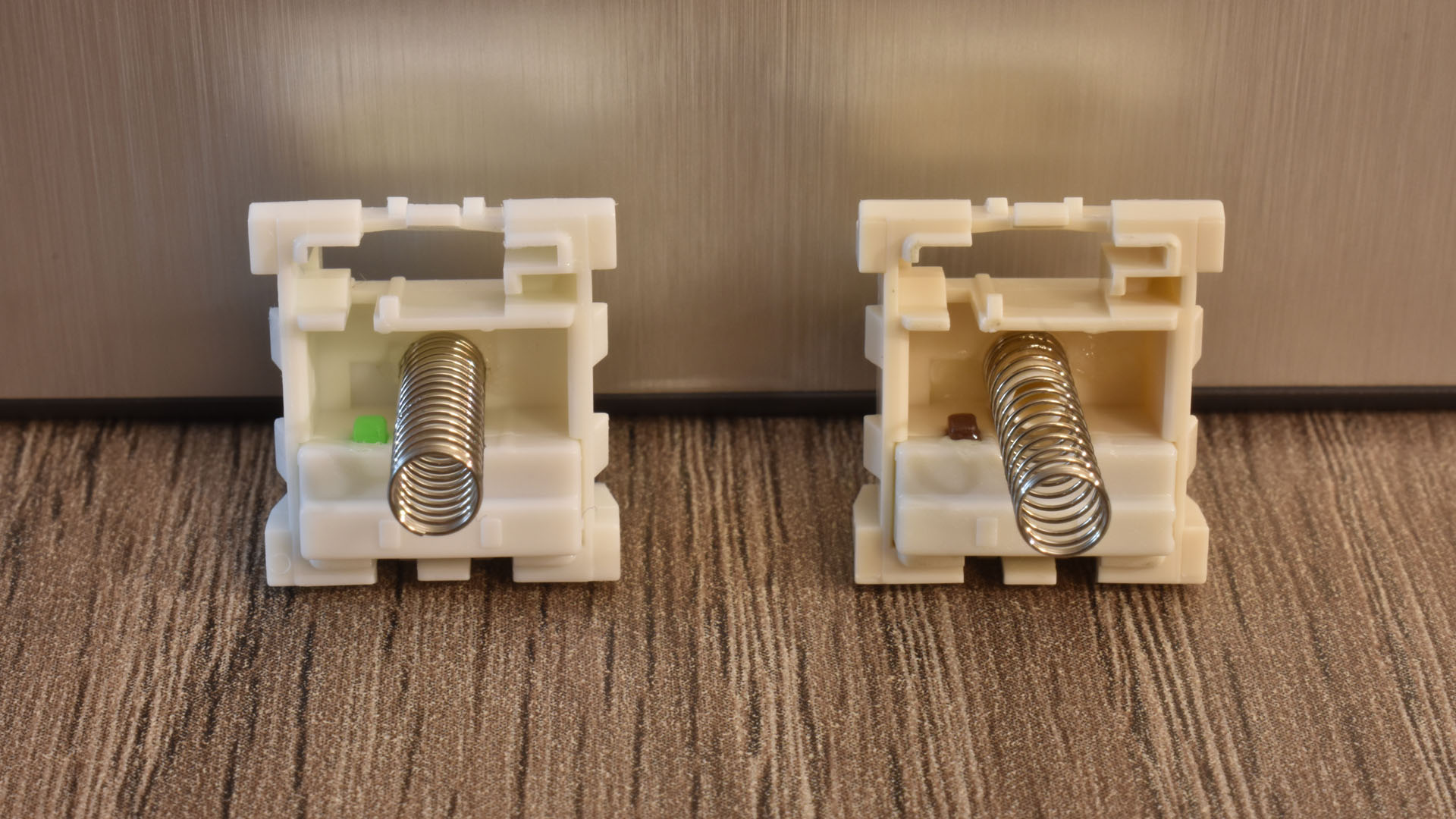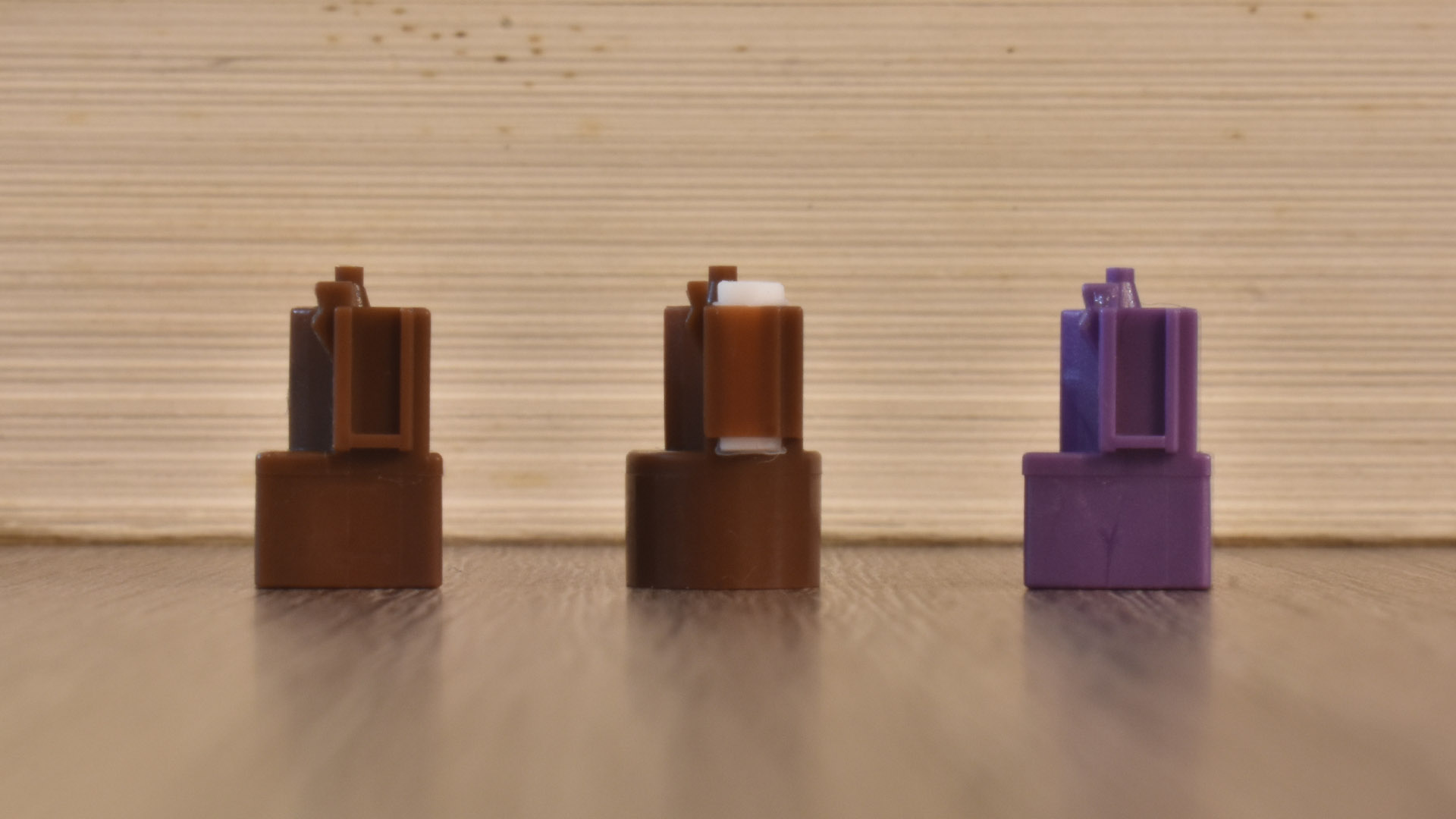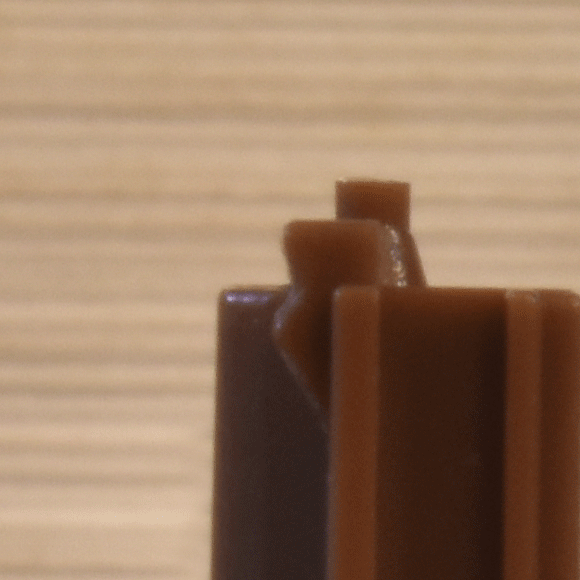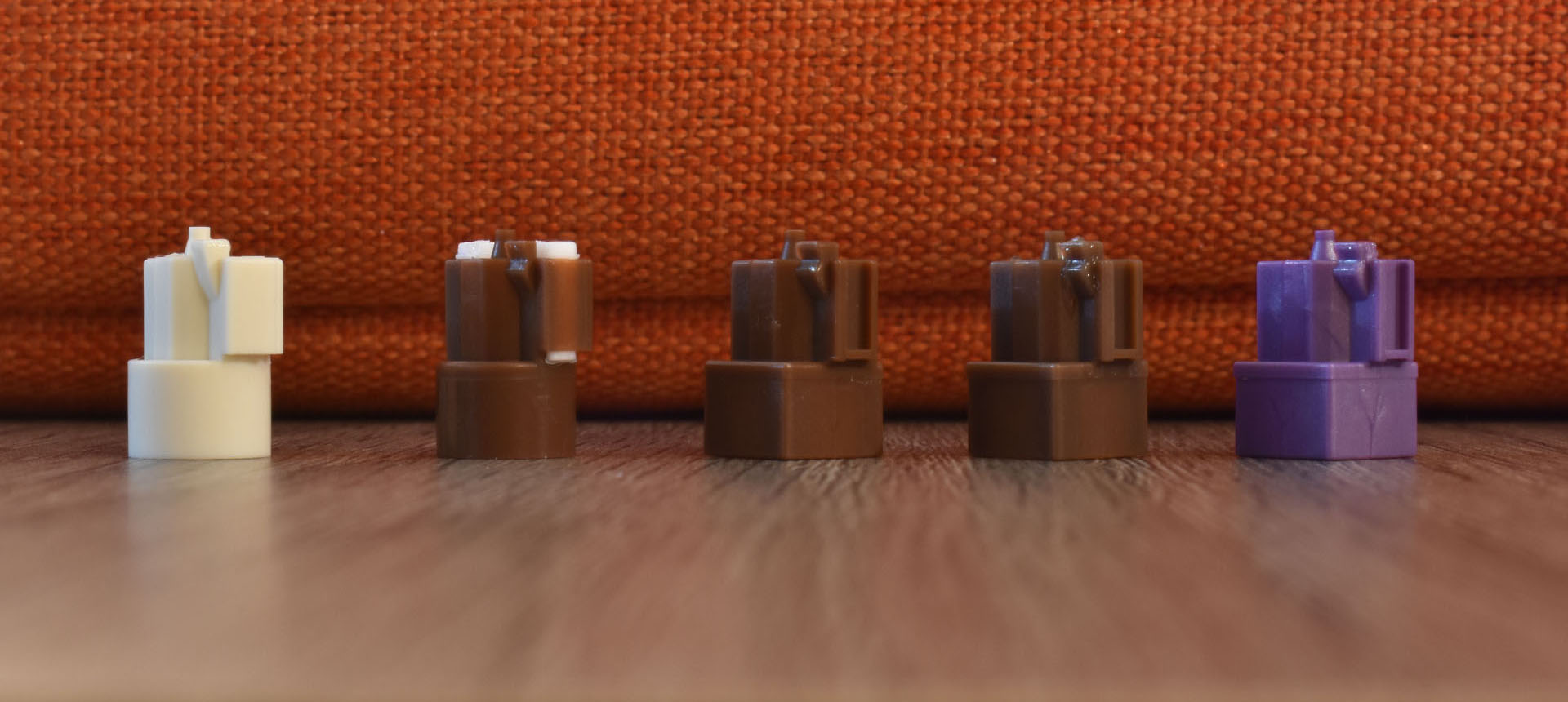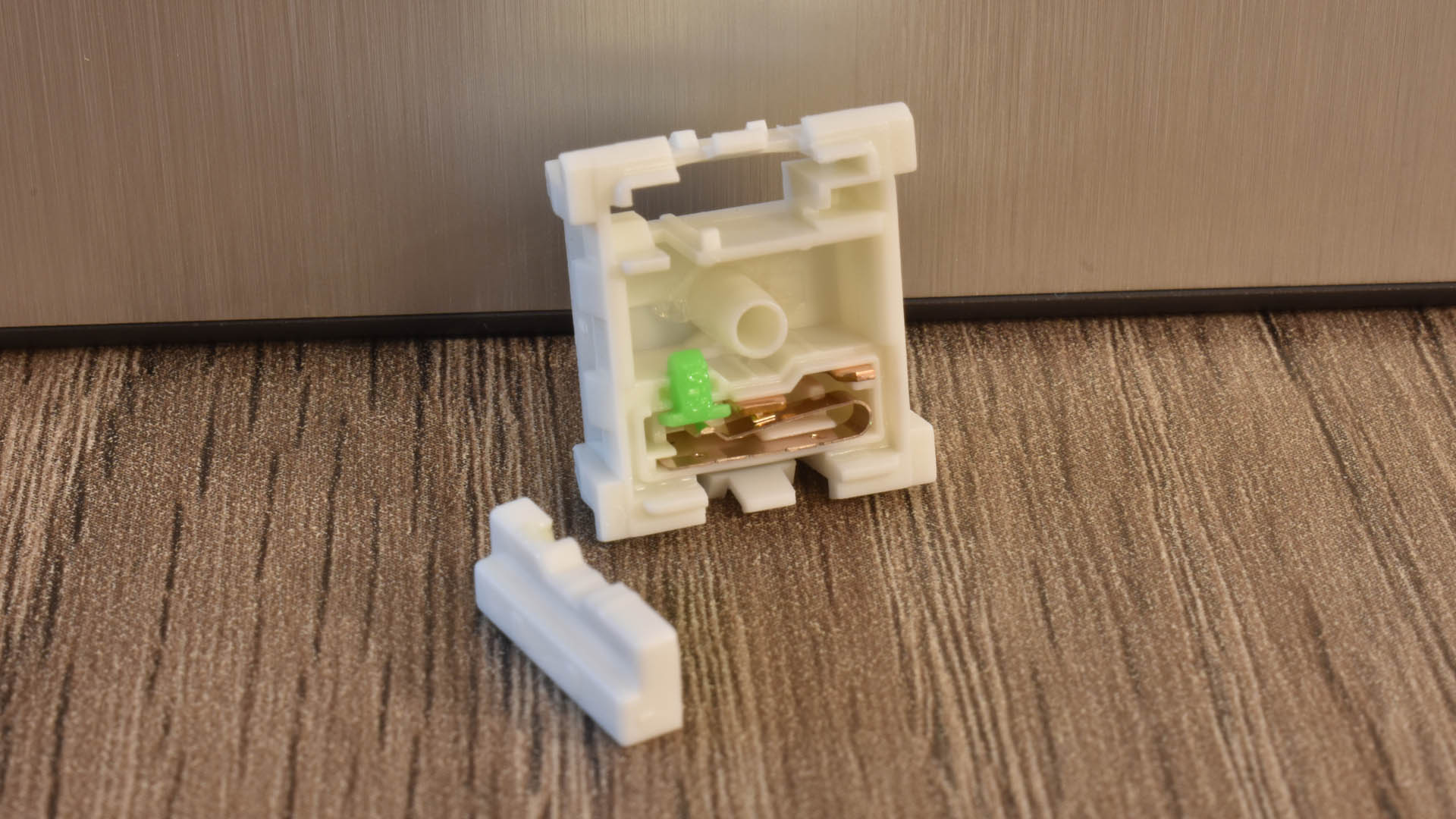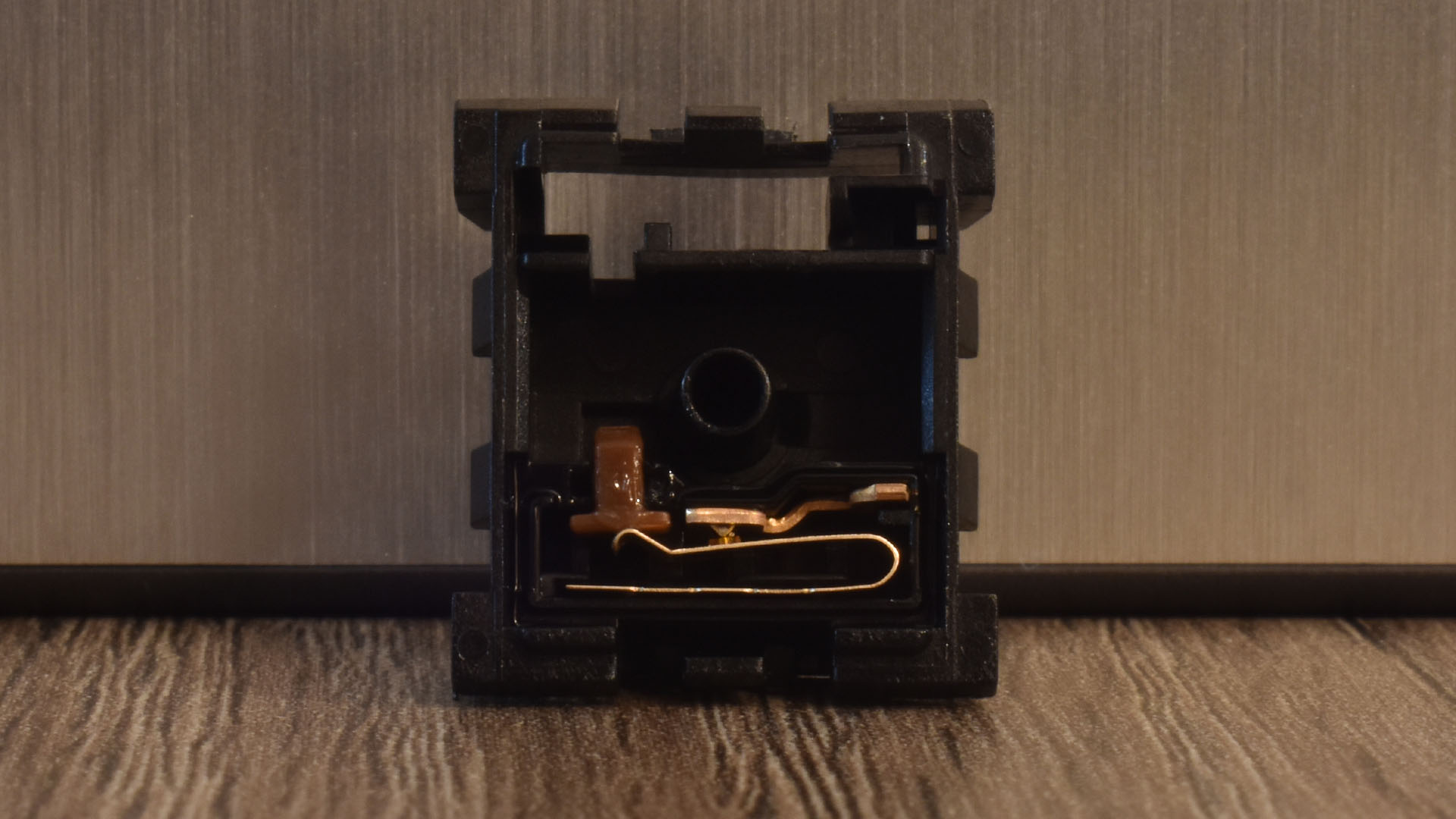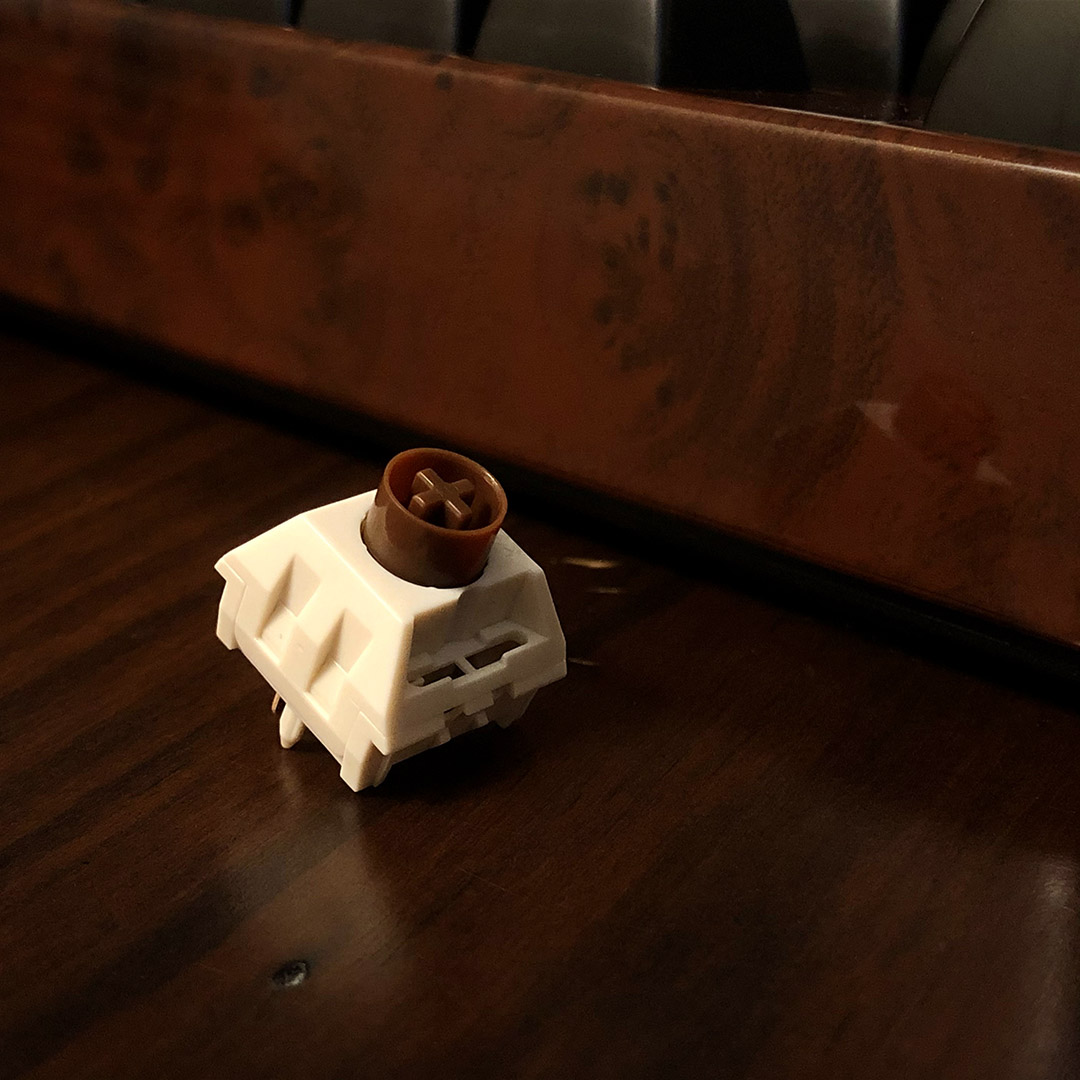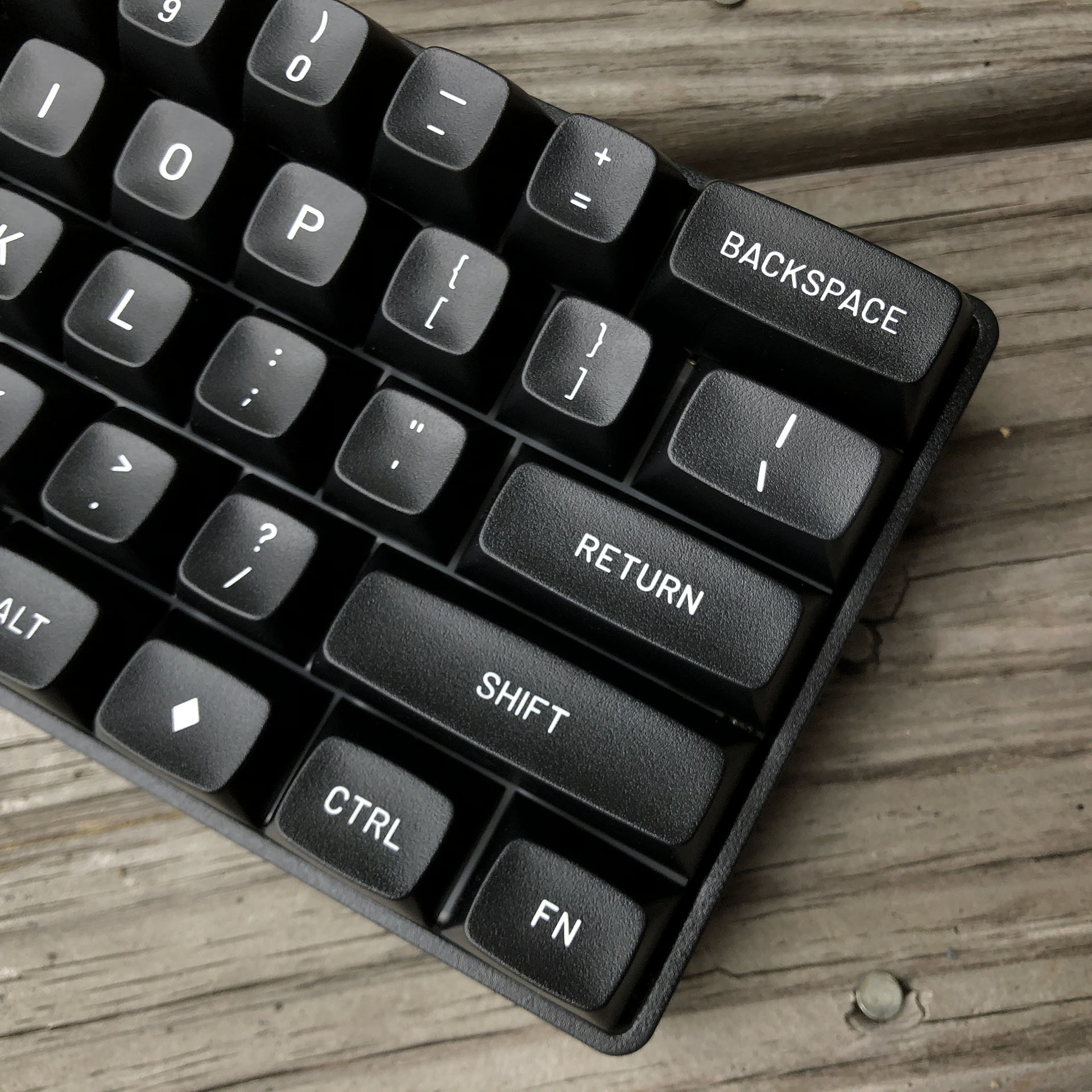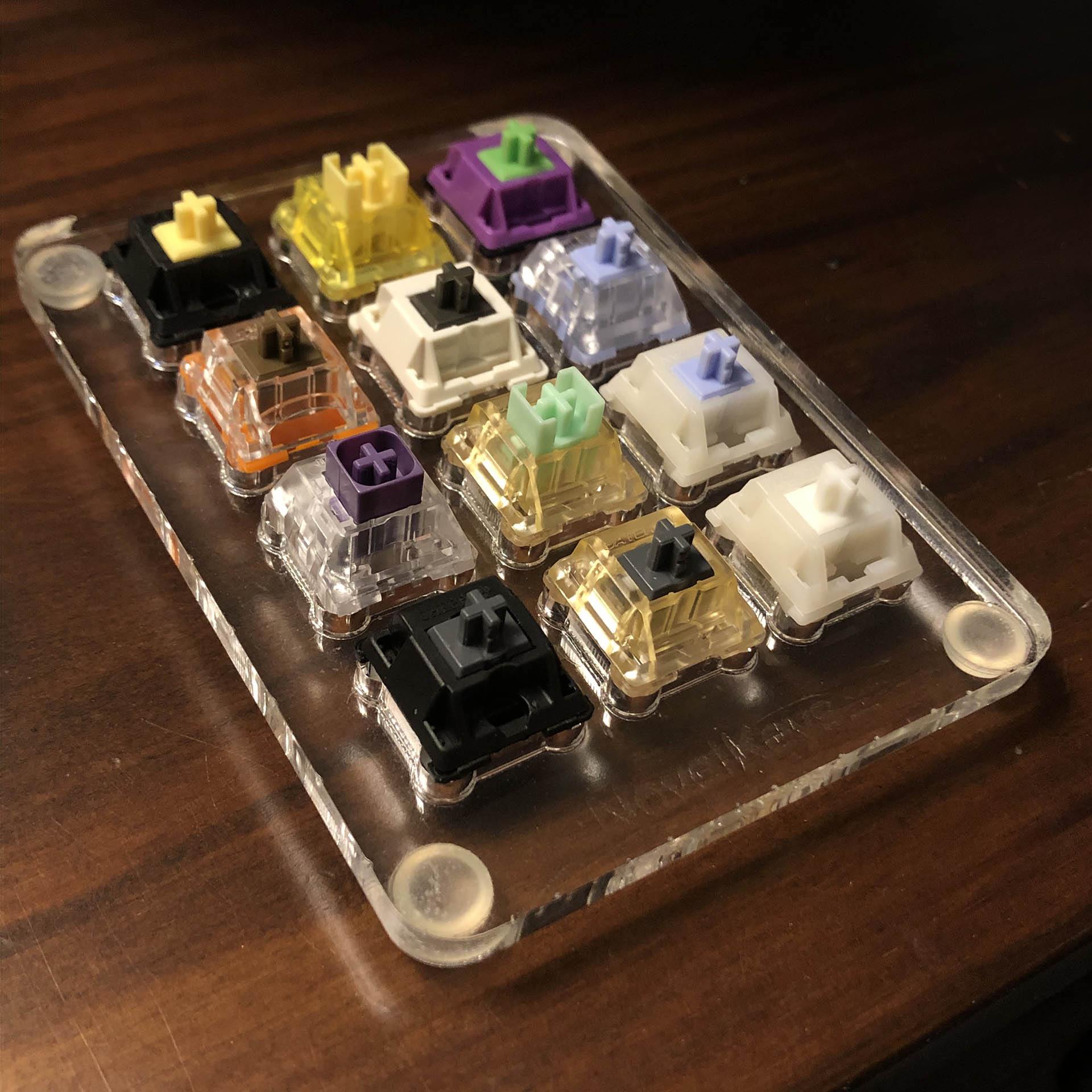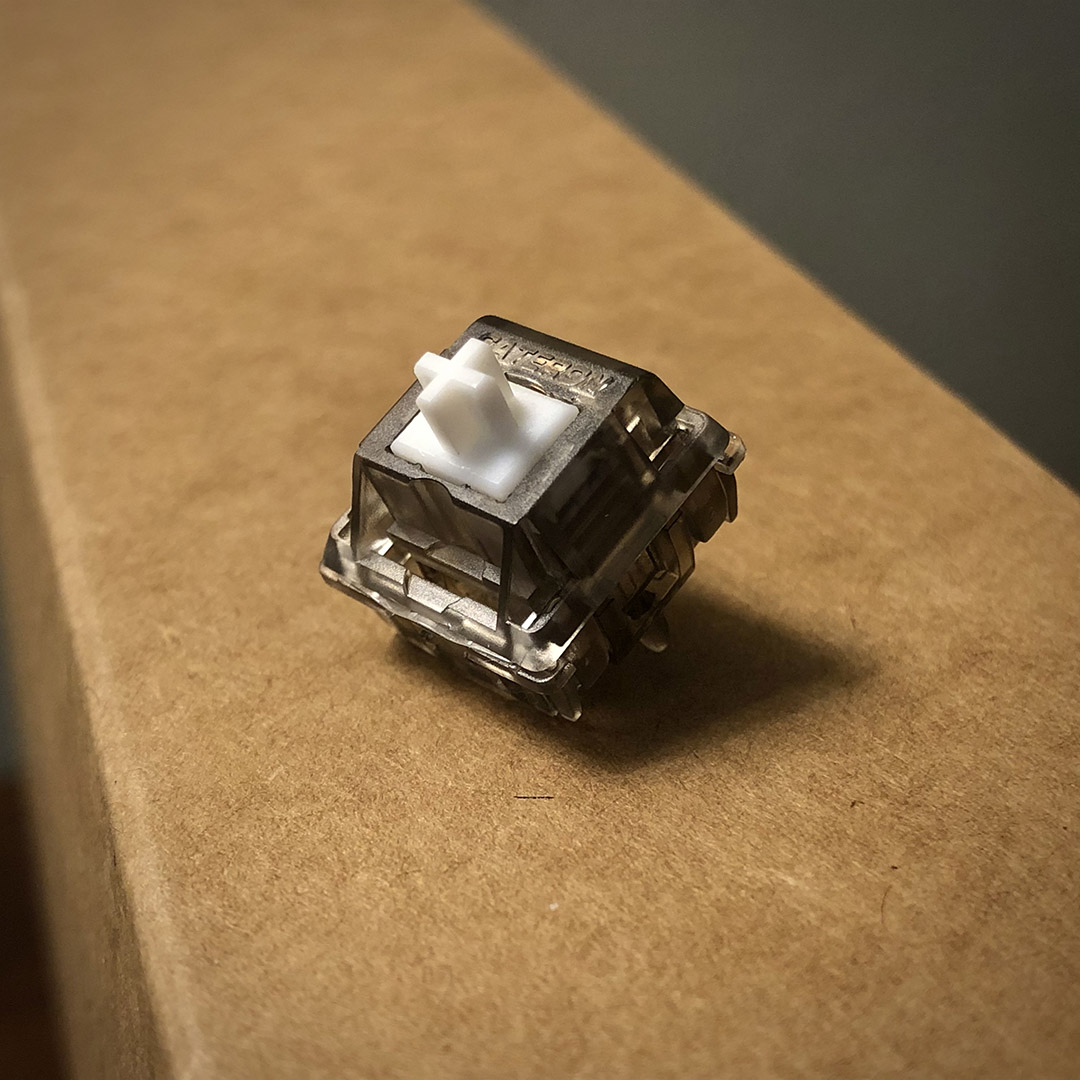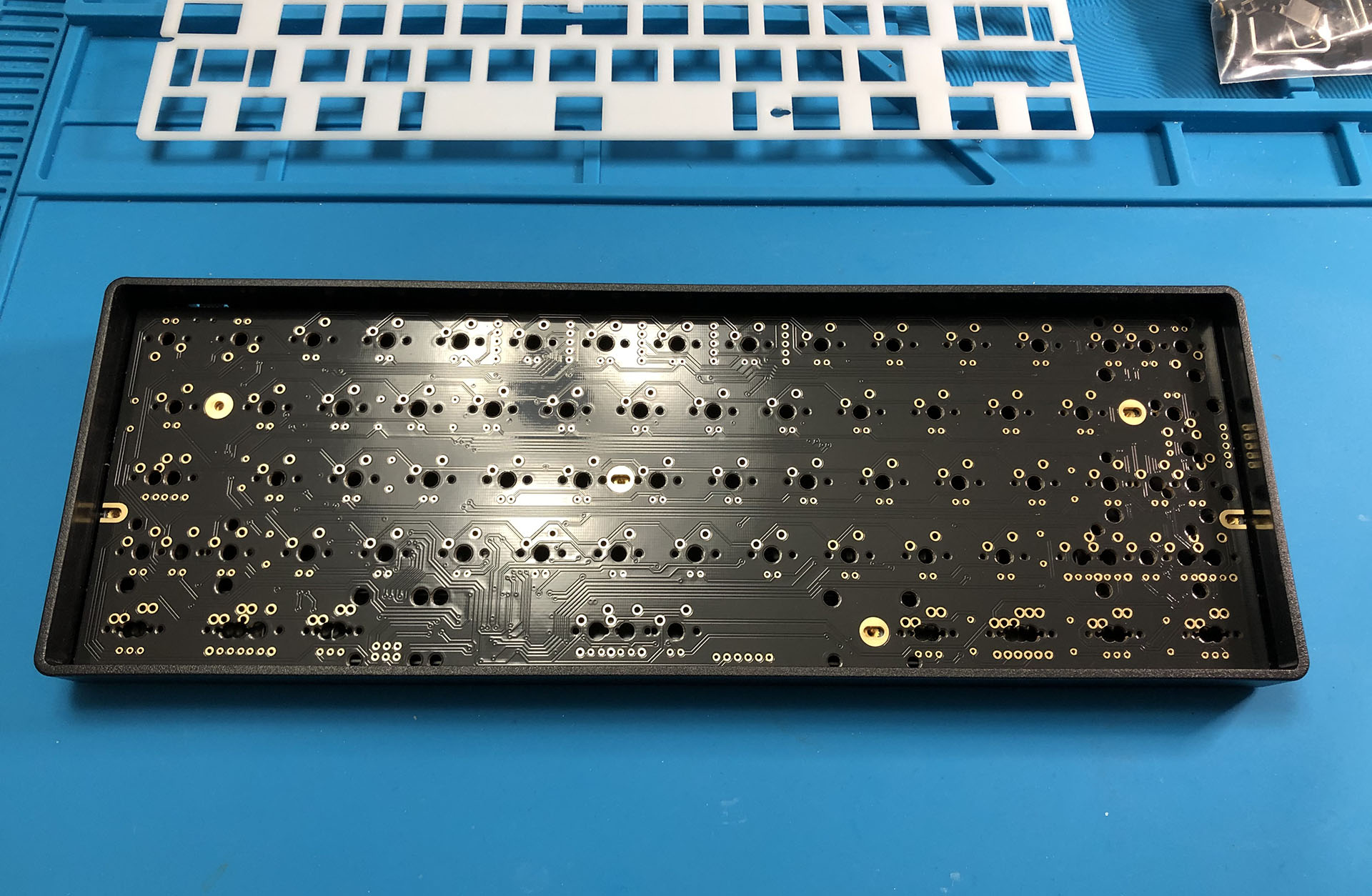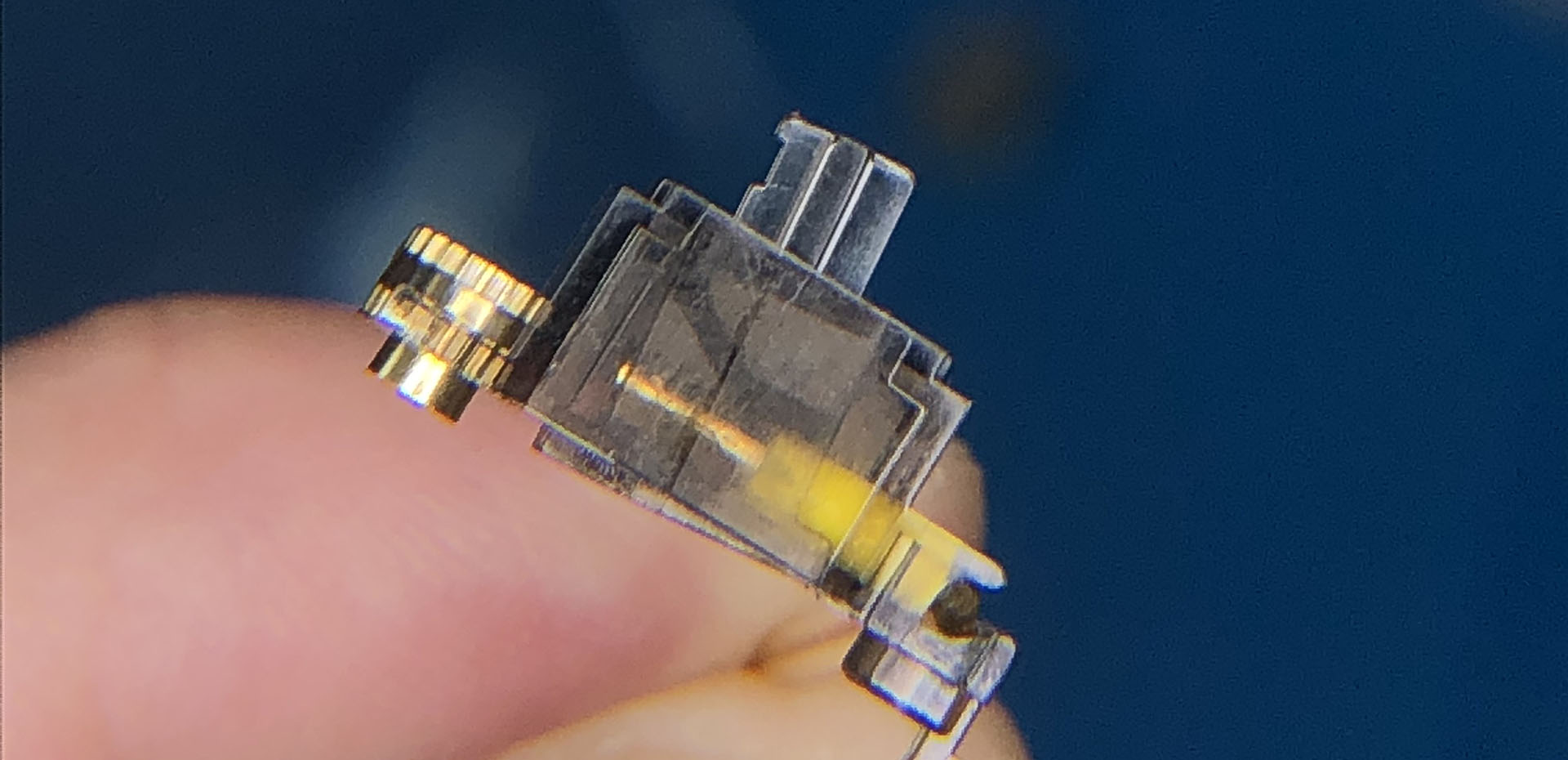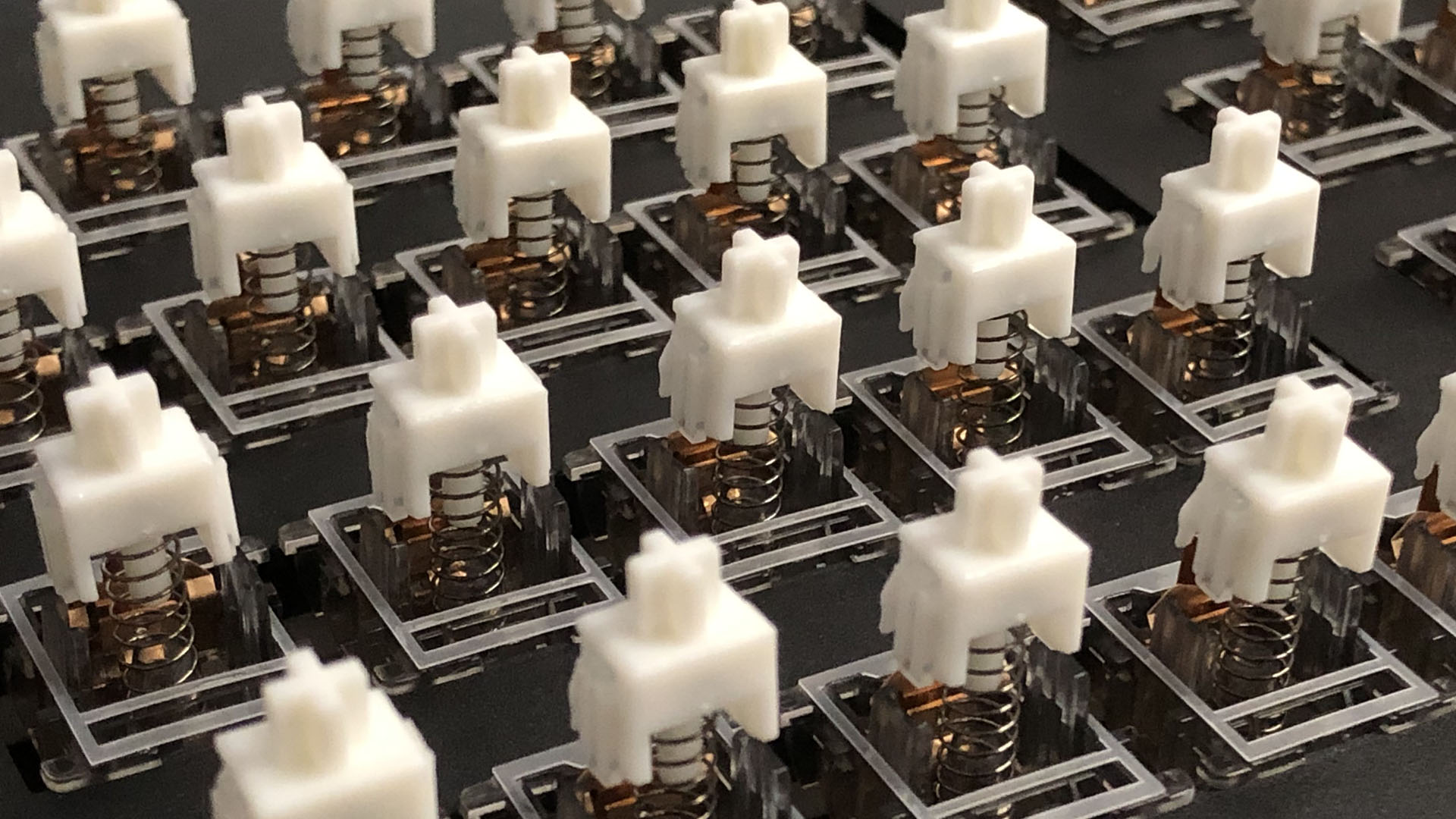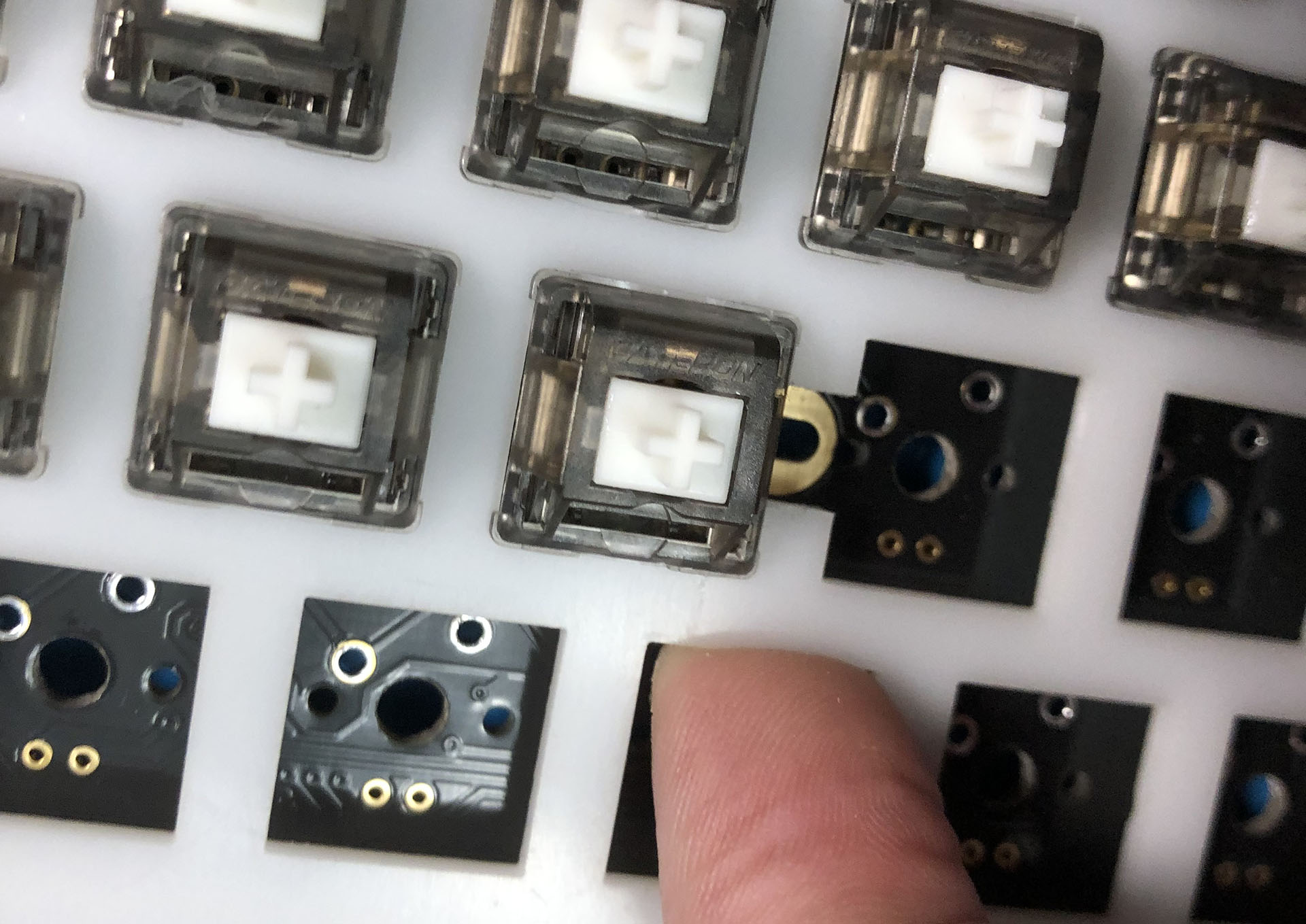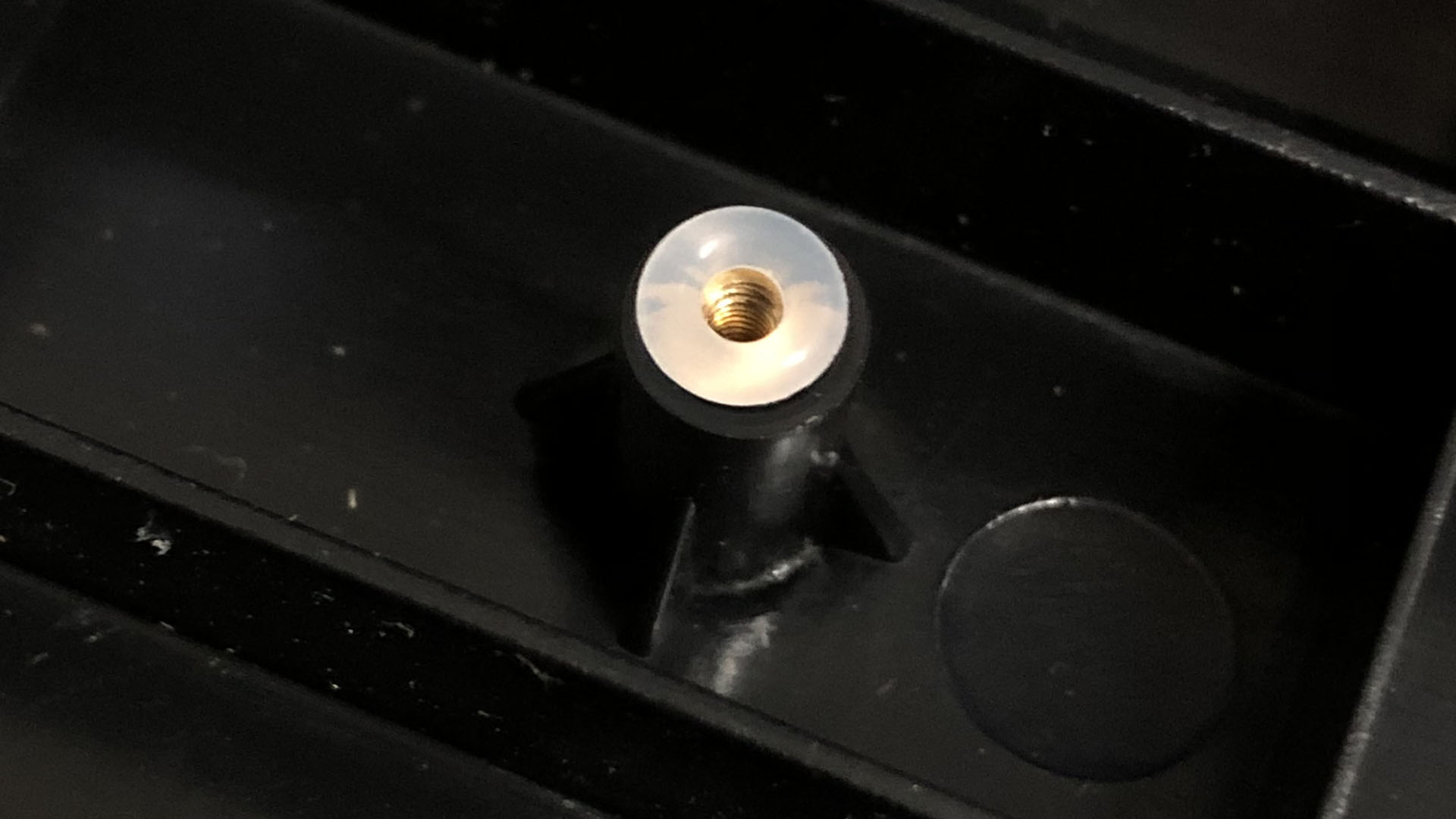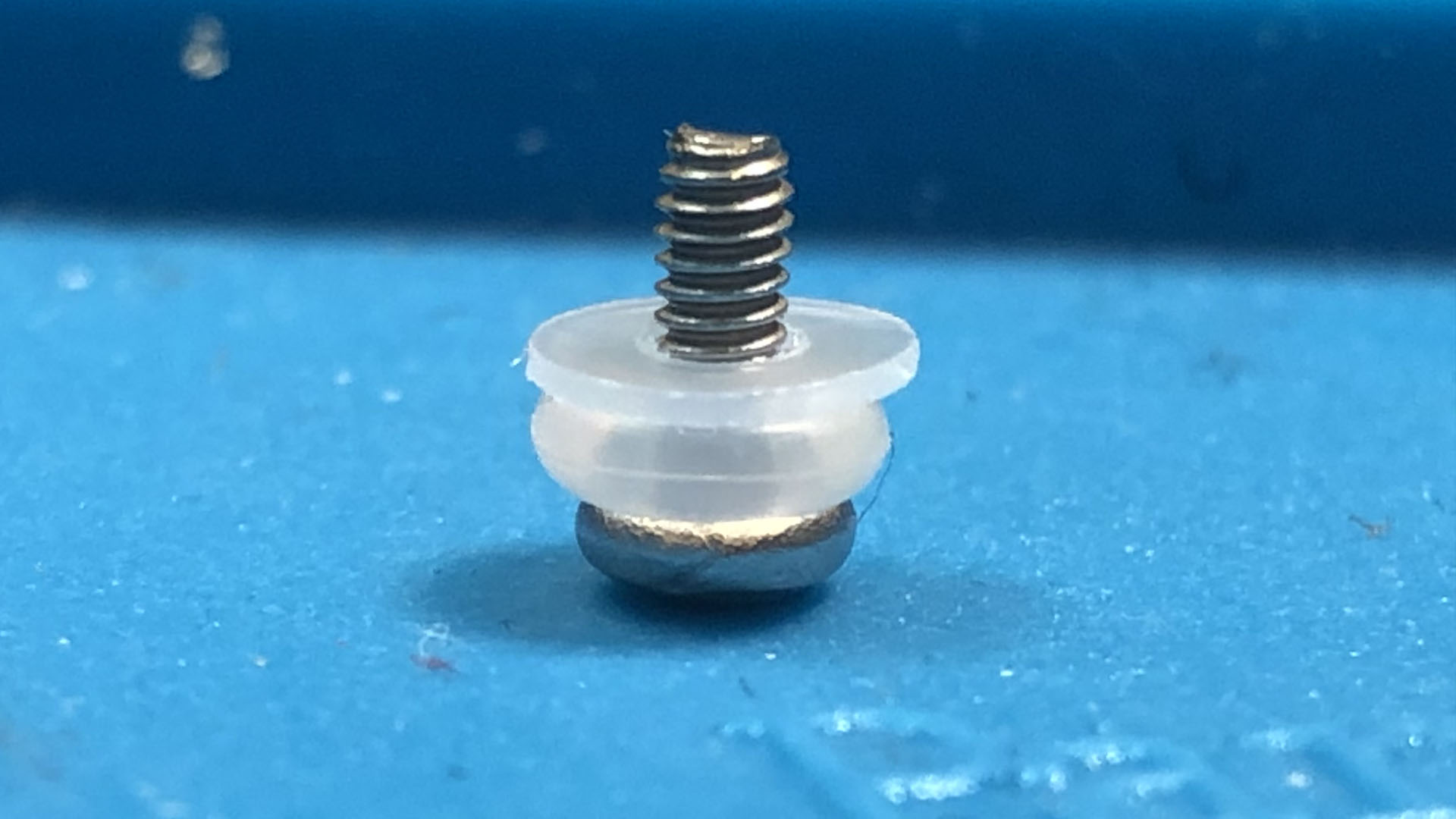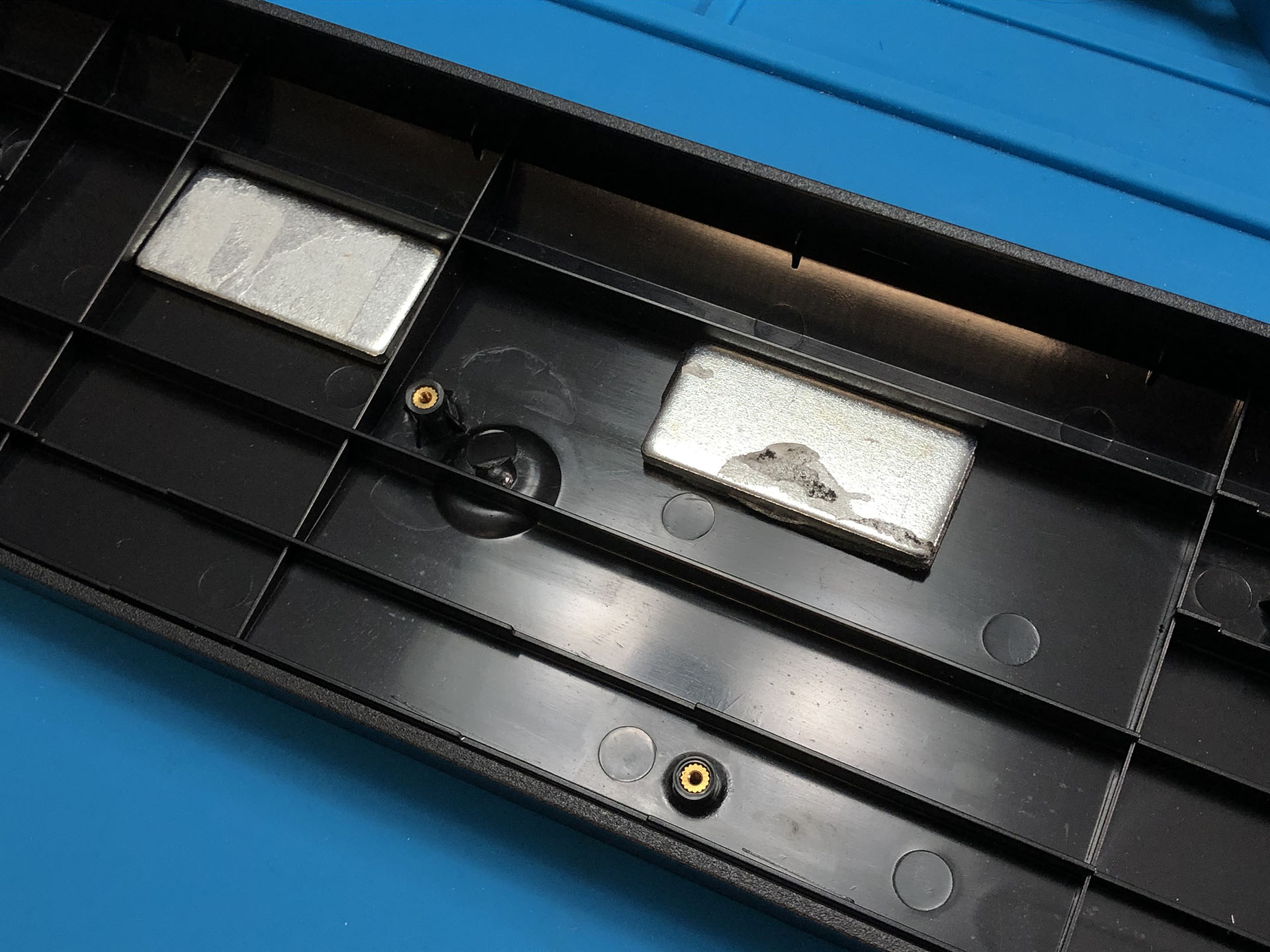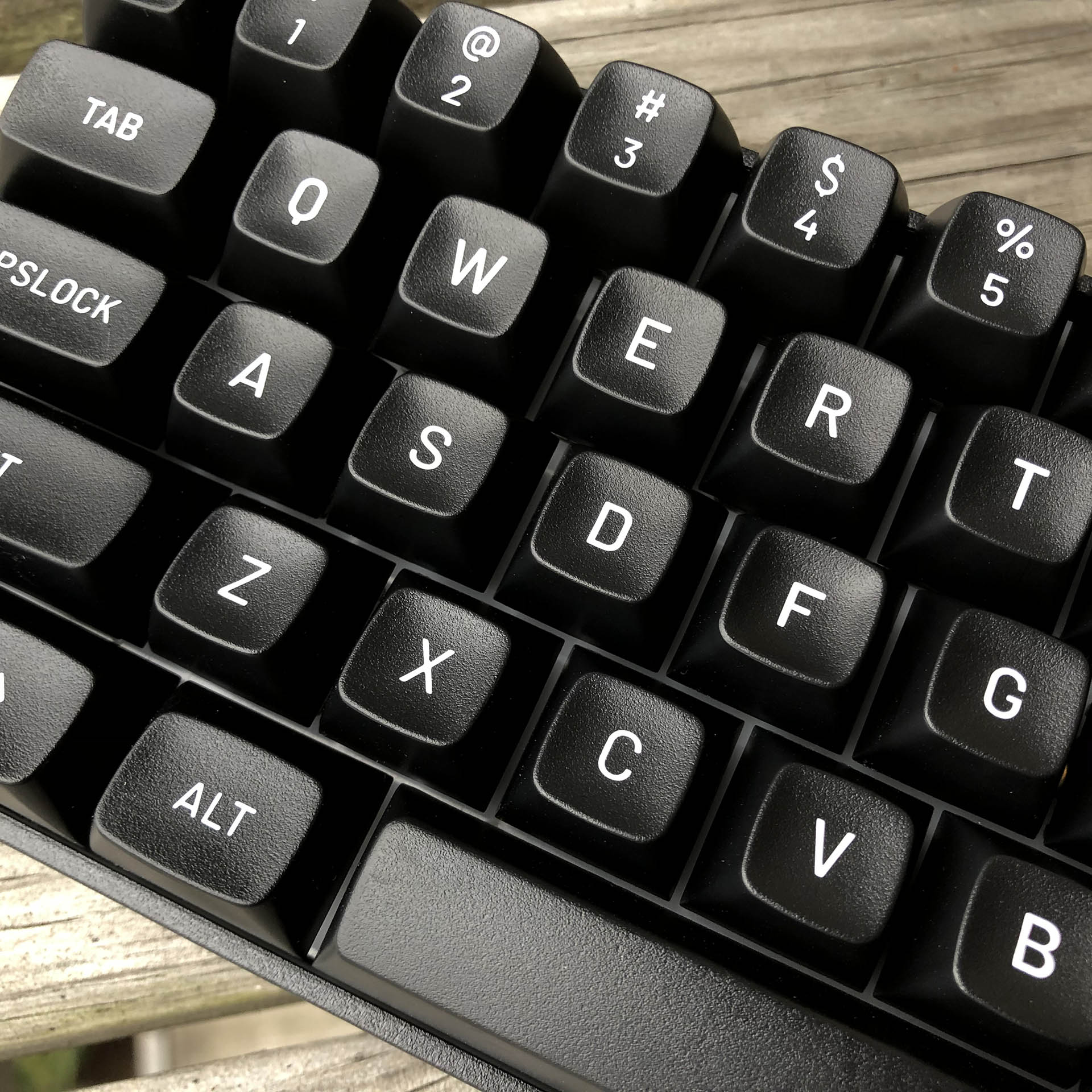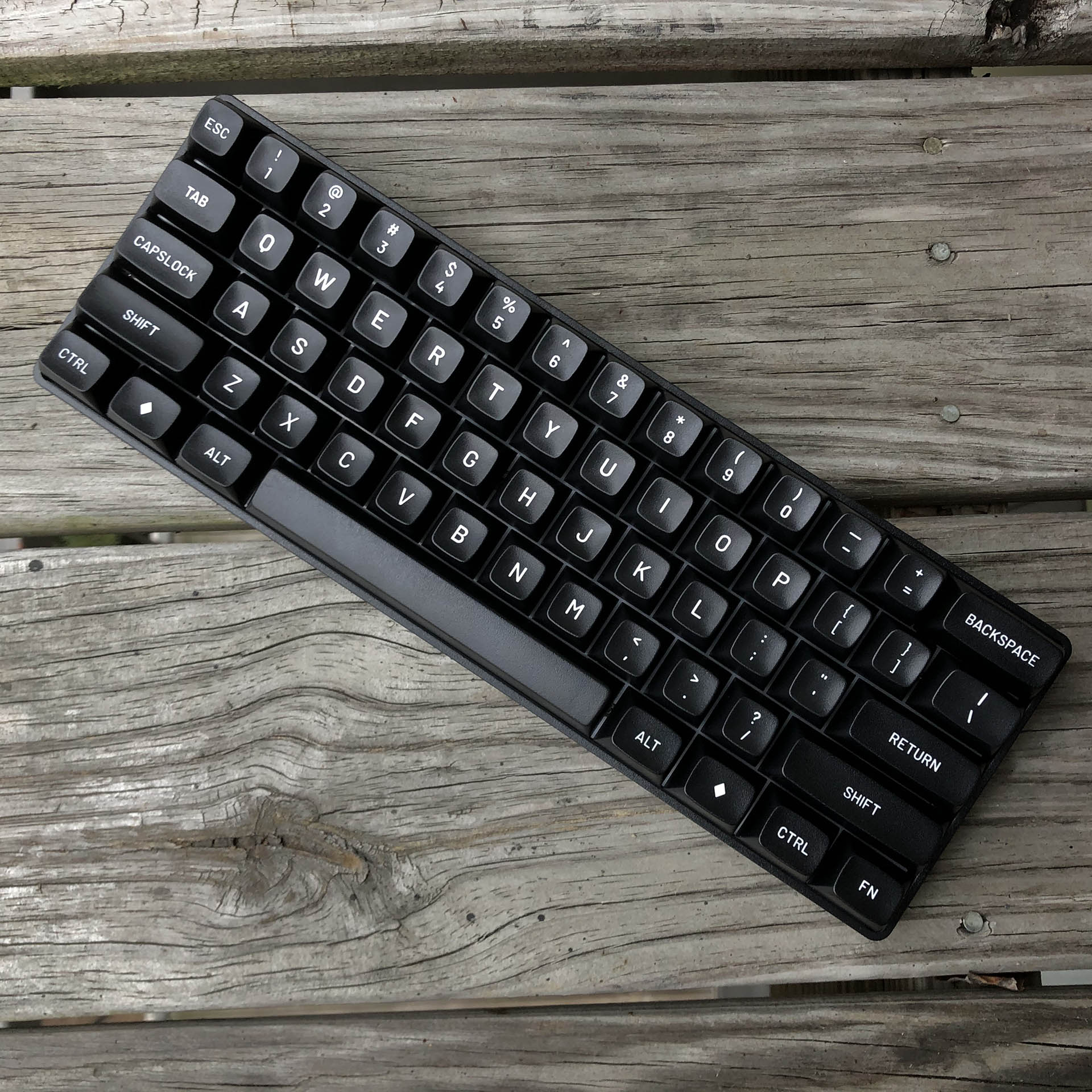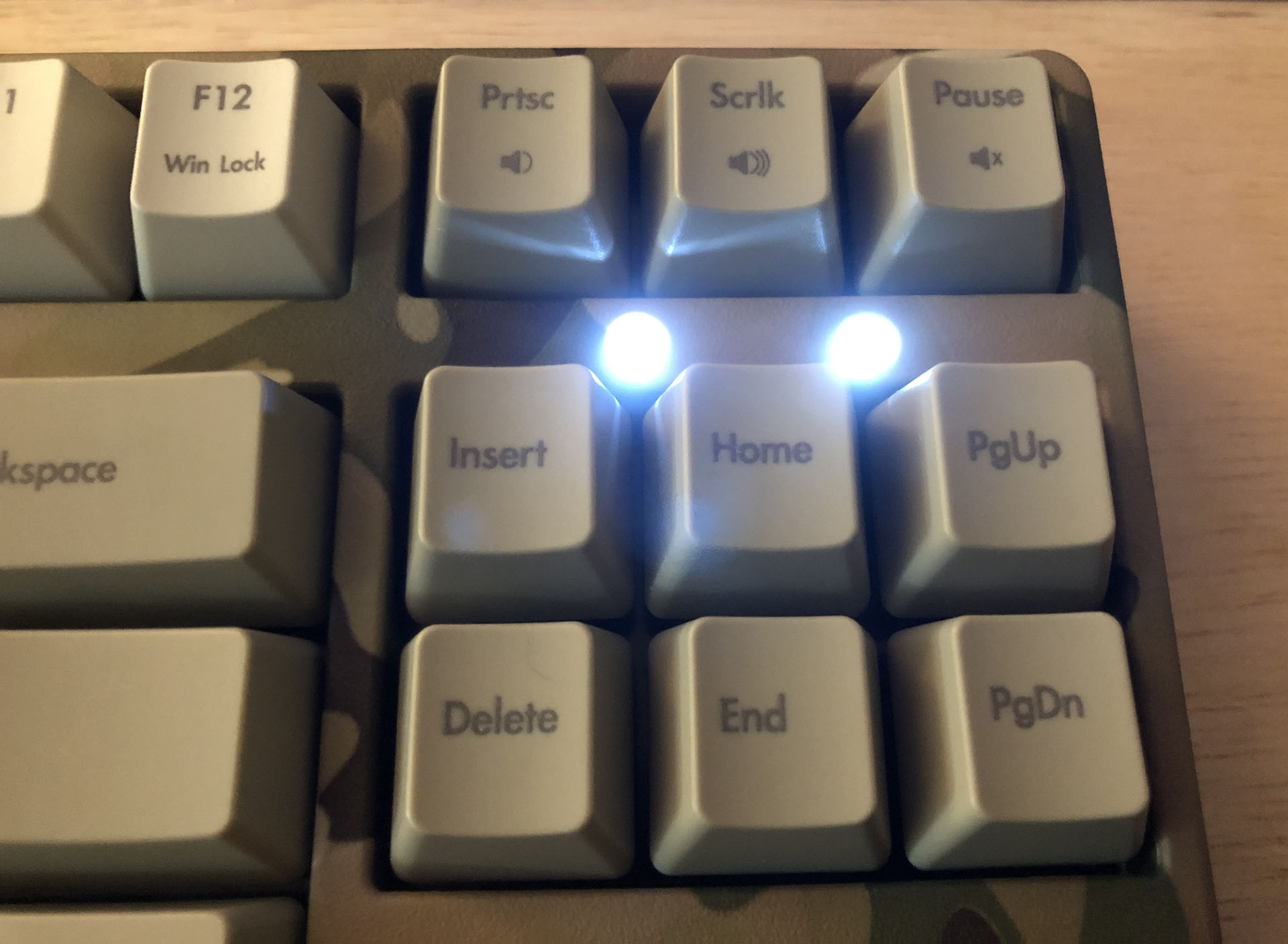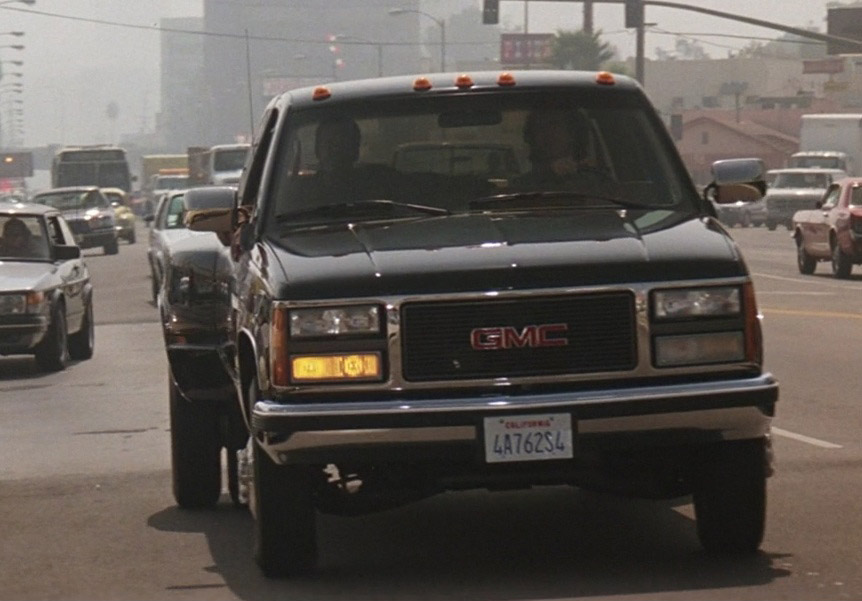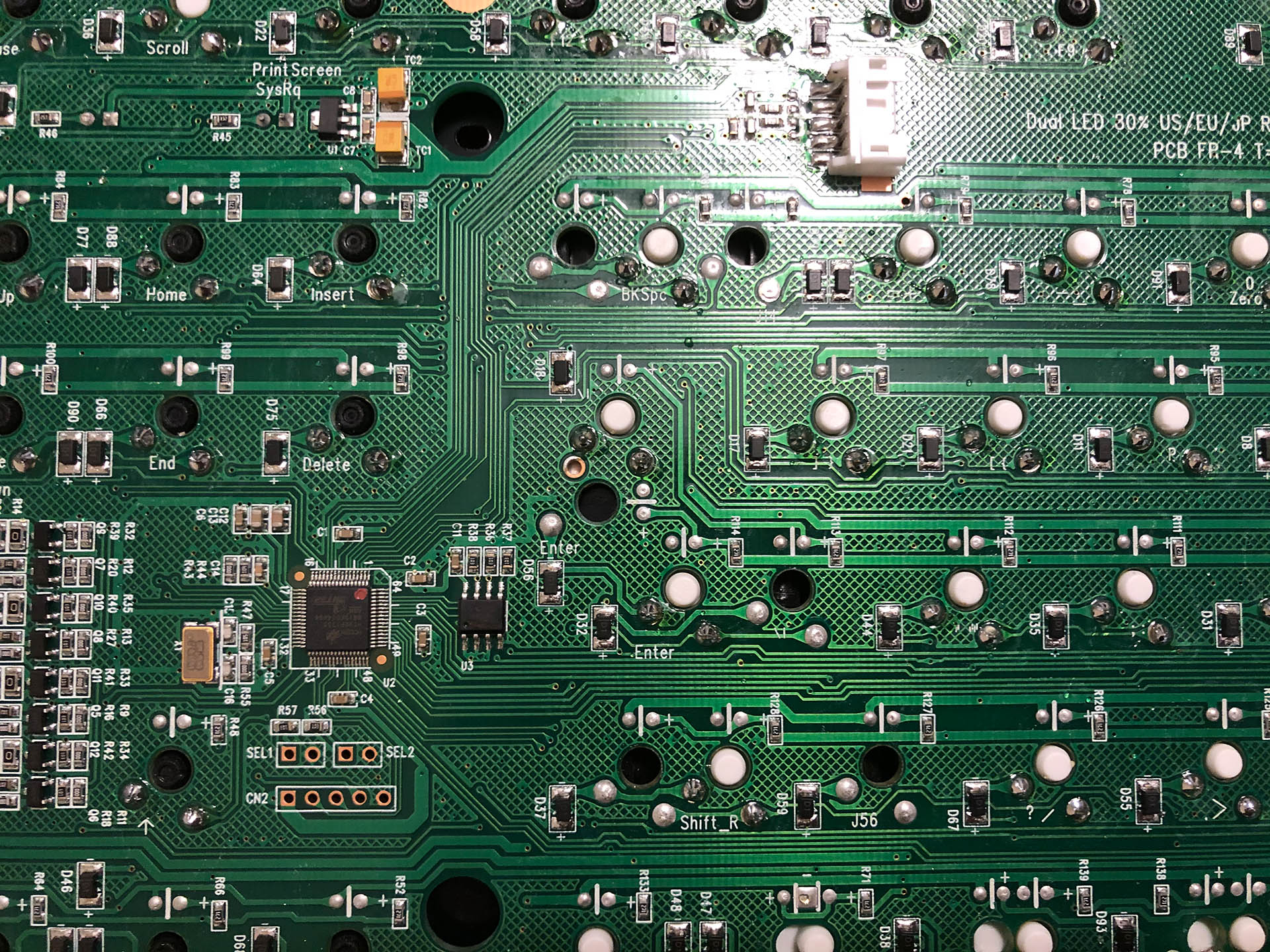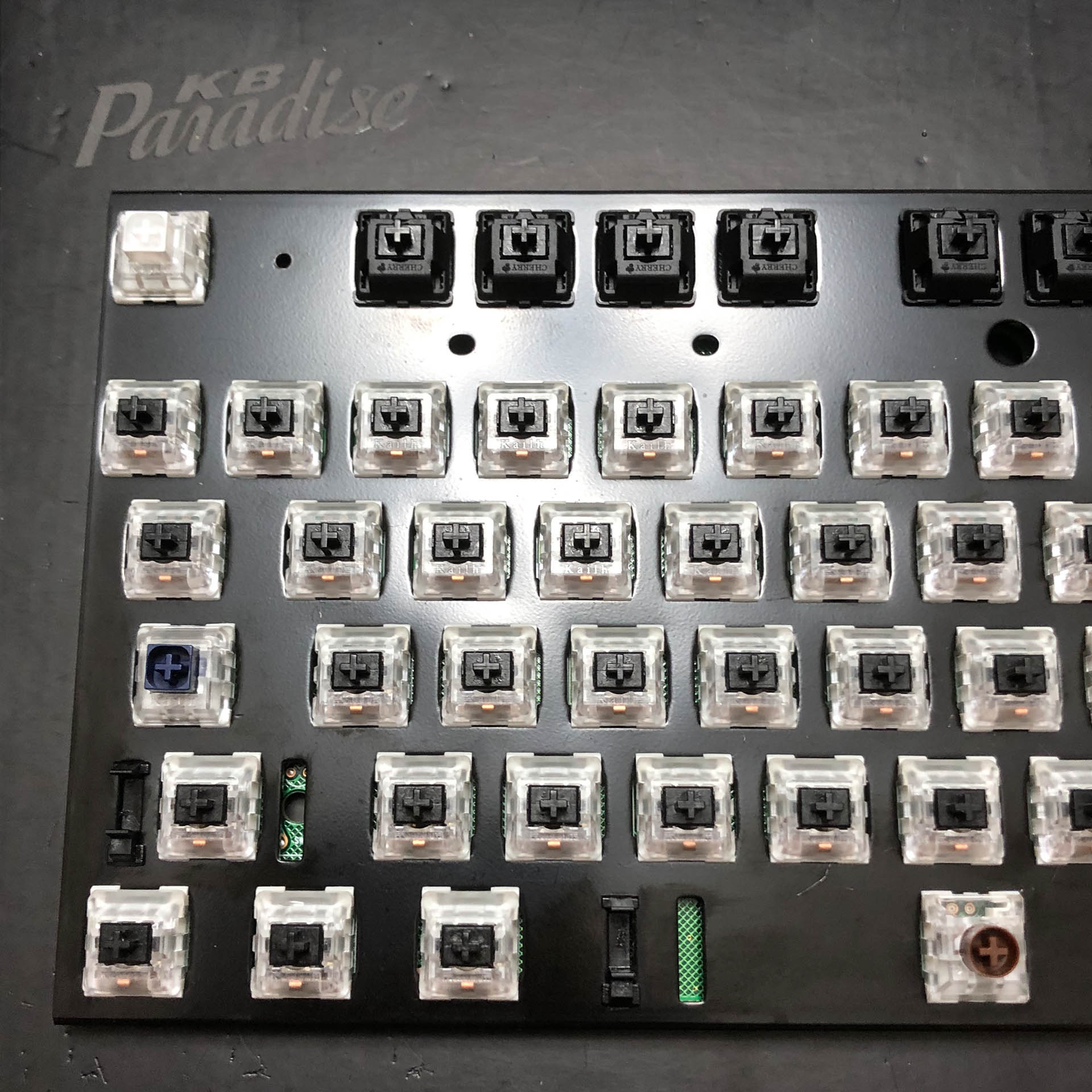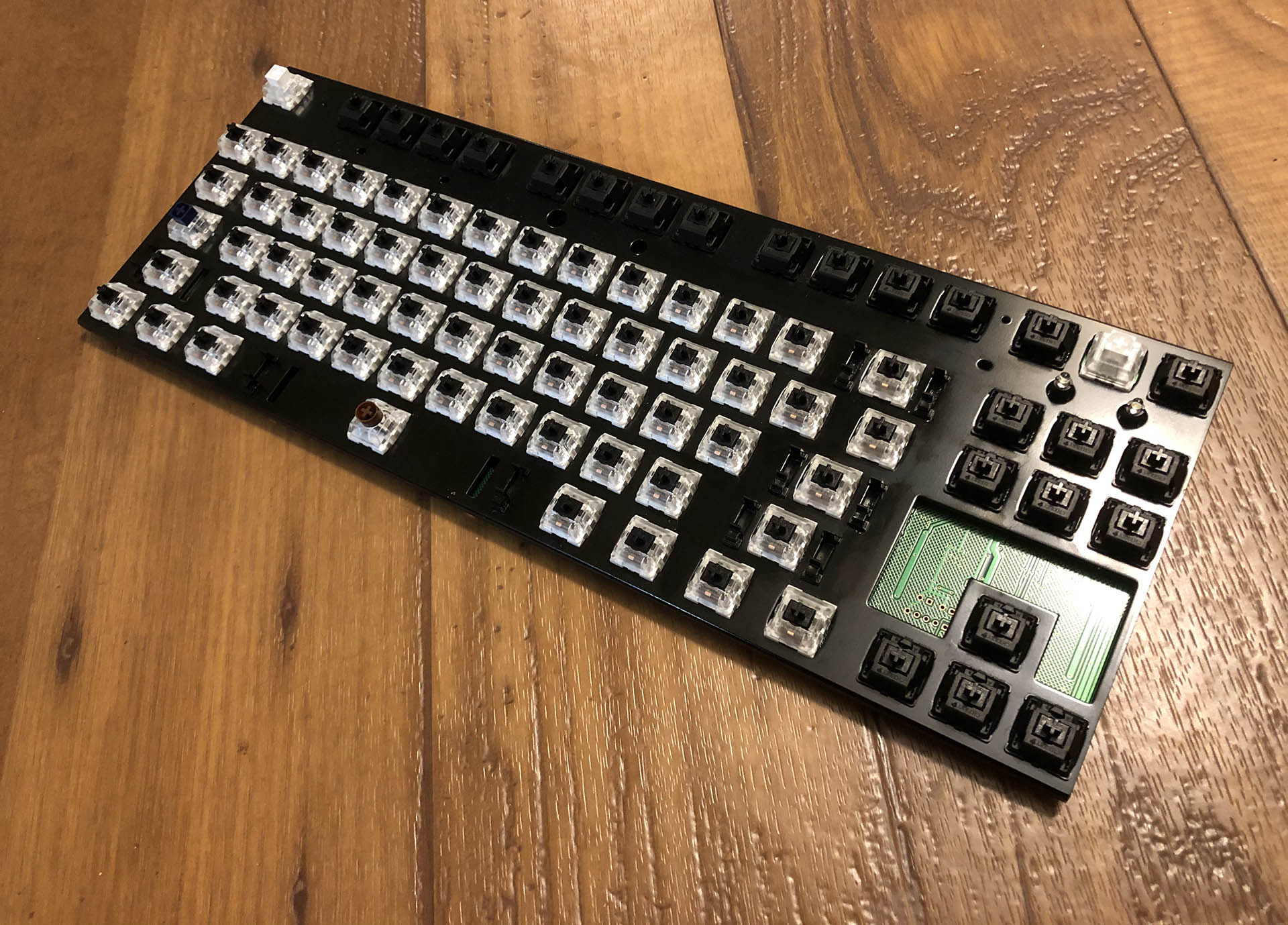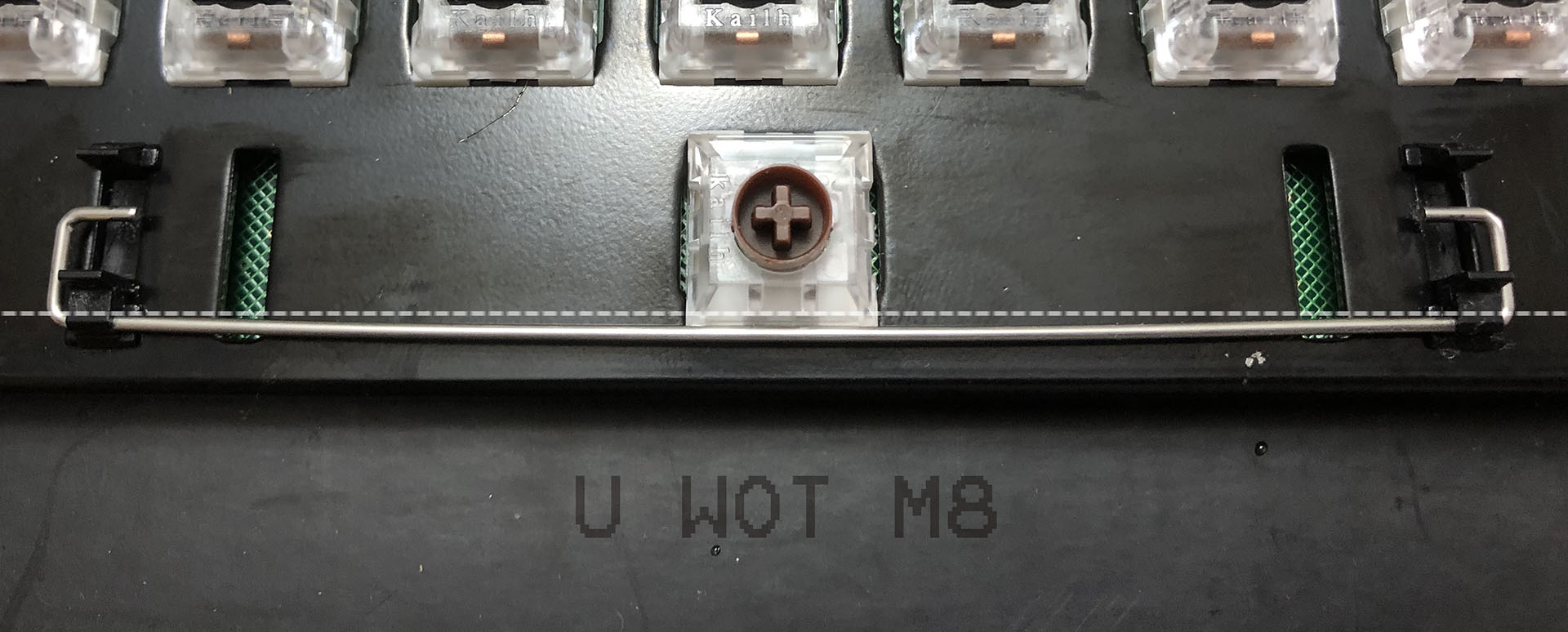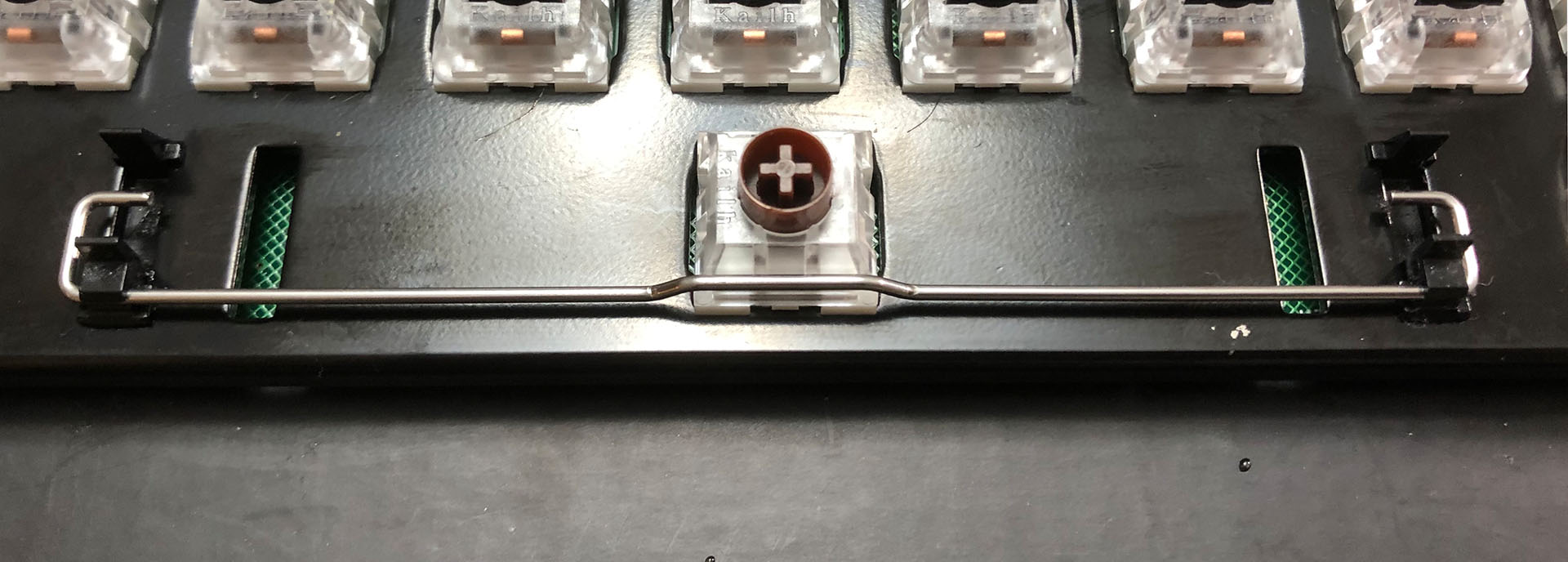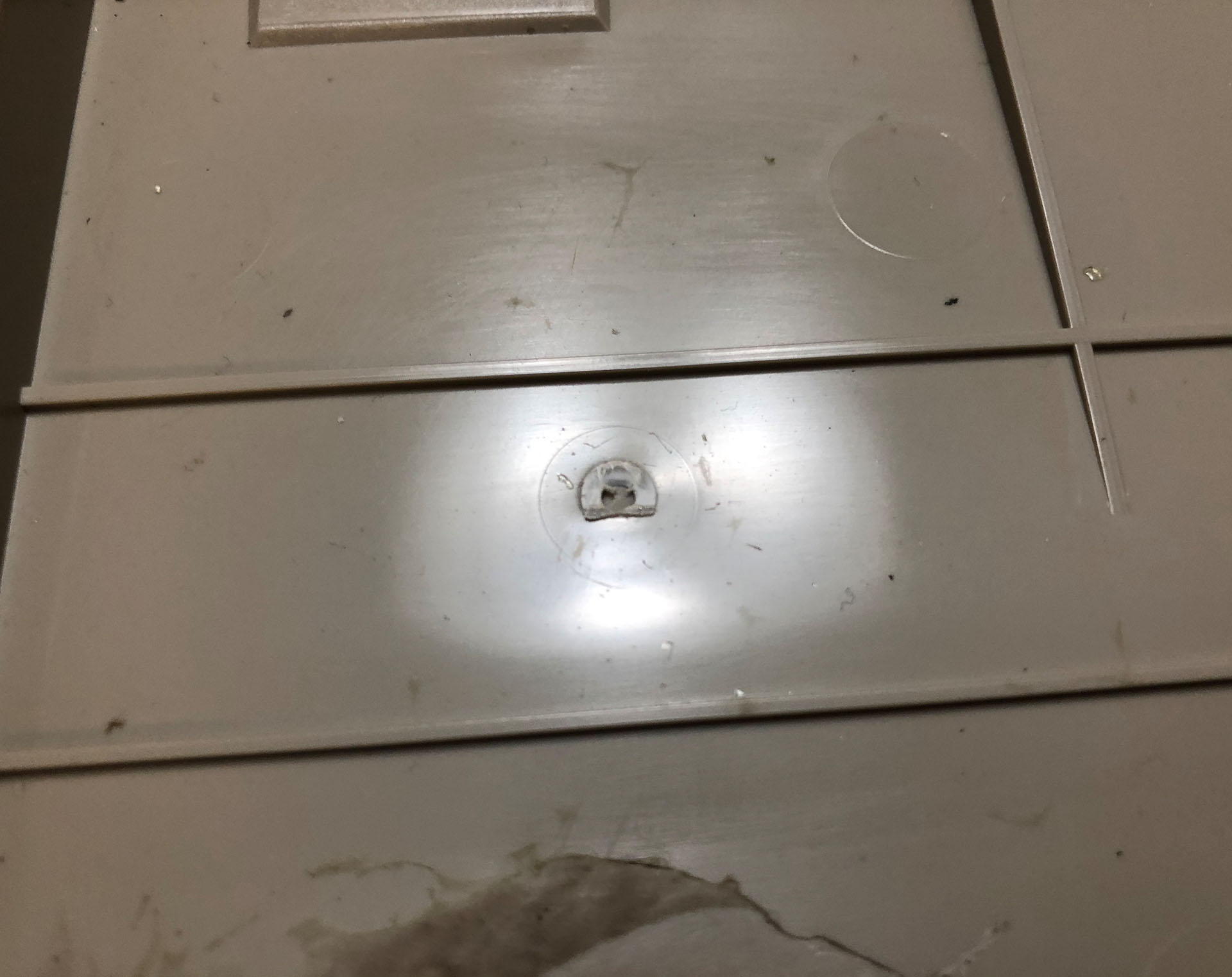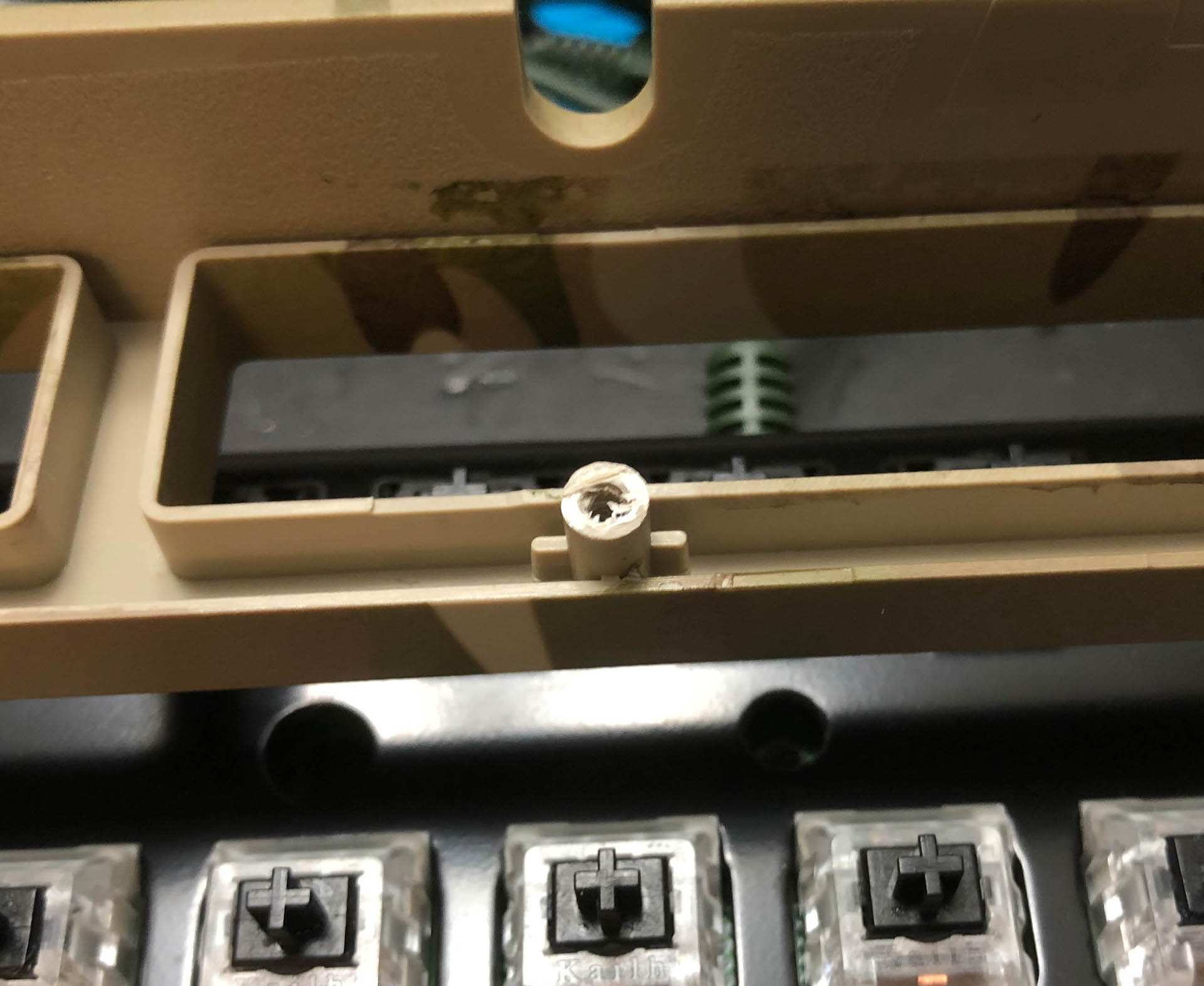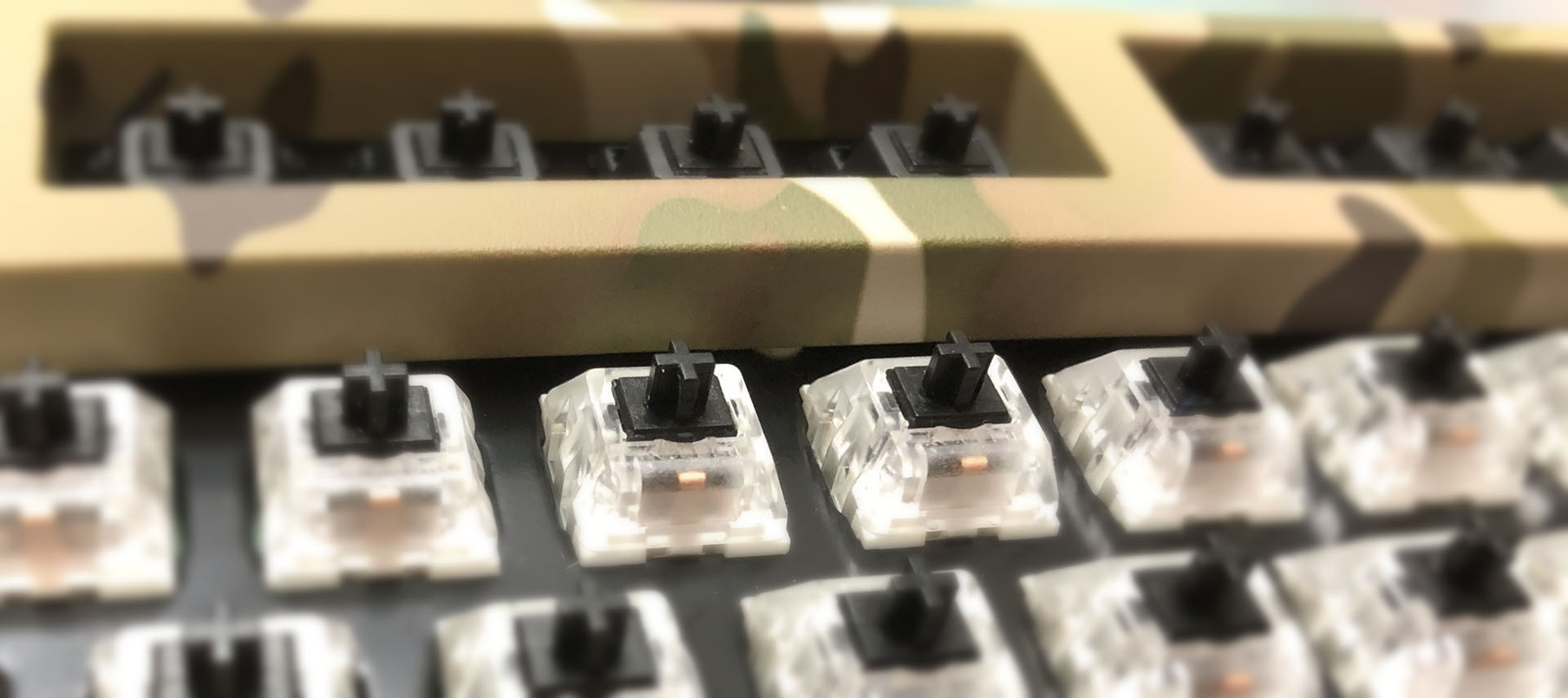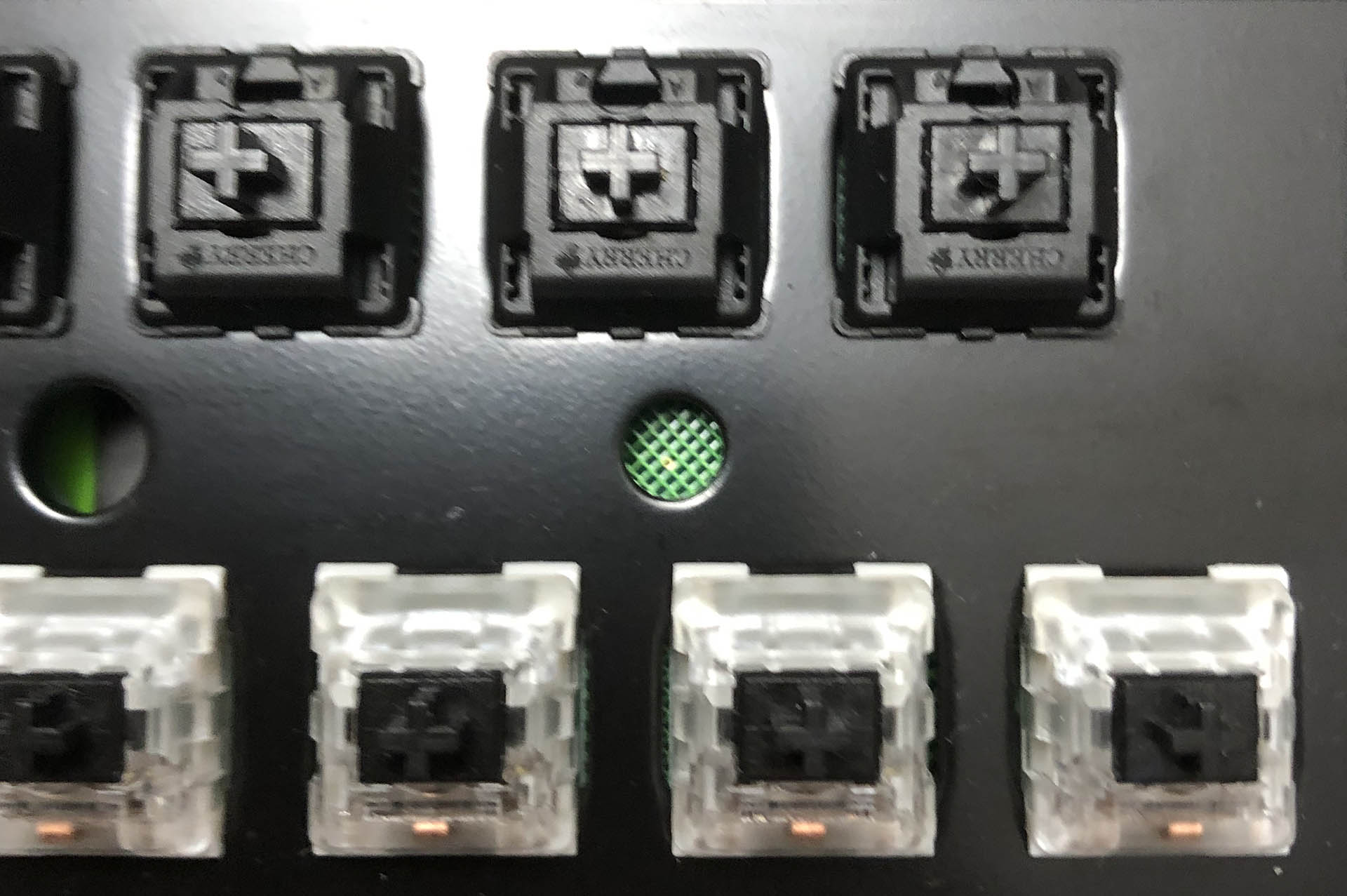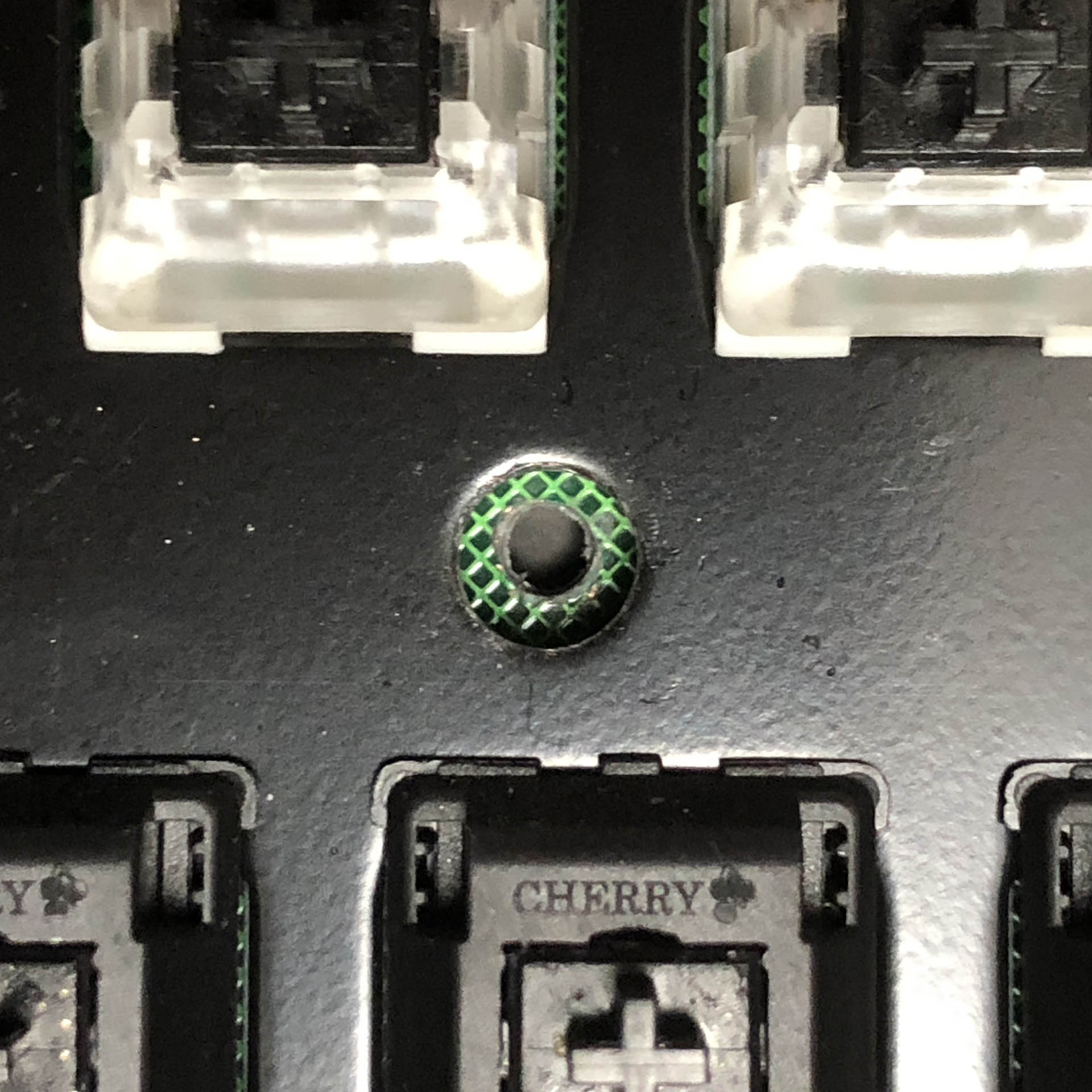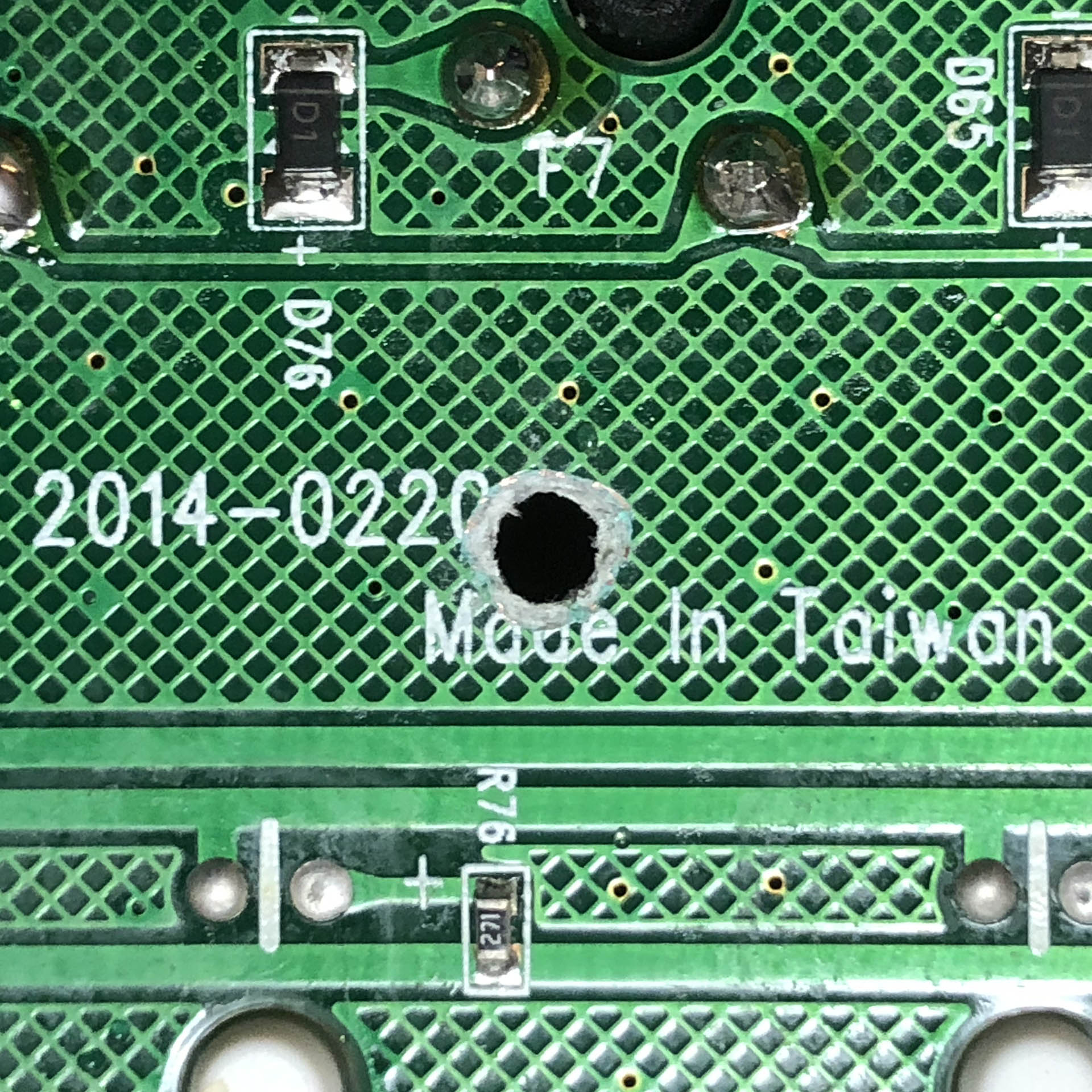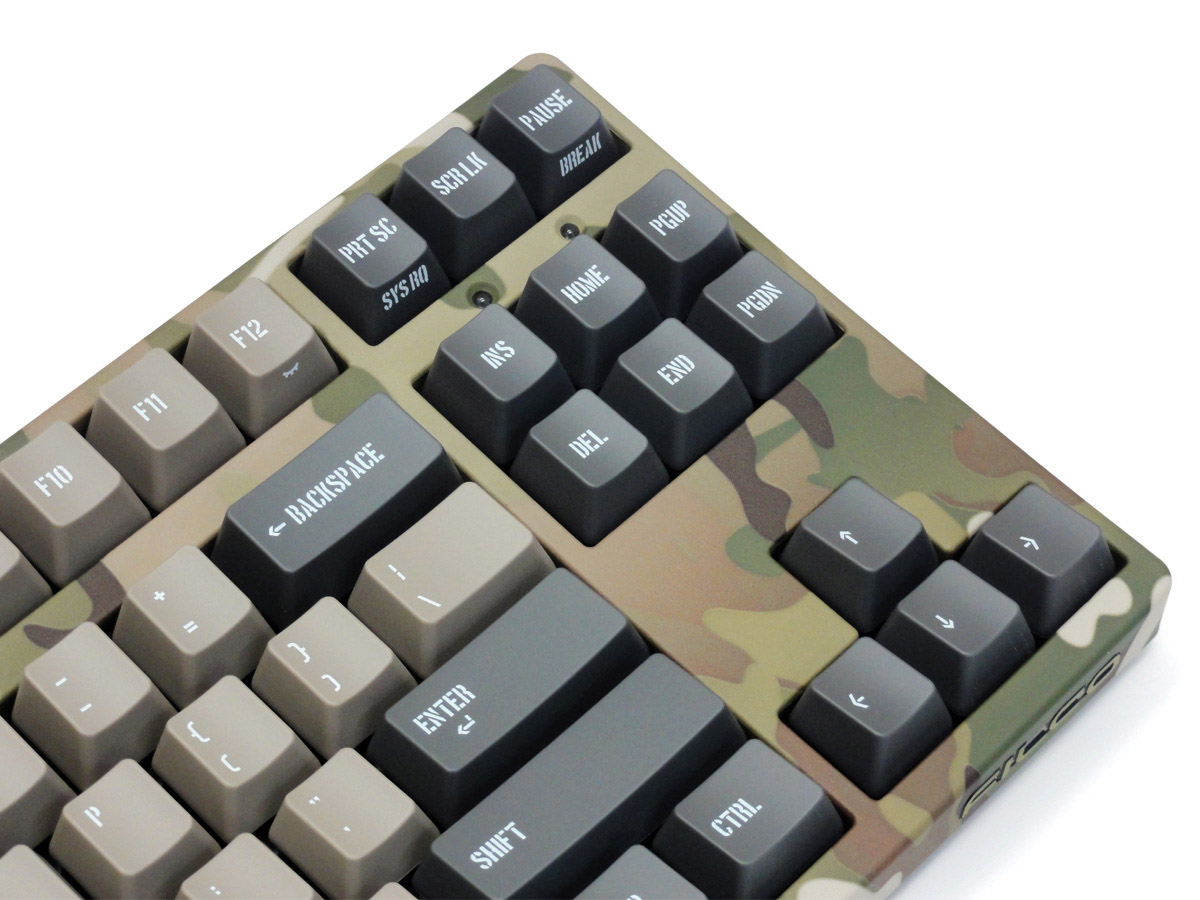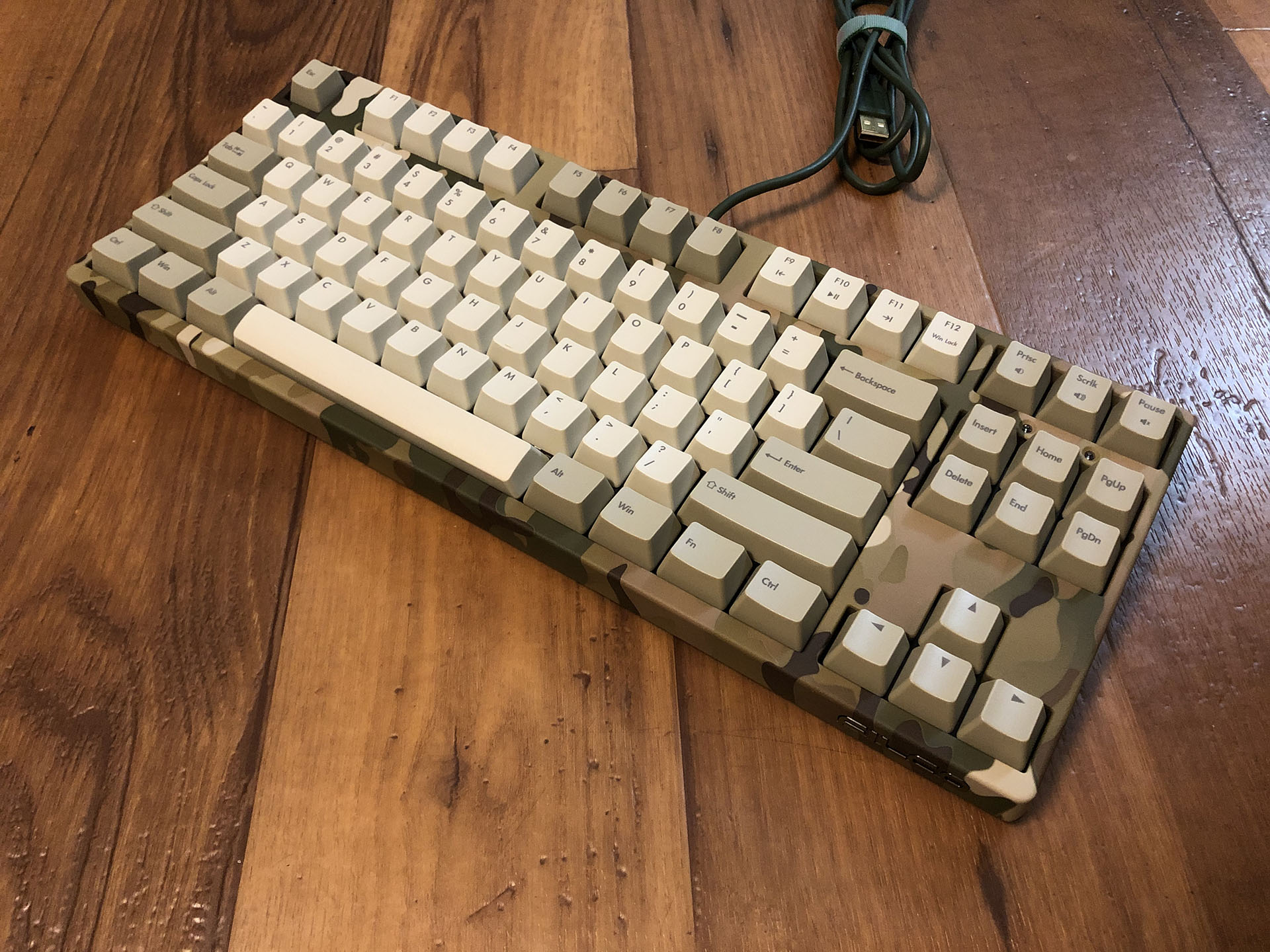Who is This For ep. 1 • Xinmeng X9VR Keyboard & Mouse Bundle
Word-up: All the links in this article are affiliate ones that I only want you to use if you’re genuinely curious about or interested in what’s behind them. Disclosures and formalities accounted-for, let’s get right into it!
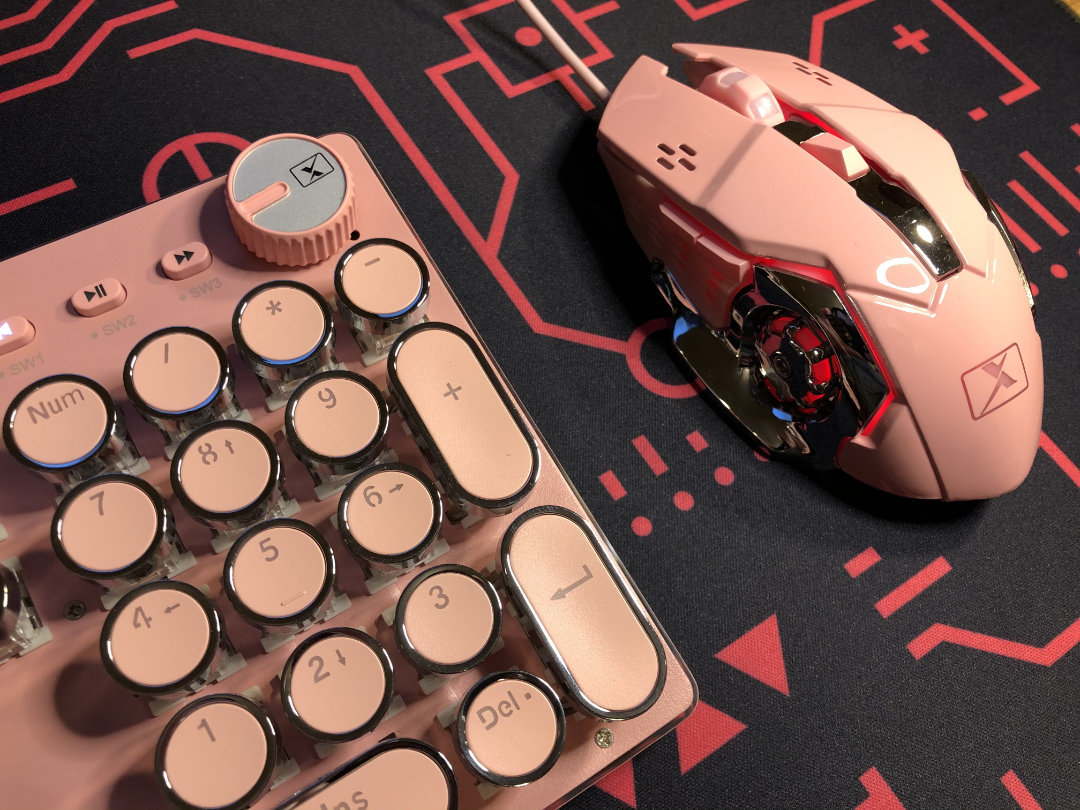
Oh, yeah.
Welcome to the first in my new series of review articles I’ve decided to call Who is This For? – today we’ll be looking at a full-size pre-built mechanical keyboard and mouse bundle, graciously provided for review by MechDIY.com – even after I said they could expect my honest opinion, positive or negative. High-five for being a good sport! I’ve spent a bit over a week with the pink peripherals as daily-drivers, and I’m happy to share my thoughts about them.
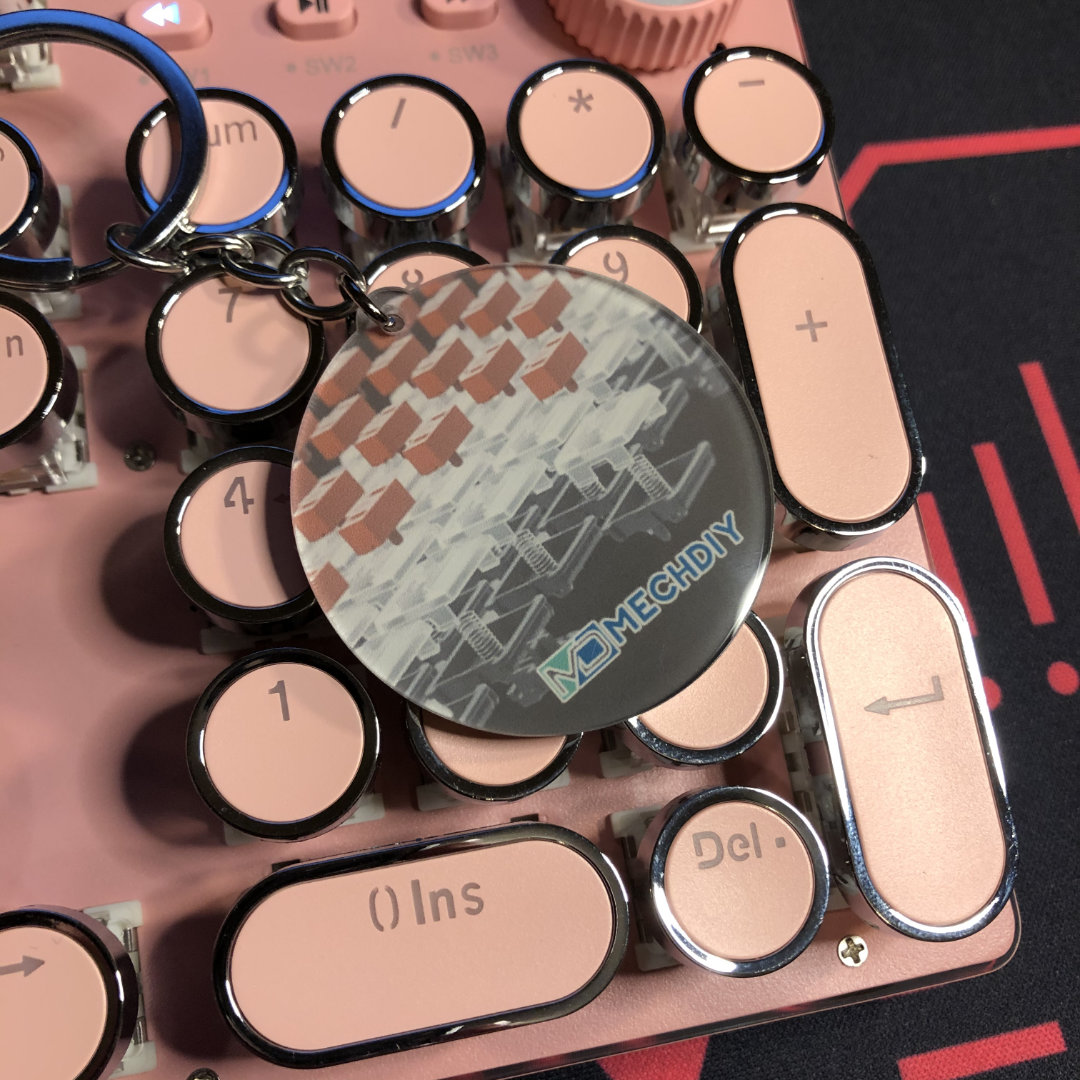
A neat little promo keychain, showcasing some Kailh Chocs. Thanks again to MechDIY, today’s enablers – er, sponsors!
I’m going to take a look at the mouse first, since this is a keyboard focused website, and I have quite a bit more to say about that part of the package.
The Mouse:
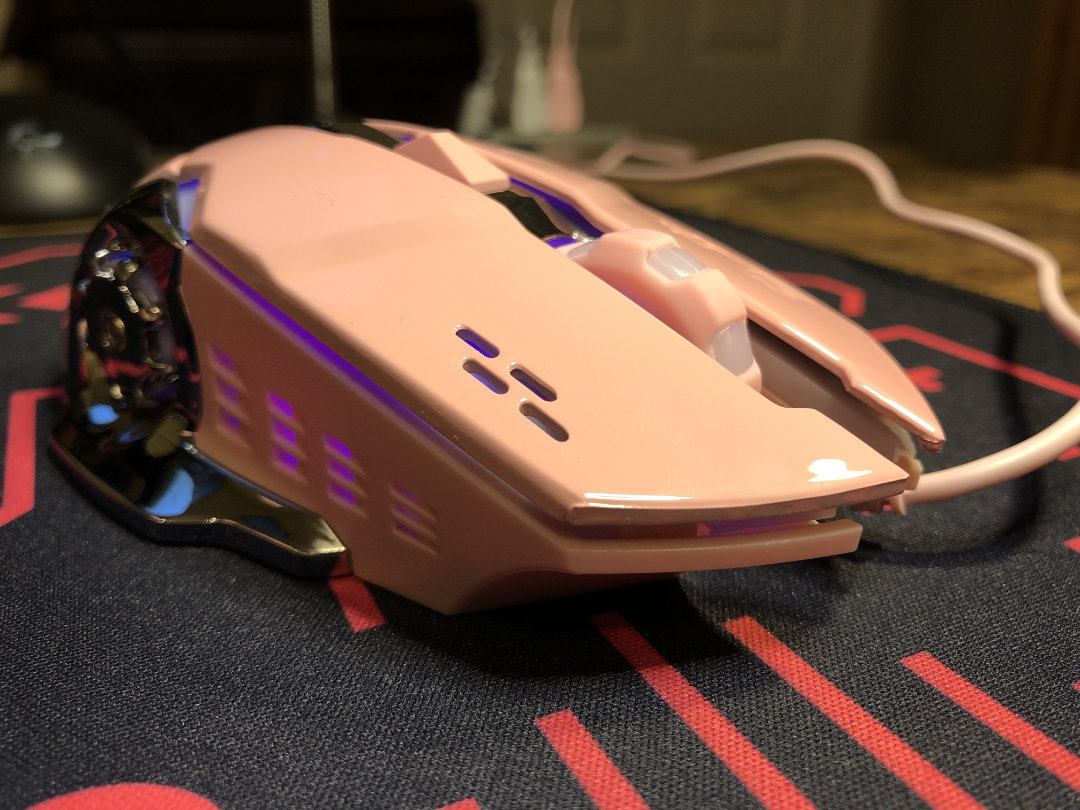
Autobots, roll out! …to the nail salon!
For a pack-in, it’s surprisingly suitable as a gaming mouse. The aesthetic is a mashup of Michael Bay and Mary Kay – perfect for D.va mains and the most fabulous Transformers. It has a color-matched cable with a branded USB-A plug and a glossy finish; available in dream-house pink or baby blue. It also has a readily accessible DPI switch right behind the scroll wheel, which itself is just as stylized as the rest of the mouse.
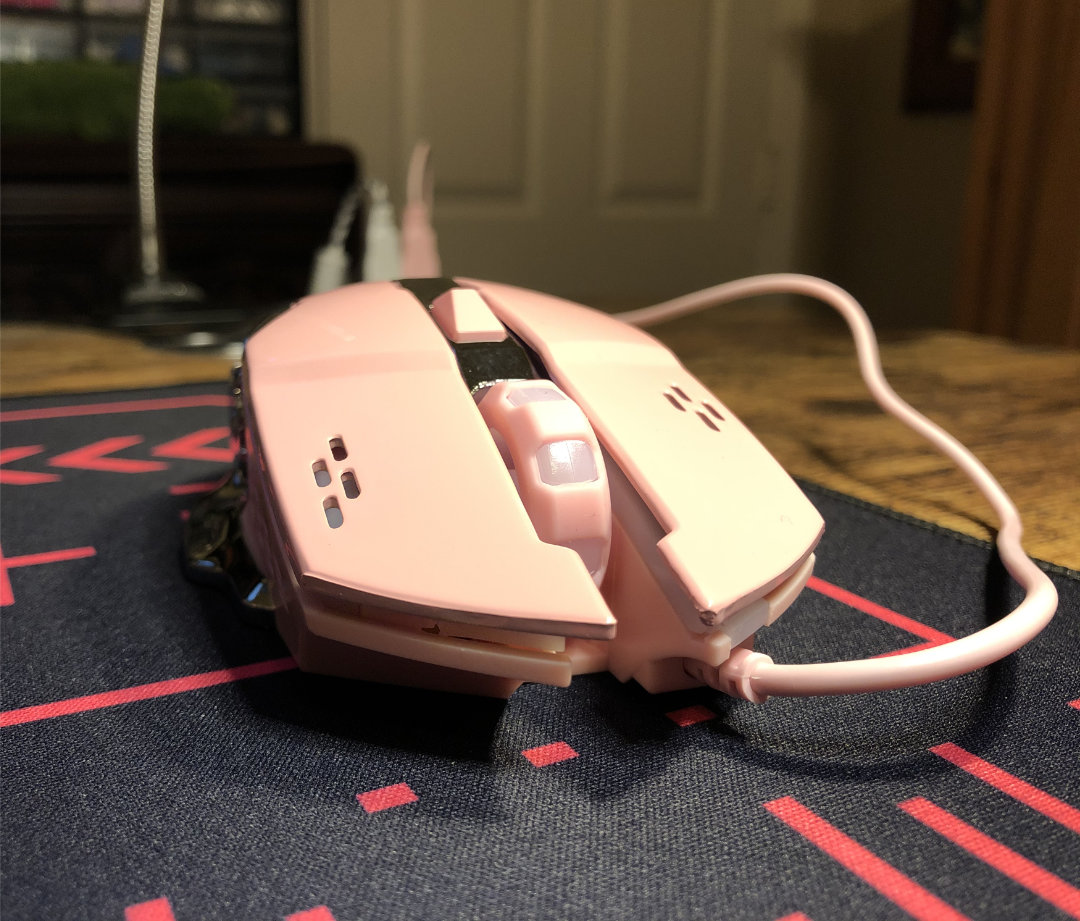
The wheel might be the highlight of this mouse.
Speaking of scroll wheels, this one is quite nice. It has plenty of texture with raised rubber covering the plastic in alternating ridges. The wheel has mild but clear indexing as it turns. It’s easy to scroll with being a nice, large wheel with just enough resistance. The middle-click is crisp, but not harsh, and the same is true of the right and left buttons. If you’ve ever used Kailh’s red gaming mouse switches, these are decidedly more gentle.
There are forward and back buttons to the side; the travel is a little springy, but actuation is crisp. The buttons stick out plenty to feel them, and they are close together – the value of which comes down to preference. For comparison, my Ducky Secret M is also a 5-button mouse, but its forward and back buttons are farther apart, and shaped differently from each-other. On the Xinmeng, the two buttons are one shape, split down the middle. This makes the forward button more quickly accessible, but perhaps easier to mistake for the rearward one.
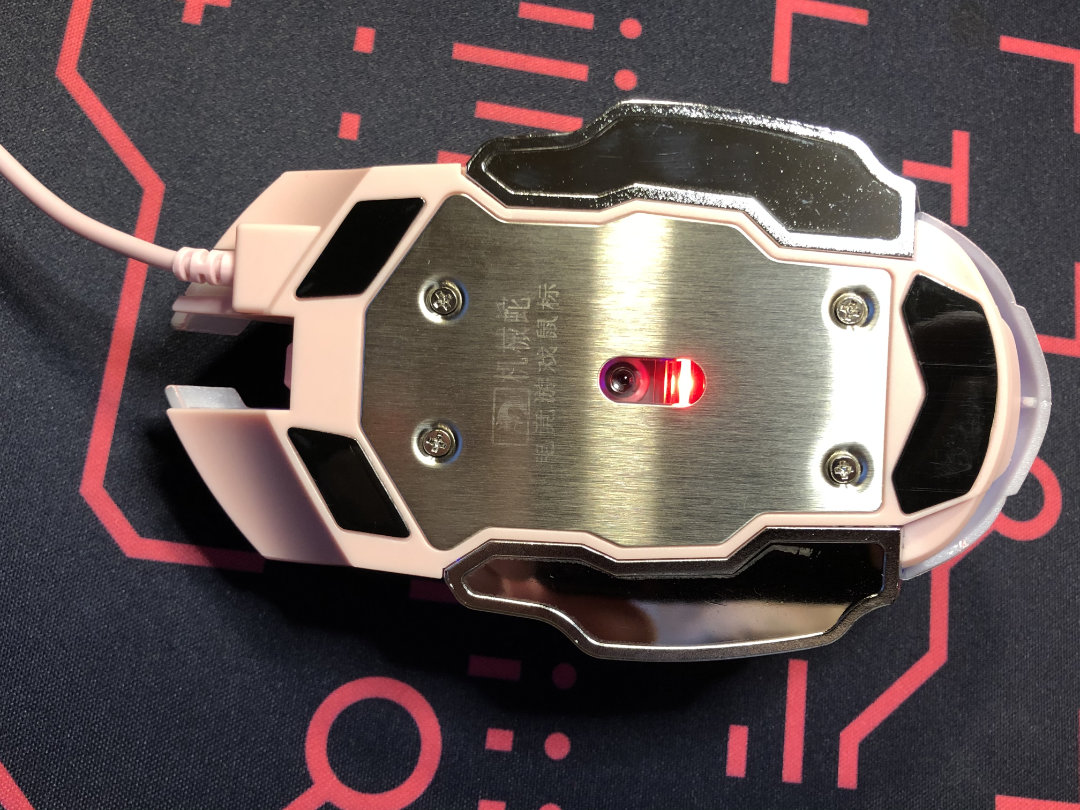
I let out a small guffaw when I saw the bottom of this mouse – maybe I just didn’t expect to see material overkill here.
It has a good weight towards the bottom thanks to a metal plate. There are wide winglets at the bottom your fingers can rest on, and it has at least an ergonomically-inspired, ambidextrous shape. The forward and back buttons are only on the left, though.
I figured this thing for a party favor, but honestly, I quite like it. Don’t get me wrong – I think its hideous – but it feels nice to use. I’m sure the skates are cheap, but they work well enough. It may not be competitive equipment by any stretch – but it’s a better mouse for gaming than plenty I’ve used.
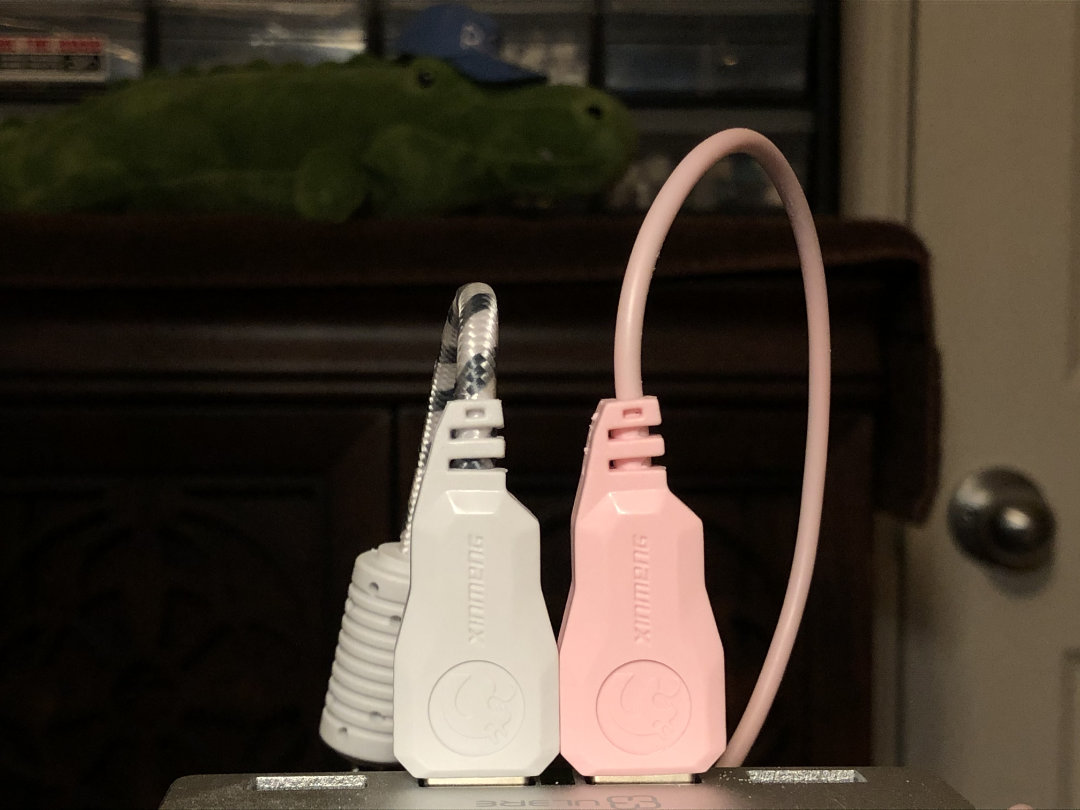
The USB ends for each peripheral are branded and match in shape, but not color; the keeb has the white one with the striped braided cable.
While the keyboard was easy enough to feel-around, and did come with a limited manual, the mouse didn’t have one – and I so far haven’t found one online. I figured out how to turn the RGB rainbow demo on and off, so far that’s it. Holding the DPI button will toggle the lighting. Seems there would be some kind of control if it has RGB capability, but I haven’t found it yet.
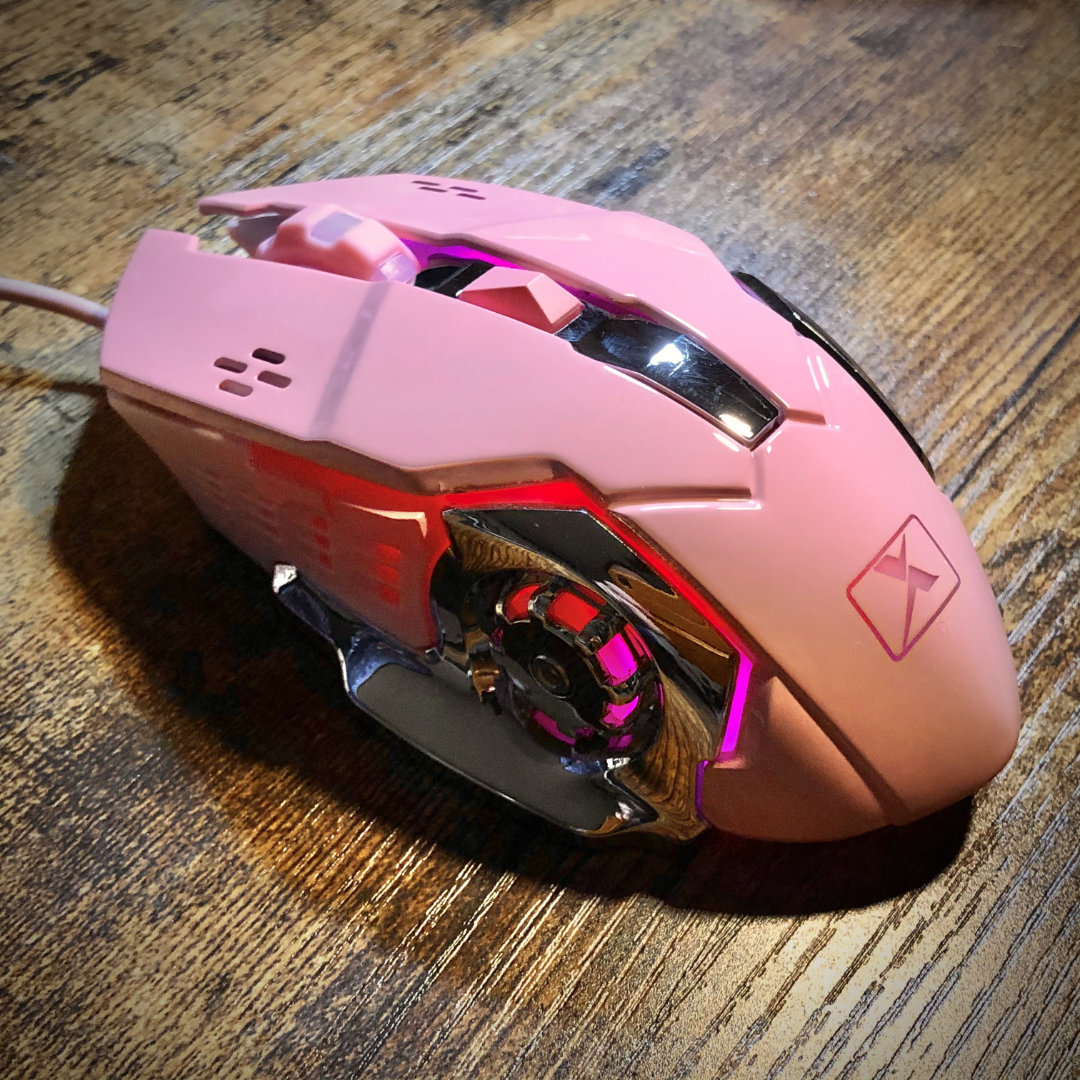
It won’t make you a champion, but it’ll get the job done.
To sum it up, this is a perfectly good mouse that matches the keyboard in color and no other way whatsoever. The aesthetic styling is about as far apart between the two as it could be, but at least they are color-coordinated.
Now that we have that mildly-curious pack-in covered, let’s take a look at this keyboard.
The Keeb:
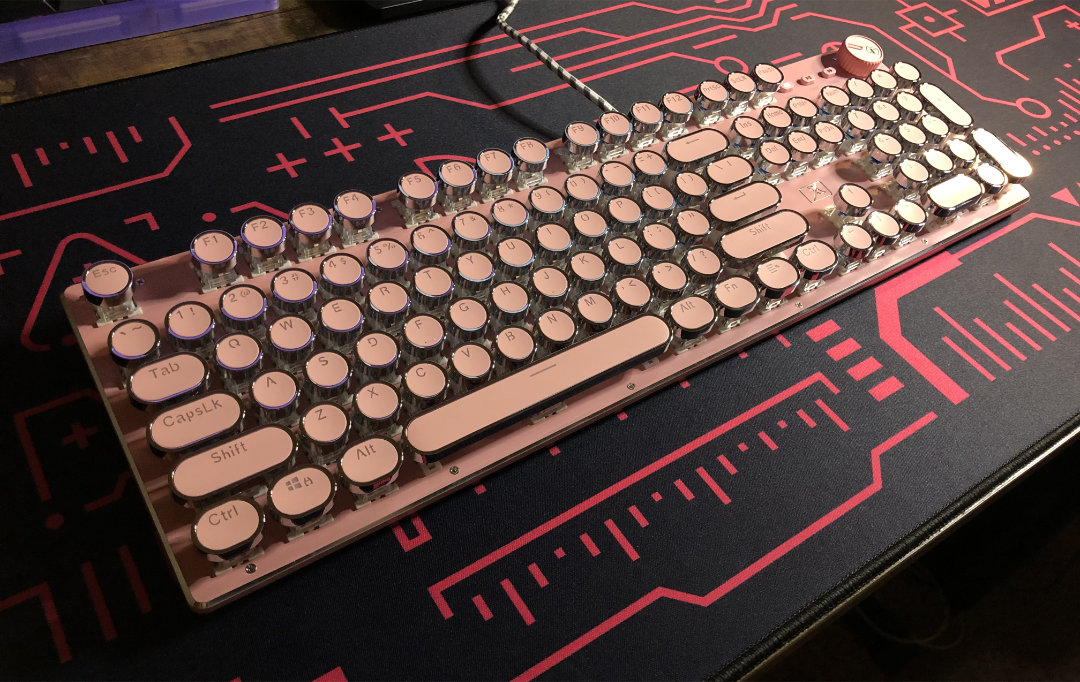
Were you born in the wrong decade but can’t leave behind your all pink everything? This one’s here for you, baby.
Intro & Aesthetic Impressions
Obvious stuff out of the way first, what we have here is a full-size layout with three media buttons and a knob-with-clicker. The switches have the LED slot facing North, and have white SMD LEDs underneath, driven by a wide array of select-able effects. The knob can be switched between two modes, one of which controls the lighting, with the other controlling volume and other media functions. More on that a bit later.
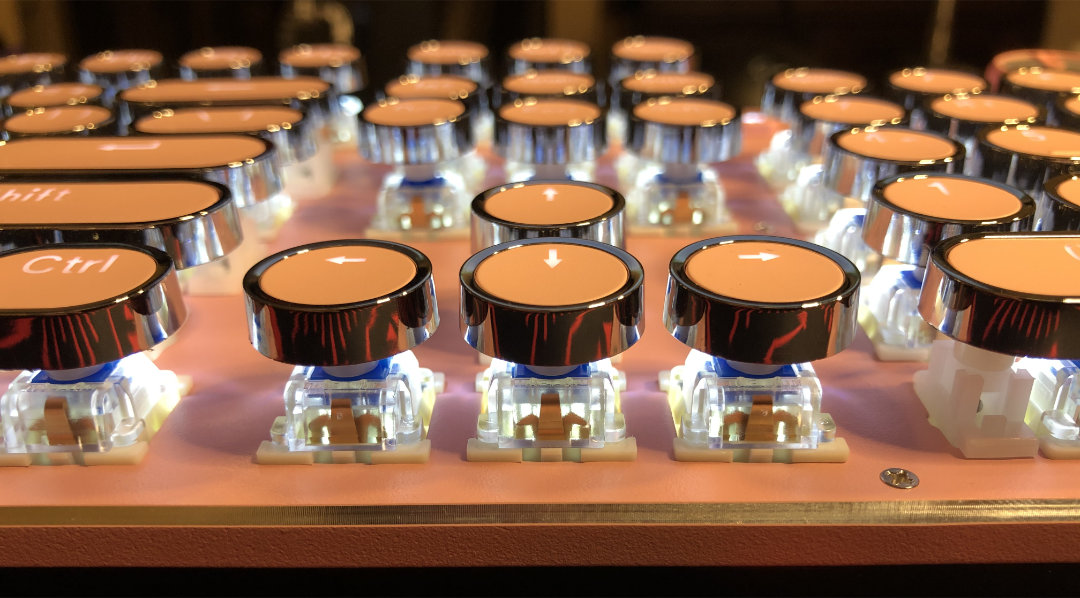
Shiny. Clicky. Pink.
The defining quality of this board is its aesthetics; 2010’s tech with a *heavy* coat of Art Deco filtered through Mary Kay with a spritz of kawaii. Ye-olde type-writer style keys in a uniform profile with circular and pill-shaped footprints. A flat* top shell that doubles as a mounting plate, making for an out-board mounted look for the switches – I think this is actually an appropriate choice for the aesthetic, if it was a conscious choice.
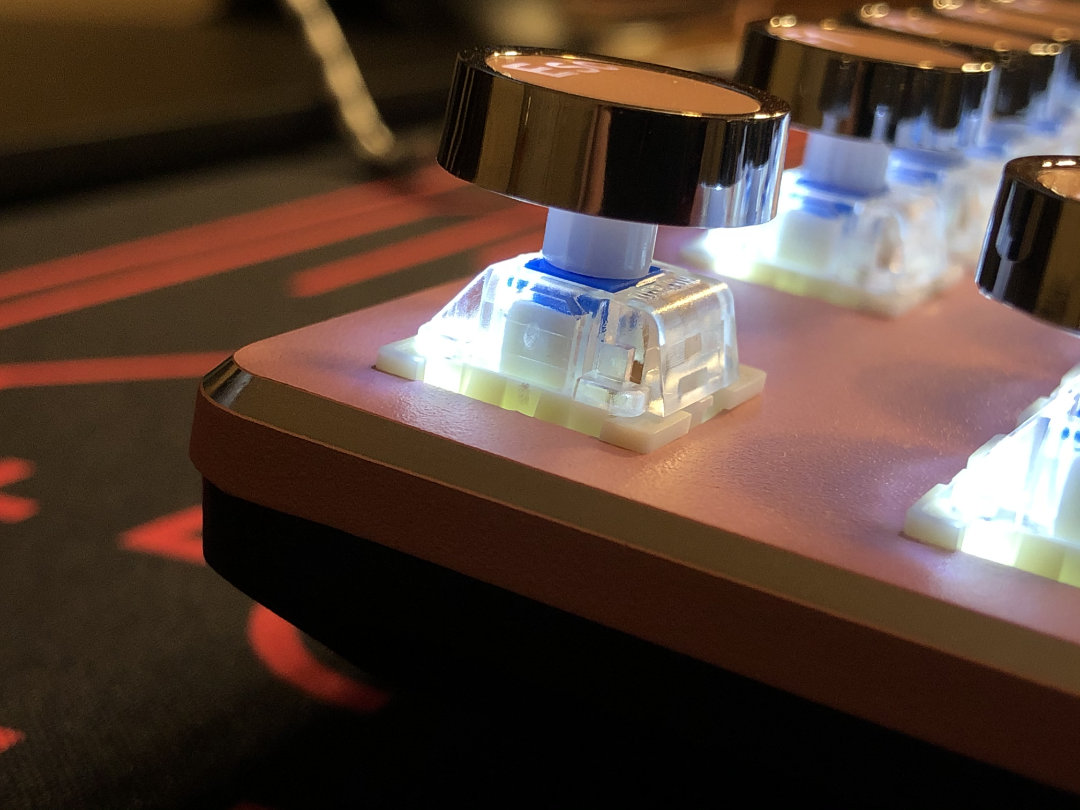
The crunchy workhorse, Outemu Blue – topped with a very shiny hat.
Overall the keeb’s frame is quite thin, with a fairly flat plastic bottom shell. While this keeb basically looks like a pink GMMK with a knob, it’s quite a bit more flexible than one. *In fact, it looks like this particular one has a curve to it, with more of a bend on one side. I’m guessing this happened at least in some part during shipping. I’ll take a shot at flattening it back out.
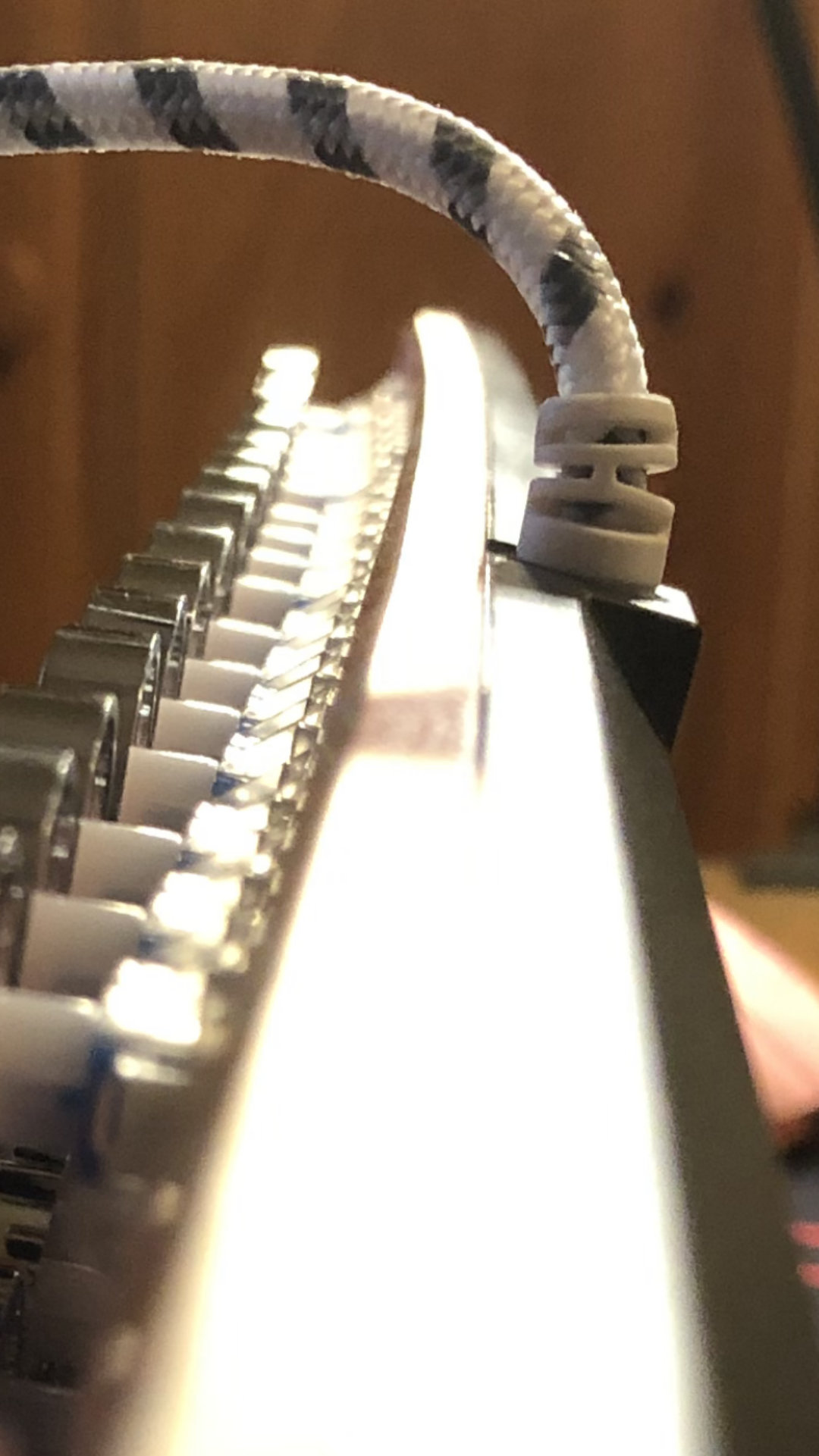
A trip through the postal system is not for the faint of heart, or frail of frame.
Bridging into the subject of functionality from aesthetics, this keeb also has per-switch back-lighting, accomplished with surface-mounted LEDs. All of the lights (including the lock indicators) are a cool white. With the shiny silver rings of the stock keys, this makes for a fairly dazzling display. This would look right at home on the desk of a beautician or kawaii-aesthetic streamer, and brings to mind images of makeup and vanity mirrors as much as vintage typewriters.
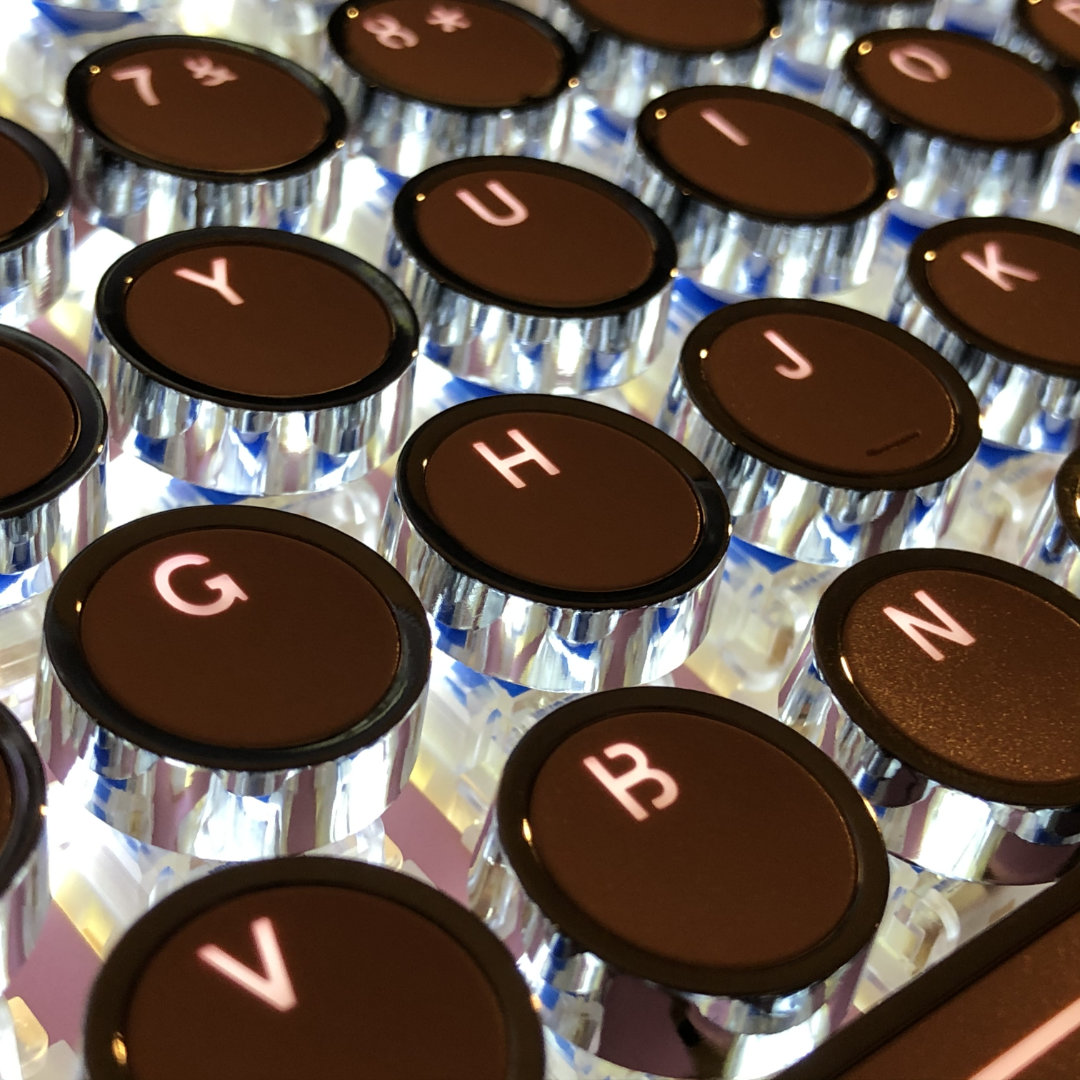
It is pretty fabulous.
So – aesthetically speaking, who is this for?
I’d say, those aforementioned fans of kawaii and steam-punky retro seeking a keyboard to match the look of their lifestyle.
It most definitely is not for any keyboard enthusiast – unless they collect that sort of thing, or are writing a review like this one. By nature of this being a keeb community article, I’m sure at least a few of you are having a cheeky giggle at the sight of this thing – there’s more for you when we get to the sound – but this is a genuinely cool product for some folks. My sister, for example – she’s a Harley ridin’ Mustang drivin’ skip-second-gear kinda lady – and her first words upon seeing this keyboard were,

She meant it, too. I agreed to let her take the keys when I install different ones for the follow-up. Awesomely-bad word-art courtesy of cooltext.com.
I think it’s this dichotomy of love-it-or-hate-it that makes this keeb a perfect candidate to kick-off this series. Onward!
Functions:
Aside from the keys and the color, the most noticeable thing about this keeb is the inclusion of a knob in the top-right corner. To the left of the knob are three multi-function buttons that also double as lock-light indicators. Between the broken English in the manual and just playing around, I was able to familiarize myself with the functions in a few minutes. Here’s how it works:
The cluster has two modes; lighting control and media control. Long-pressing the knob switches between the two modes, which are indicated by a pair of white LEDs around the top-left and bottom-right of the knob. When the lights are illuminated, the cluster is in lighting control mode, and when the lights are off it is in media control mode.
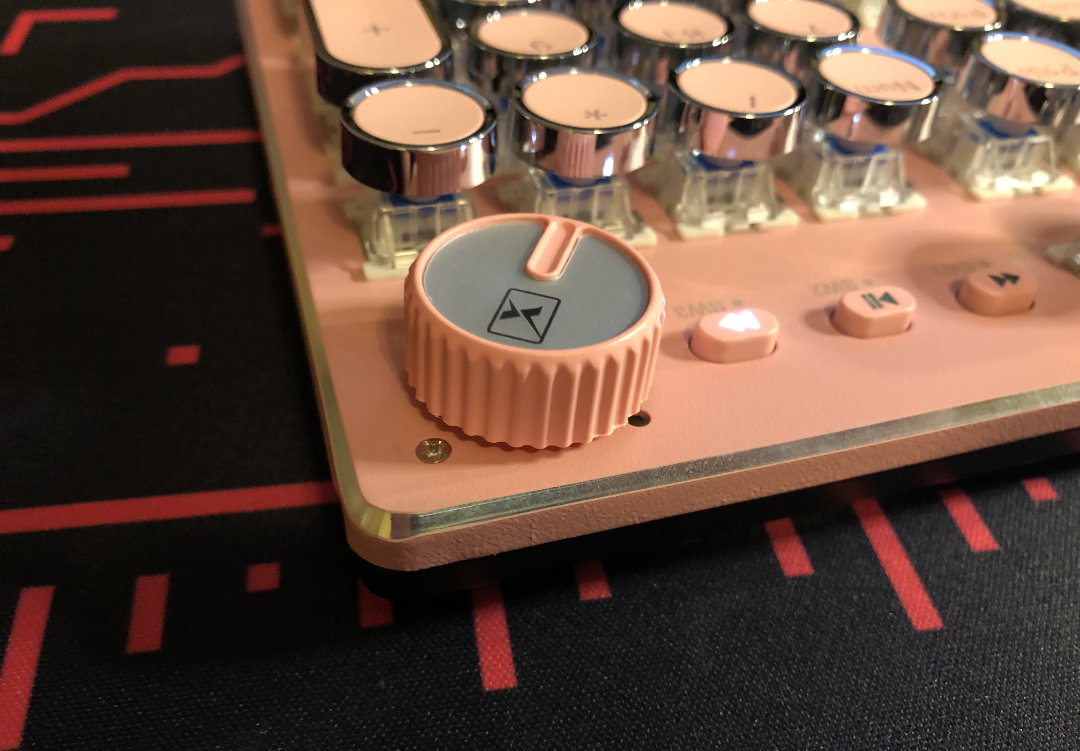
IT’S GOTTA GNAWB, BREAU, (deuude)
In lighting control mode, turning the knob adjusts the lighting brightness, and quick-pressing it cycles through lighting animations. Tapping each of the three buttons to the left will select one of three pre-set lighting configurations.
In media control mode, turning the knob adjusts the volume, and quick-pressing it mutes and un-mutes the sound. In media control mode, the three buttons to the left have the media functions labeled on them; ⏮ for previous, ⏯ for play / pause, and ⏭ for next. If you have a media player open, these controls will likely work with it.
In either control mode, the LEDs under each of the three buttons are lock-light indicators: the left ⏮ button indicates Number Lock, the middle ⏯ button indicates Caps Lock, and the right ⏭ button indicates Scroll Lock.
In combination with other keys, the FN key also controls both media and lighting functions as well as a Windows-key lock for those high-stakes gaming sessions.
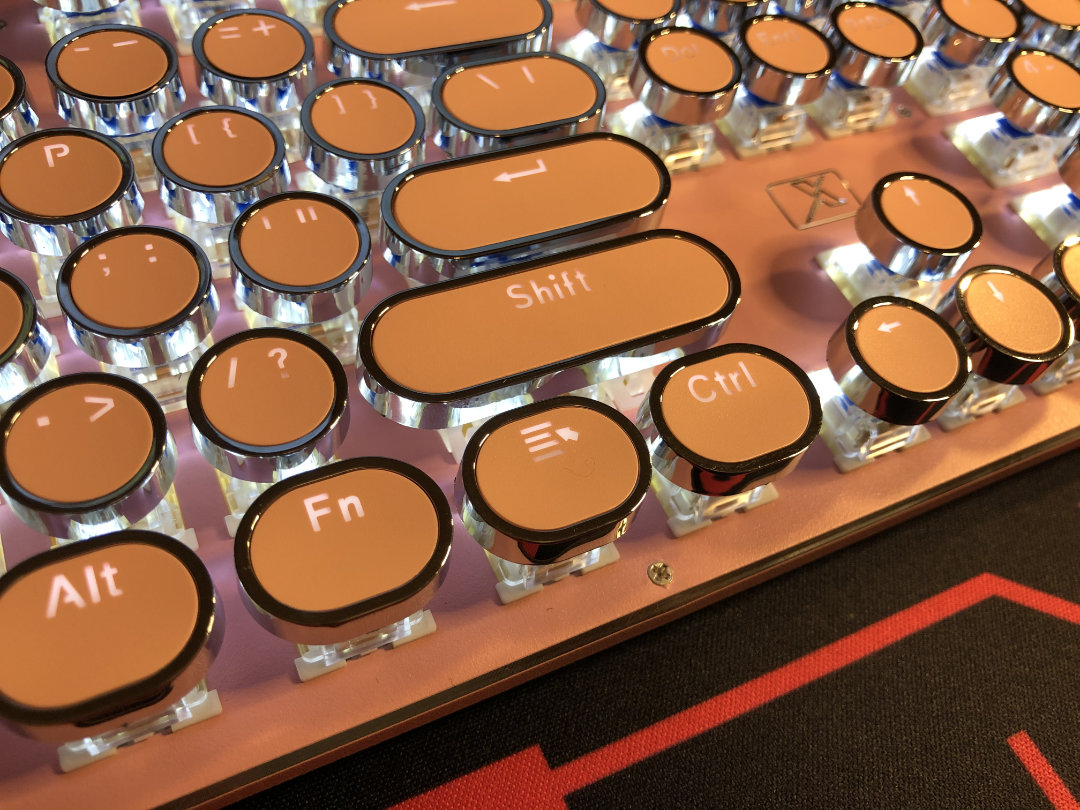
That’s the FN (or function layer) key, between the right Alt and Menu keys.
Under the umbrella of functionality, let’s get into who this keyboard will be useful for, which gets its own little section:
Use-cases:
- Typing: Not the best, but plenty functional and even satisfying if you don’t mind lots of sound.
- Gaming: Just fine for solo casual fun, but not great for voice-chat and definitely not for competition.
- Display: Potentially awesome; as part of an ensemble, this keeb could be the missing piece of kit.
Sound:
Sound is going to be a polarizing feature of this one; I’d put it comfortably in the “love it or hate it” category, alongside the aesthetics.
I think it sounds like a family of gnomes, clogging atop corn-flakes in the bowl of a small steel drum. Have a listen:
This is a clicky-switch board, which I’d say fits given the typewriter-inspired keycaps. In fact, this keeb does sound remarkably similar to an old mechanical typewriter, which Cherry Blues and their cousins were originally designed to emulate. In that way, I’d call the sound of this board successful. Overall, it’s crunchy and noisy, but far from the loudest keyboard I’ve ever used.
There’s also quite a bit of ping and ring to the sound of this keeb. In terms of the typewriter theming, I’d say this is alright – and its at least vaguely reminiscent of venerable vintage mechanical keyboards like the IBM Model M when it comes to the ring. Enthusiasts of today have honed-in on tuning the sound, but back then keyboard users might lament that the thing isn’t loud enough – some keyboards of the day even had little electric hammers inside to slap the case – to make typists migrating from typewriters more comfortable, of course. While the keys of the X9VR are significantly lighter in weight than any mechanical (read: un-powered) typewriter, it still does a surprisingly good job of giving the user a typewriter-like experience.
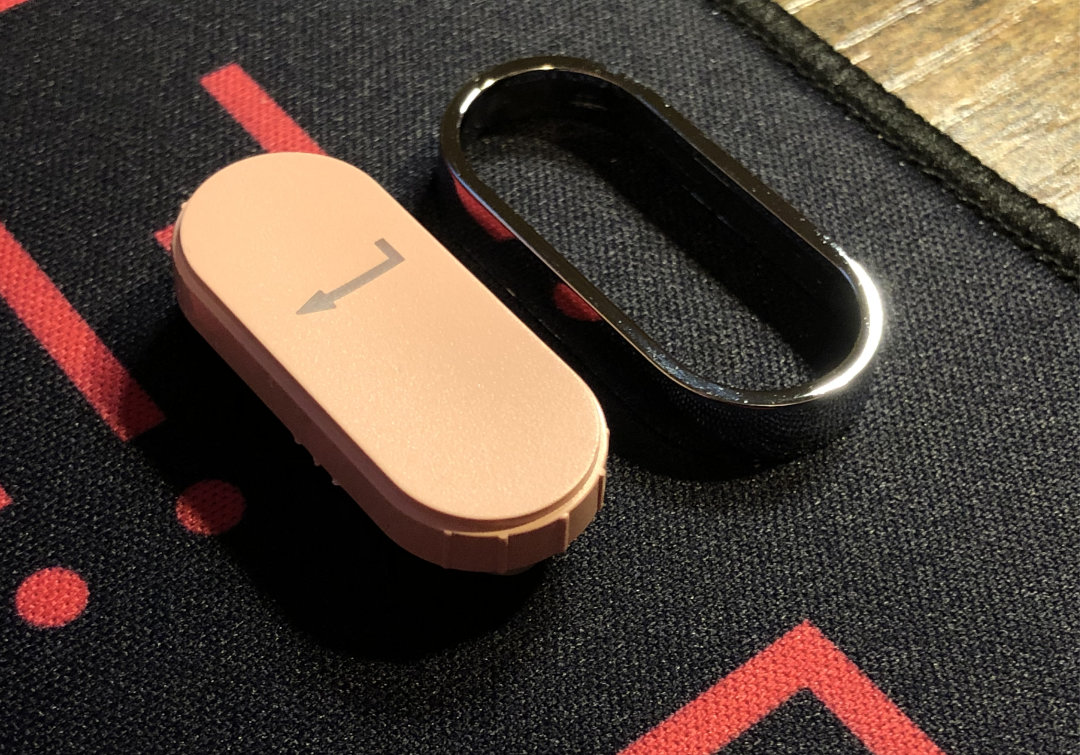
This has nothing to do with sound but the rings are friction-fit and removable. Isn’t that neat?
Now, when it comes to the enthusiast community, I don’t think any one of them would be interested in this board from a sound or feel perspective. It uses click-jacket clone blues, which tend to be at the very bottom of a custom keeb builder’s switch list. The stabilizers rattle like a bag of small dry bones. What would really make an enthusiast wince, though, is that PING. This might be the most pingy mx-compatible keyboard I’ve ever used, and that’s something of an accomplishment. This goes right past “that’s kinda pingy” and comfortably into “is that a buckling spring keeb?” territory.
So – when it comes to sound, who is this keyboard for? Well – all that stuff I just mentioned means folks looking for a clean sound won’t even want to be in the same room as this thing – but folks who really love the retro aesthetic and the sound that comes with it will have nothing but fun using the X9VR.
Stay tuned for my follow-up video where I take-on the challenge of tuning this keyboard for, among other things, sound.
Feel:
There’s not a whole lot to say about feel here – it’s a clone blue board, and it feels like one. It’s pretty light. Between the lack of rubber on the flip-out feet and the bend in this one’s case, it won’t stay put on a hard surface. On a deskmat, though, it does just fine. I’ve used the X9VR to write the majority of this review.
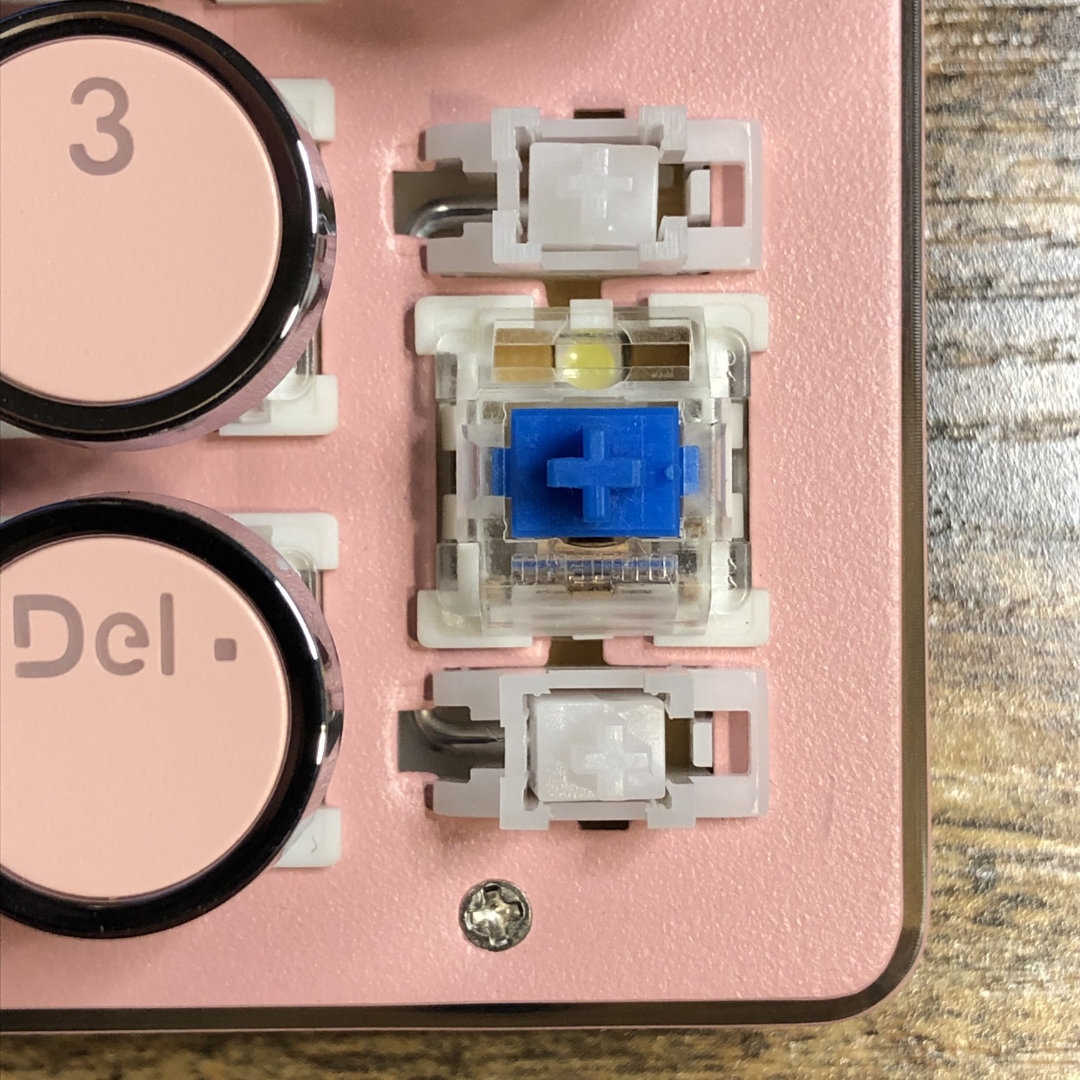
Outemu blues, rando stabs. Nothing fancy, but gets it done.
If you’ve never used a “blue” switch before, “blue” comes from Cherry’s original color-coding for their first clicky switch. Many other manufacturers follow the same color-coding conventions that they do, though with the advent of color-coordinating with switches this is becoming less common. Blues in general have a satisfying “tactile event” just before actuating – at least, I found it really satisfying before I spoiled myself with hand-lubed switches – but that’s another topic altogether. Suffice to say that if you’re typing on the thing that came with your Dell and wish it was a bit more crisp, you might really appreciate some blues like the ones populating this keeb.
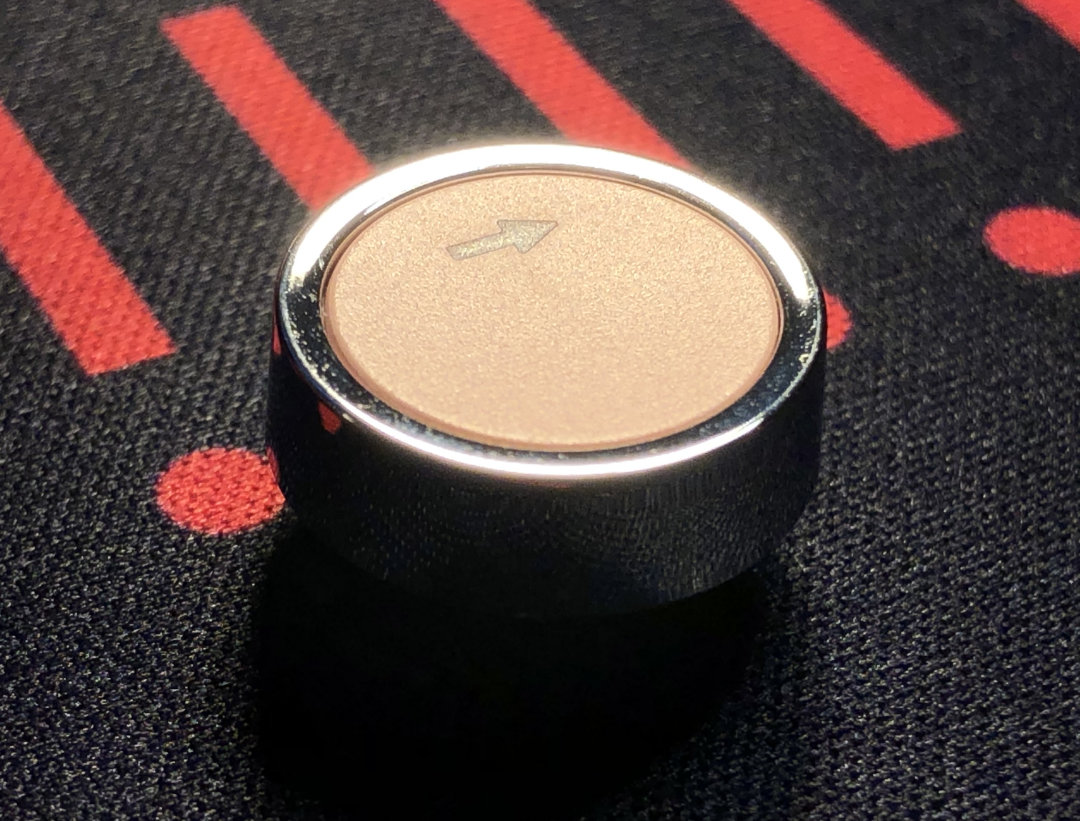
A close look at one of the MX-mount vintage-typewriter-inspired keys.
Probably the most unique aspect of this keeb’s haptics would be the keys themselves. While they’ve been around for some time and are easy to find if you’re looking for them, these typewriter style keys aren’t exactly super common, so most keeb enjoyers probably haven’t tried them yet. I can tell you that I find them surprisingly more usable than I expected them to be when it comes to touch-typing. They have traditional homing nubs, and the rings around each cap actually do a decent job helping ones fingers find their way around. Unlike the drastically angled typewriters that tended to have keys resembling these, this keyboard has a completely flat typing profile, with feet providing an optional angle.
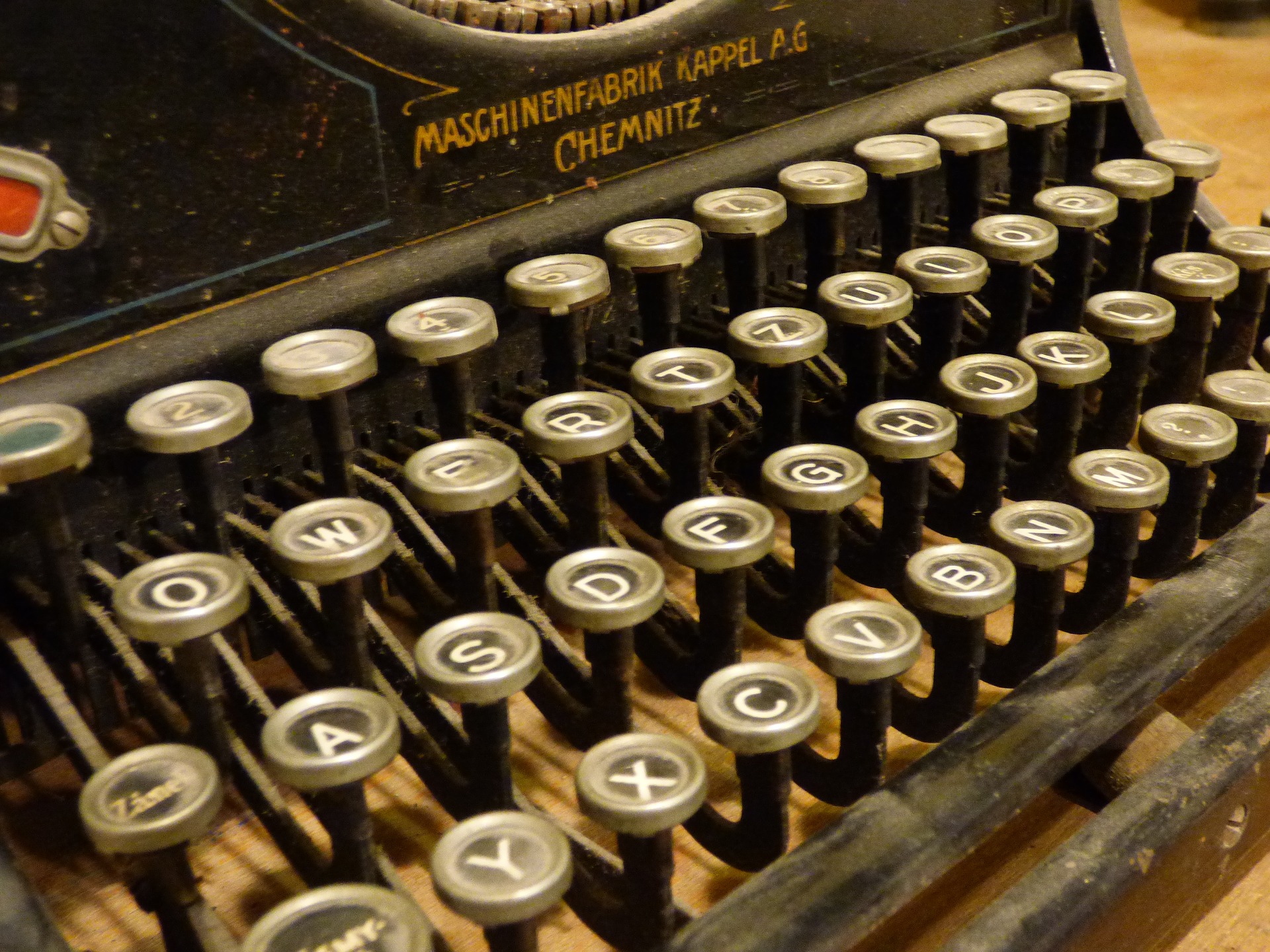
An old QWERTZ typewriter with heavy, lever-action keys and a very steep incline between the rows. At least when it comes to the keys, this is the sort of thing today’s keeb calls-back to. • Photo by Tomasz Mikołajczyk.
So – when it comes to the typing feel, who is this for?
Like with the sound, when it comes to feel this keyboard is here for retro fans. Want to feel like you’re using hand-crafted, stylish, and archaic technology without all that would actually entail? Well – the X9VR might be worth a look for you.
Value & Conclusions:
Priced at eighty American Bacon Shares, this keyboard-and-mouse combo is comfortably less than anything in the custom keyboard universe, but a fair sight more than the cheapest basic gear. I guess this would be a mid-range kit in the prebuilt gaming keeb world – it might be on the expensive side for someone shopping purely for color. For those seeking a full-sized board with the shiny typewriter look in pink (or baby blue), I think this checks enough boxes to be worth the price of admission.
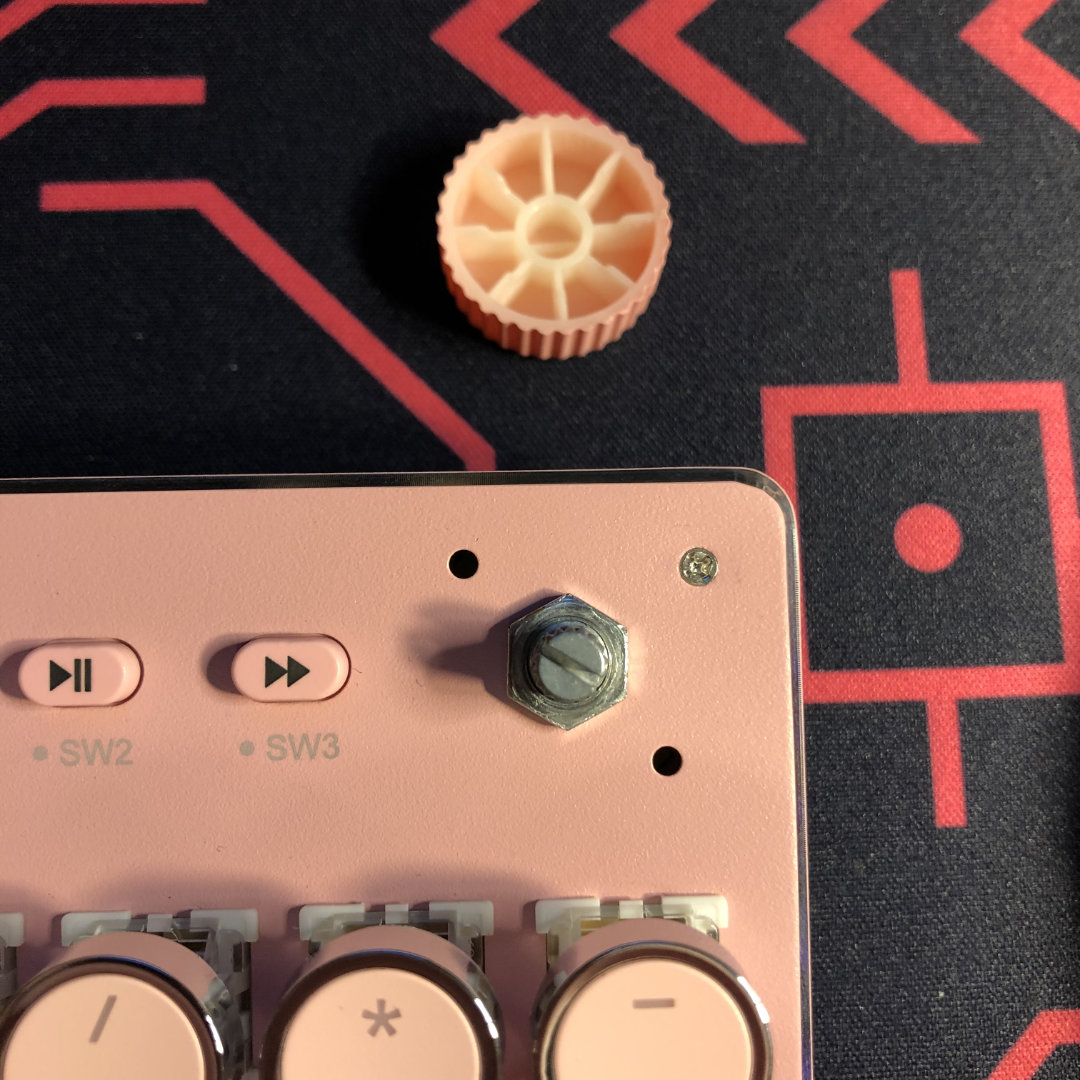
Under the knob – here you can easily see where the mode indicator LEDs are; the two small holes on either side of the rotary encoder.
Recommendations for Improvement:
Were I to try to improve this product on a commercial level, I think the biggest change I’d make would be with the box it ships in – it’s not quite sturdy enough to properly protect the keyboard in transit. While the keyboard is plenty durable for years of use, it didn’t fare that well in shipping. The mouse is good but not a fit for the bundle aesthetically. Beyond that, I would add rubber ends to the flip-out feet of the keyboard, and maybe a multi-lingual reference card for the mouse functions.
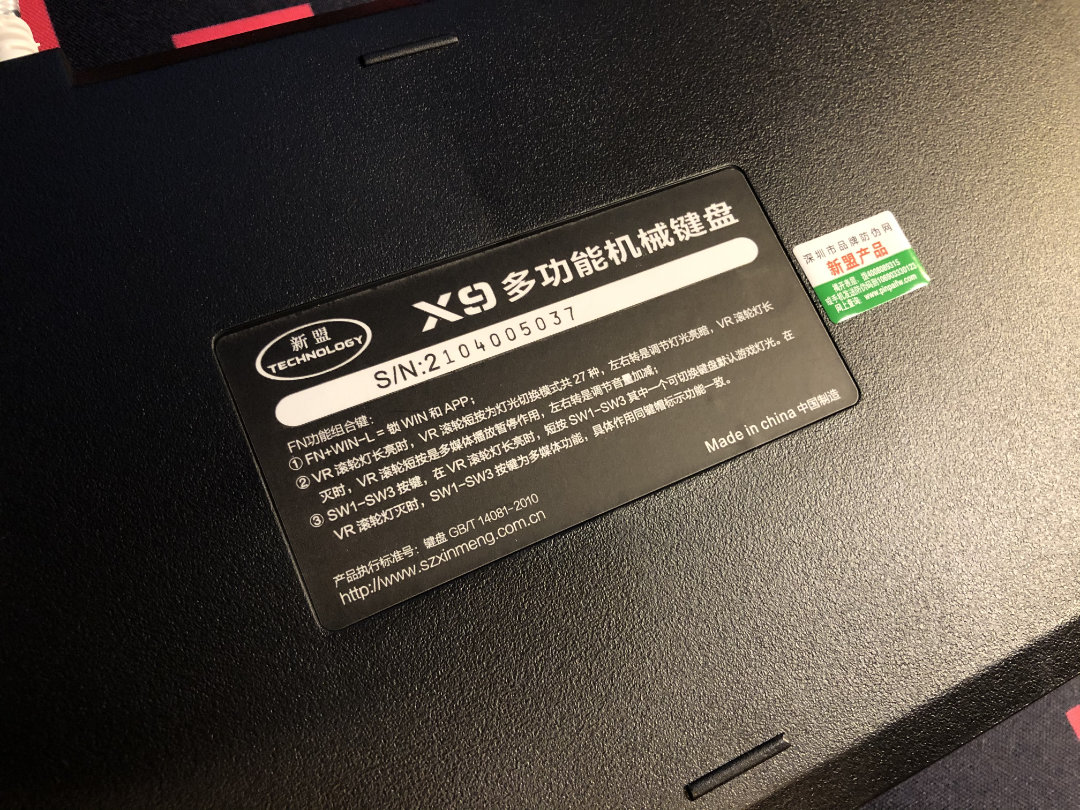
I’d be lying if I said I could read any of this, and full disclosure, I may not even have the name of this product quite right – but I think you got the idea.
This is a section where I’d normally talk about how to improve the sound and feel, but at least for the market this kit appears to be aiming for, I think it does just fine with its crunchy, crispy qualities.
That’s all I have to say about the Xinmeng X9VR keyboard and mouse kit for today. Stay tuned for a follow-up about modding this keyboard. Thanks again to MechDIY.com for providing this keyboard for review, and thank you very much for reading.
Whatever you’re typing on today, remember to enjoy it!



